2-amino-quinoline Derivatives
LI; Lixin ; et al.
U.S. patent application number 16/608581 was filed with the patent office on 2020-02-20 for 2-amino-quinoline derivatives. The applicant listed for this patent is Birdie Biopharmaceuticals, Inc.. Invention is credited to Huiping GUAN, Lixin LI.
| Application Number | 20200055851 16/608581 |
| Document ID | / |
| Family ID | 63918846 |
| Filed Date | 2020-02-20 |










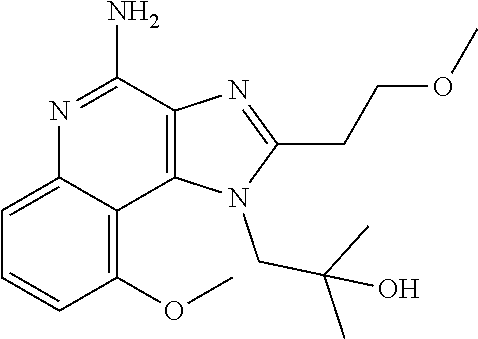
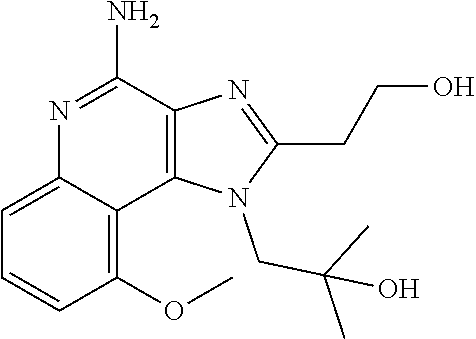
View All Diagrams
| United States Patent Application | 20200055851 |
| Kind Code | A1 |
| LI; Lixin ; et al. | February 20, 2020 |
2-AMINO-QUINOLINE DERIVATIVES
Abstract
Described herein are 2-amino-quinoline derivatives that are agonists of toll-like receptors 7 and 8 (TLR7/8), pharmaceutical compositions, and methods of use of the compounds and compositions to treat various diseases, such as viral, cancer, and allergic diseases, in need thereof by administering a therapeutically effective amount of a 2-amino-quinoline derivative.
| Inventors: | LI; Lixin; (Beijing, CN) ; GUAN; Huiping; (Beijing, CN) | ||||||||||
| Applicant: |
|
||||||||||
|---|---|---|---|---|---|---|---|---|---|---|---|
| Family ID: | 63918846 | ||||||||||
| Appl. No.: | 16/608581 | ||||||||||
| Filed: | April 26, 2018 | ||||||||||
| PCT Filed: | April 26, 2018 | ||||||||||
| PCT NO: | PCT/CN2018/084674 | ||||||||||
| 371 Date: | October 25, 2019 |
| Current U.S. Class: | 1/1 |
| Current CPC Class: | A61P 29/00 20180101; A61P 19/00 20180101; A61P 35/00 20180101; A61P 37/08 20180101; C07D 498/16 20130101; A61P 31/12 20180101; A61P 31/14 20180101; C07D 471/04 20130101 |
| International Class: | C07D 471/04 20060101 C07D471/04; C07D 498/16 20060101 C07D498/16 |
Foreign Application Data
| Date | Code | Application Number |
|---|---|---|
| Apr 27, 2017 | CN | 201710287322.2 |
Claims
1. A compound represented by a formula: ##STR00181## or a salt thereof; wherein a dashed line represents the presence or absence of a bond; A.sup.1 is CR.sup.1, NR.sup.1A, or N; A.sup.2 is CR.sup.2, NR.sup.2A, O, or S; B.sup.1 is CR.sup.5 or N; B.sup.2 is CR.sup.6 or N; B.sup.3 is CR.sup.7 or N; R.sup.1 and R.sup.2 are independently F, CI, Br, I, NO.sub.2, CN, R.sup.a, --OR.sup.a, --NR.sup.aR.sup.b, --N HCOR.sup.a, --NHSO.sub.2R.sup.a, --OCOR.sup.a, or --SO.sub.2R.sup.a; X is a bond, O, NR.sup.a, --CO--, --SO--, or --SO.sub.2--, --CONR.sup.a, hydrocarbonyl, and R.sup.3 is H or C.sub.1-30 organyl; or X--R.sup.3 is F or Cl; R.sup.1A, R.sup.2A, R.sup.4, R.sup.a, and R.sup.b are independently H or C.sub.1-30 organyl; R.sup.5, R.sup.6, and R.sup.7 are independently F, Cl, Br, I, NO.sub.2, CN, R.sup.a, --OR.sup.a, --NR.sup.aR.sup.b, --NHCOR.sup.a, --NHSO.sub.2R.sup.a, --OCOR.sup.a, --SO.sub.2R.sup.a, --SO.sub.2NHR.sup.a, or --X.sup.1--(C.sub.mH.sub.2mO.sub.0-1)--Z--(C.sub.nH.sub.2n+1), --(C.sub.mH.sub.2mO.sub.0-1)--Z--(C.sub.nH.sub.2n+1), wherein R.sup.5 and R.sup.6 or R.sup.6 and R.sup.7 can be optionally linked to form a ring; wherein X.sup.1 is a bond, O, NR.sup.a, --CO--, --SO--, or --SO.sub.2--; Z is a bond, O, NHSO.sub.2, or NHCO; m is 0, 1, 2, 3, 4, 5, 6, 7, 8, 9, or 10; and n is 1, 2, 3, 4, 5, 6, 7, 8, 9, 10, 11, 12, 13, 14, 15, 16, 17, 18, 19, 20, 21, 22, or 23.
2. The compound of claim 1, represented by a formula: ##STR00182## or a salt thereof, wherein R.sup.3 is C.sub.1-30 organyl.
3. The compound of claim 1, represented by a formula: ##STR00183## or a salt thereof; wherein R.sup.4 is H, C.sub.1-30 non-aromatic organyl, or C.sub.1-30 aromatic organyl containing an aromatic group that is not directly attached to the N atom.
4. The compound of claim 1, wherein R.sup.1 or R.sup.1A is C.sub.1-12 optionally substituted alkyl.
5. The compound of claim 4, wherein R.sup.1 or R.sup.1A is --C.sub.rH.sub.2r+1O, or an ester thereof, wherein r is 1, 2, 3, 4, 5, 6, 7, 8, 9, or 10.
6. The compound of claim 5, wherein R.sup.1 or R.sup.1A is --C.sub.3H.sub.7O.
7. The compound of claim 6, wherein R.sup.1 or R.sup.1A is --CH.sub.2OCH.sub.2CH.sub.3.
8. The compound of claim 1, wherein R.sup.2 or R.sup.2A is H or C.sub.1-12 optionally substituted alkyl.
9. The compound of claim 8, wherein R.sup.2 or R.sup.2A is C.sub.1-6 alkyl, or --C.sub.yH.sub.2y+1O or an ester thereof, wherein y is 1, 2, 3, 4, 5, 6, 7, 8, 9, or 10.
10. The compound of claim 9, wherein R.sup.2 or R.sup.2A is CH.sub.3.
11. The compound of claim 8, wherein R.sup.2 or R.sup.2A is H.
12. The compound of claim 8, wherein R.sup.2 or R.sup.2A is C.sub.4H.sub.9.
13. The compound of claim 1, wherein R.sup.3 is C.sub.1-30 optionally substituted alkyl.
14. The compound of claim 13, wherein R.sup.3 is C.sub.1-10 alkyl, or --C.sub.wH.sub.2w+1O or an ester thereof, wherein w is 1, 2, 3, 4, 5, 6, 7, 8, 9, or 10.
15. The compound of claim 1, wherein R.sup.3 is --(C.sub.tH.sub.2tO.sub.0-1)-Ht, wherein t is 0, 1, 2, 3, 4, 5, 6, 7, 8, 9, or 10, and Ht is optionally substituted C.sub.3-6 heterocyclyl.
16. The compound of claim 1, wherein R.sup.3 is --(C.sub.uH.sub.2uO.sub.0-1)--Z--(C.sub.vH.sub.2v+1), wherein Z is a bond, O, NHSO.sub.2, or NHCO, u is 0, 1, 2, 3, 4, 5, or 6, and v is 1, 2, 3, 4, 5, 6, 7, 8, 9, 10, 11, 12, 13, 14, 15, 16, 17, 18, 19, 20, 21, 22, or 23.
17. The compound of claim 1, wherein R.sup.3 is --(C.sub.uH.sub.2uO.sub.0-1)--NR.sup.aR.sup.b, and u is 1, 2, 3, 4, 5, or 6, wherein R.sup.a and R.sup.bare independently H or C.sub.1-6 alkyl.
18. The compound of claim 14, wherein R.sup.3 is C.sub.5H.sub.11O.
19. The compound of claim 14, wherein R.sup.3 is --CH.sub.2--CH.sub.2--CH(CH.sub.3).sub.2OH.
20. The compound of claim 17, wherein R.sup.3 is --CH.sub.2--CH.sub.2--CH.sub.2--NH.sub.2.
21. The compound of claim 1, wherein R.sup.4 is H or C.sub.1-6 alkyl.
22. The compound of claim 21, wherein R.sup.4 is H.
23. The compound of claim 1, wherein R.sup.5 is R.sup.a, F, Cl, --CO.sub.2R.sup.a, --CONR.sup.aR.sup.b, CN, --OR.sup.a, --NR.sup.aR.sup.b, --OCOR.sup.a, or --SO.sub.2R.sup.a, --SO.sub.2NHR.sup.a, wherein R.sup.a and R.sup.b are independently H or C.sub.1-6 alkyl.
24. The compound of claim 23, wherein R.sup.5 is H.
25. The compound of claim 1, wherein R.sup.5 is --(C.sub.mH.sub.2mO.sub.0-1)--Z--(C.sub.nH.sub.2n+1), wherein Z is a bond, O, NHSO.sub.2, or NHCO, m is 0, 1, 2, 3, 4, 5, 6, 7, 8, 9, or 10, and n is 1, 2, 3, 4, 5, 6, 7, 8, 9, 10, 11, 12, 13, 14, 15, 16, 17, 18, 19, 20, 21, 22, 23, 24 or 25.
26. The compound of claim 1, wherein R.sup.6 is R.sup.a, F, Cl, --CO.sub.2R.sup.a, --CONR.sup.aR.sup.b, CN, --OR.sup.a, --NR.sup.aR.sup.b, --OCOR.sup.a, or --SO.sub.2R.sup.a, --SO.sub.2NHR.sup.a, wherein R.sup.a and R.sup.b are independently H or C.sub.1-6 alkyl.
27. The compound of claim 26, wherein R.sup.6 is H.
28. The compound of claim 1, wherein R.sup.6 is --(C.sub.mH.sub.2mO.sub.0-1)--Z--(C.sub.nH.sub.2n+1), wherein Z is a bond, O, NHSO.sub.2, or NHCO, m is 0, 1, 2, 3, 4, 5, 6, 7, 8, 9, or 10, and n is 1, 2, 3, 4, 5, 6, 7, 8, 9, 10, 11, 12, 13, 14, 15, 16, 17, 18, 19, 20, 21, 22, or 23.
29. The compound of claim 1, wherein R.sup.7 is R.sup.a, F, Cl, --CO.sub.2R.sup.a, --CONR.sup.aR.sup.b, CN, --OR.sup.a, --NR.sup.aR.sup.b, --OCOR.sup.a, or --SO.sub.2R.sup.a, --SO.sub.2NHR.sup.a, wherein R.sup.a and R.sup.b are independently H or C.sub.1-6 alkyl.
30. The compound of claim 29, wherein R.sup.7 is H.
31. The compound of claim 1, wherein R.sup.7 is --(C.sub.mH.sub.2mO.sub.0-1)--Z--(C.sub.nH.sub.2n+1), wherein Z is a bond, O, NHSO.sub.2, or NHCO, m is 0, 1, 2, 3, 4, 5, 6, 7, 8, 9, or 10, and n is 1, 2, 3, 4, 5, 6, 7, 8, 9, 10, 11, 12, 13, 14, 15, 16, 17, 18, 19, 20, 21, 22, or 23.
32. The compound of claim 1 to 31, R.sup.8 is H, OH, or CH.sub.3.
33. The compound of claim 32, wherein R.sup.8 is OH.
34. The compound of claim 32, wherein R.sup.8 is H.
35. The compound of claim 1, which is: ##STR00184## ##STR00185## ##STR00186## ##STR00187## ##STR00188## ##STR00189## ##STR00190## ##STR00191## a salt of any of these compounds, or an ester of any of these compounds having an --OH group.
36. The compound of claim 1 which is optionally substituted 9-methoxy-1H-imidazo[4,5-c]quinolin-4-amine.
37. The compound of claim 1 which is optionally substituted 9-methoxy-2H-pyrazolo[3,4-c]quinolin-4-amine.
38. The compound of claim 36, which is optionally substituted 1-(4-amino-2-(ethoxymethyl)-9-methoxy-1H-imidazo[4,5-c]quinolin-1-yl)-2-m- ethylpropan-2-ol or a salt thereof; optionally substituted 2-(ethoxymethyl)-1-isobutyl-9-methoxy-1H-imidazo[4,5-c]quinolin-4-amine or a salt thereof; optionally substituted 1-(4-amino-9-methoxy-2-(2-methoxyethyl)-1H-imidazo[4,5-c]quinolin-1-yl)-2- -methylpropan-2-ol or a salt thereof; optionally substituted 1-(4-amino-2-(2-hydroxyethyl)-9-methoxy-1H-imidazo[4,5-c]quinolin-1-yl)-2- -methylpropan-2-ol or a salt thereof; optionally substituted 4-((4-amino-2-(ethoxymethyl)-1H-imidazo[4,5-c]quinolin-9-yl)oxy)-2-methyl- butan-2-ol or a salt thereof; optionally substituted 2-(ethoxymethyl)-9-(isopentyloxy)-1H-imidazo[4,5-c]quinolin-4-amine or a salt thereof; optionally substituted 4-((4-amino-2-(ethoxymethyl)-1H-imidazo[4,5-c]quinolin-9-yl)oxy)butan-2-o- l or a salt thereof; optionally substituted 1-((4-amino-2-(ethoxymethyl)-1H-imidazo[4,5-c]quinolin-9-yl)oxy)propan-2-- ol or a salt thereof; optionally substituted 4-((4-amino-2-(2-methoxyethyl)-1H-imidazo[4,5-c]quinolin-9-yl)oxy)-2-meth- ylbutan-2-ol or a salt thereof; optionally substituted 4-((4-amino-2-(ethoxymethyl)-1-methyl-1H-imidazo[4,5-c]quinolin-9-yl)oxy)- -2-methylbutan-2-ol or a salt thereof; optionally substituted 2-(ethoxymethyl)-9-(2-isopropoxyethoxy)-1H-imidazo[4,5-c]quinolin-4-amine or a salt thereof; optionally substituted 4-((4-amino-2-(ethoxymethyl)-1-isobutyl-1H-imidazo[4,5-c]quinolin-9-yl)ox- y)-2-methylbutan-2-ol or a salt thereof; optionally substituted 2-(ethoxymethyl)-1-(2-isopropoxyethyl)-9-methoxy-1H-imidazo[4,5-c]quinoli- n-4-amine or a salt thereof; optionally substituted 4-(4-amino-2-(ethoxymethyl)-9-methoxy-1H-imidazo[4,5-c]quinolin-1-yl)-2-m- ethylbutan-2-ol or a salt thereof; optionally substituted 2-(ethoxymethyl)-9-isobutoxy-1H-imidazo[4,5-c]quinolin-4-amine or a salt thereof; optionally substituted 2-(ethoxymethyl)-9-(2-isopropoxyethoxy)-1-methyl-1H-imidazo[4,5-c]quinoli- n-4-amine or a salt thereof; optionally substituted 2-(ethoxymethyl)-9-(isopentyloxy)-1-methyl-1H-imidazo[4,5-c]quinolin-4-am- ine or a salt thereof; optionally substituted 2-(ethoxymethyl)-9-isobutoxy-1-methyl-1H-imidazo[4,5-c]quinolin-4-amine or a salt thereof; optionally substituted N-(3-((4-amino-2-(ethoxymethyl)-1-methyl-1H-imidazo[4,5-c]quinolin-9-yl)o- xy)propyl)methanesulfonamide or a salt thereof; optionally substituted N-(2-(2-((4-amino-2-(ethoxymethyl)-1-methyl-1H-imidazo[4,5-c]quinolin-9-y- l)oxy)ethoxy)ethyl)-methanesulfonamide or a salt thereof; optionally substituted N-(3-((4-amino-2-(ethoxymethyl)-1-methyl-1H-imidazo[4,5-c]quinolin-9-yl)o- xy)propyl)acetamide or a salt thereof; optionally substituted N-(4-((4-amino-2-(ethoxymethyl)-1-methyl-1H-imidazo[4,5-c]quinolin-9-yl)o- xy)butyl)methanesulfonamide or a salt thereof; optionally substituted N-(34(4-amino-2-(ethoxymethyl)-1-methyl-1H-imidazo[4,5-c]quinolin-9-yl)ox- y)propyl)stearamide or a salt thereof; optionally substituted N-(4-((4-amino-2-(ethoxymethyl)-1-methyl-1H-imidazo[4,5-c]quinolin-9-yl)o- xy)butyl)acetamide or a salt thereof; optionally substituted N-(4-(4-amino-2-(ethoxymethyl)-1-methyl-1H-imidazo[4,5-c]quinolin-9-yl)ox- y)butyl)-stearamide or a salt thereof; optionally substituted 2-(ethoxymethyl)-1-methyl-9-(2-morpholinoethoxy)-1H-imidazo[4,5-c]quinoli- n-4-amine or a salt thereof; optionally substituted 2-(ethoxymethyl)-1-methyl-9-((tetrahydrofuran-3-yl)oxy)-1H-imidazo[4,5-c]- quinolin-4-amine or a salt thereof; optionally substituted 2-(ethoxymethyl)-1-methyl-9-(pyrrolidin-3-yloxy)-1H-imidazo[4,5-c]quinoli- n-4-amine or a salt thereof; optionally substituted 2-(ethoxymethyl)-1-methyl-9-(piperidin-4-yloxy)-1H-imidazo[4,5-c]quinolin- -4-amine or a salt thereof; optionally substituted N-(3-((4-amino-2-(ethoxymethyl)-1-methyl-1H-imidazo[4,5-c]quinolin-9-yl)o- xy)propyl)palmitamide or a salt thereof; optionally substituted N-(4-((4-amino-2-(ethoxymethyl)-1-methyl-1H-imidazo[4,5-c]quinolin-9-yl)o- xy)butyl)palmitamide or a salt thereof; optionally substituted 9-(3-aminopropoxy)-2-(ethoxymethyl)-1-methyl-1H-imidazo[4,5-c]quinolin-4-- amine or a salt thereof; optionally substituted 2-(ethoxymethyl)-9-isopropoxy-1-methyl-1H-imidazo[4,5-c]quinolin-4-amine or a salt thereof; optionally substituted 1-((4-amino-2-(ethoxymethyl)-1-methyl-1H-imidazo[4,5-c]quinolin-9-yl)oxy)- -2-methylpropan-2-ol or a salt thereof; optionally substituted 2-(ethoxymethyl)-3,4-dihydro-5-oxa-1,2a,9-triazanaphtho[2,1,8-cde]azulen-- 10-amine or a salt thereof; optionally substituted (R)-2-(10-amino-2-(ethoxymethyl)-3,4-dihydro-5-oxa-1,2a,9-triazanaphtho[2- ,1,8-cde]azulen-3-yl)propan-2-ol or a salt thereof; optionally substituted (S)-2-(10-amino-2-(ethoxymethyl)-3,4-dihydro-5-oxa-1,2a,9-triazanaphtho[2- ,1,8-cde]azulen-3-yl)propan-2-ol or a salt thereof; optionally substituted (S)-2-amino-12-(ethoxymethyl)-6-methyl-6,7-dihydro-5H-3,4-(azenometheno)[- 1,5]oxazocino[4,3,2-de]quinolin-6-ol or a salt thereof; optionally substituted (R)-2-amino-12-(ethoxymethyl)-6-methyl-6,7-dihydro-5H-3,4-(azenometheno)[- 1,5]oxazocino[4,3,2-de]quinolin-6-ol or a salt thereof; optionally substituted (R)-2-amino-12-(ethoxymethyl)-6,7-dihydro-5H-3,4-(azenometheno)[1,5]oxazo- cino[4,3,2-de]quinolin-6-ol or a salt thereof; optionally substituted (S)-2-amino-12-(ethoxymethyl)-6,7-dihydro-5H-3,4-(azenometheno)[1,5]oxazo- cino-[4,3,2-de]quinolin-6-ol or a salt thereof; optionally substituted 2-amino-12-(ethoxymethyl)-5H-3,4-(azenometheno)[1,5]oxazocino[4,3,2-de]qu- inolin-6(7H)-one or a salt thereof; or optionally substituted tert-butyl 4-((4-amino-2-(ethoxymethyl)-1-methyl-1H-imidazo[4,5-c]quinolin-9-yl)oxy)- piperidine-1-carboxylate or a salt thereof.
39. The compound of claim 37, which is optionally substituted 4-amino-2H-pyrazolo[3,4-c]quinolin-9-ol or a salt thereof; optionally substituted 4-amino-2-isopentyl-2H-pyrazolo[3,4-c]quinolin-9-ol or a salt thereof; optionally substituted 2-isopentyl-9-(isopentyloxy)-2H-pyrazolo[3,4-c]quinolin-4-amine or a salt thereof; or optionally substituted 2-butyl-9-(isopentyloxy)-2H-pyrazolo[3,4-c]quinolin-4-amine or a salt thereof.
40. A method of treating viral infection, cancer, or an allergic disease, comprising administering a compound of claim 1, to a mammal in need thereof.
41. (canceled)
42. The method of claim 40, wherein the viral infection comprises HCV infection.
43. A dosage form suitable for administration to a mammal, comprising a compound of claim 1.
Description
CROSS REFERENCE TO RELATED APPLICATIONS
[0001] This application claims the benefit of, and priority to, Chinese Patent Application Serial No. 201710287322.2, filed Apr. 27, 2017, the entire disclosures of which are hereby incorporated by reference in their entireties.
FIELD OF THE INVENTION
[0002] The present invention relates to 2-amino-quinoline derivatives, such as imidazoquinoline and pyrazoloquinoline analogs as agonists of toll-like receptors 7 and 8 (TLR7 and TLR8), as well as pharmaceutical compositions comprising the same. The present invention also relates to the use of the compounds, compositions, and the method of activating TLR7 and TLR8 in treating various diseases.
BACKGROUND OF THE INVENTION
[0003] The TLR family plays a fundamental role in pathogen recognition and activation of innate immunity. TLR7 and TLR8 are toll-like receptors 7 and 8 respectively, and they lie in close proximity to each other on the human X chromosome. Both TLR7 and TLR8 recognize single-stranded RNA of viruses such as HIV and HCV. TLR7 has been shown to play a significant role in the pathogenesis of autoimmune disorders such as Systemic Lupus Erythematosus (SLE) as well as in the regulation of antiviral immunity. Genetic variants in TLR8 have recently been linked to susceptibility to pulmonary tuberculosis. TLR7 is functional both in human and mouse, while TLR8 is only functional in human, but it seems to counteract TLR7 activity. The major benefit of TLR7/8 agonists as immune response enhancers is their simultaneous stimulation of several cell types. TLR7 and TLR8 are expressed mostly on immune cells such as antigen presenting cells, including plasmacytoid dendritic cells (pDC) and myeloid dendritic cells (mDC), as well as natural killer cells, and macrophages. Activation of TLR7/8 on pDCs and mDCs results in the induction and release of type I interferons (IFN), tumor necrosis factor alpha (TNF.alpha.), and interleukin 12 (IL-12), which is an important step for the initiation of innate and adaptive immunities to kill cancer cells. For these reasons, TLR7 and TLR8 have become interesting targets in both antiviral and cancer therapy. There is also a growing interest in the targeting of toll-like receptors, such as TLR7/8 for the treatment of allergic diseases.
[0004] Small molecule agonists at TLR7 and TLR8 have increased interest in both antiviral and cancer research own to their profound antiviral and antitumor activity. The lead compound of the imidazoquinoline family, imiquimod, is efficacious against many primary skin tumors and cutaneous metastases and is marketed as a topical formulation. Resiquimod (R-848), from the same imidazoquinoline family, is a low molecular weight synthetic molecule that activates immune cells via the TLR7/TLR8 MyD88-dependent signaling pathway. It acts as an immune response modifier and has antiviral and antitumor activity. It has several mechanisms of action, being both an agonist for toll-like receptors 7 and 8, and an upregulator of the opioid growth factor receptor. R-848 is used as a topical gel in the treatment of skin lesions such as those caused by the herpes simplex virus and cutaneous T cell lymphoma, as an adjuvant to increase the effectiveness of vaccines, and as an adjuvant to immunotherapy in allergic rhinitis (AR) patient. Therefore, in addition to their use as stand-alone immunotherapeutic agent, TLR7/8 agonists hold promise as adjuvants in cancer vaccine or adoptive T cell transfer protocols. Extension of the families of the known synthetic TLR7/8 agonists, such as described above, pave the way to the development and identification of TLR7/8 agonists that are well tolerated, more selective with potent antitumor and antiviral activity, broadly applicable, and more effective as adjuvants.
SUMMARY OF THE INVENTION
[0005] Described herein are 2-amino-quinoline derivatives, pharmaceutically acceptable salts, solvates, prodrug and active metabolites, that are agonists of toll-like receptors 7 and 8 (TLR7/8). These compounds may be used to treat viral infection, such as HCV, cancer, and allergic diseases in need thereof by administering a therapeutically effective amount of a 2-amino-quinoline derivative.
[0006] Some embodiments include a compound represented by Formula 1:
##STR00001##
wherein a dashed line represents the presence or absence of a bond; A.sup.1 is CR.sup.1, NR.sup.1A, or N; A.sup.2 is CR.sup.2, NR.sup.2A, O, or S; B.sup.1 is CR.sup.5 or N; B.sup.2 is CR.sup.6 or N; B.sup.3 is CR.sup.7 or N; R.sup.1 and R.sup.2 are independently F, Cl, Br, I, NO.sub.2, CN, R.sup.a, --OR.sup.a, --NR.sup.aR.sup.b, --NHCOR.sup.a, --NHSO.sub.2R.sup.a, --OCOR.sup.a, or --SO.sub.2R.sup.a; X is a bond, O, NR.sup.a, --CO--, --SO--, or --SO.sub.2--, --CONR.sup.a, hydrocarbyl , and R.sup.3 is H or C.sub.1-30 organyl; or X--R.sup.3 is F or Cl; R.sup.1A, R.sup.2A, R.sup.4, R.sup.a, and R.sup.b are independently H or C.sub.1-30 organyl; R.sup.5, R.sup.6, and R.sup.7 are independently F, Cl, Br, I, NO.sub.2, CN, R.sup.a, --OR.sup.a, --NR.sup.aR.sup.b, --NHCOR.sup.a, --NHSO.sub.2R.sup.a, --OCOR.sup.a, --SO.sub.2R.sup.a, --SO.sub.2NHR.sup.a, or --X.sup.1--(C.sub.mH.sub.2mO.sub.0-1)--Z--(C.sub.nH.sub.2n+1), --(C.sub.mH.sub.2mO.sub.0-1)--Z--(C.sub.nH.sub.2n+1), wherein R.sup.5 and R.sup.6 or R.sup.6 and R.sup.7 can be optionally linked to form a ring; wherein X.sup.1 is a bond, O, NR.sup.a, --CO--, --SO--, or --SO.sub.2--; Z is a bond, O, NHSO.sub.2, or NHCO; m is 0, 1, 2, 3, 4, 5, 6, 7, 8, 9, or 10; and n is 1, 2, 3, 4, 5, 6, 7, 8, 9, 10, 11, 12, 13, 14, 15, 16, 17, 18, 19, 20, 21, 22, or 23.
[0007] Some embodiments include a pharmaceutical dosage form comprising a subject compound. A subject compound or a subject composition may be used for activating TLR7/8. In addition to its use as a stand-alone immunotherapeutic agent, such as an antiviral and anticancer agent, a subject compound or composition may be used as adjuvants in cancer vaccine or adoptive T cell transfer protocols.
[0008] Some embodiments include a method of treating a disease or disorder associated with a TLR7/8 agonist comprising administering an effective amount of a subject compound to a mammal in need thereof.
[0009] Some embodiments include use of a subject compound in the manufacture of a medicament for the treatment of a disease or disorder associated with a TLR7/8 agonist.
DETAILED DESCRIPTION OF THE INVENTION
[0010] Unless otherwise indicated, when a compound or chemical structural feature, such as alkyl, alkenyl, alkynyl, aryl, heteroaryl, etc., is referred to as being "optionally substituted," it includes a feature that has no substituents (i.e. unsubstituted), or a feature that is "substituted," meaning that the feature has one or more substituents. The term "substituent" has the broadest meaning known to one of ordinary skill in the art, and includes a moiety that occupies a position normally occupied by one or more hydrogen atoms attached to a parent compound or structural feature. In some embodiments, a substituent may be an ordinary organic moiety known in the art, which may have a molecular weight (e.g. the sum of the atomic masses of the atoms of the substituent) of 15-50 g/mol, 15-100 g/mol, 15-150 g/mol, 15-200 g/mol, 15-300 g/mol, or 15-500 g/mol. In some embodiments, a substituent comprises, or consists of: 0-30, 0-20, 0-10, or 0-5 carbon atoms; and 0-30, 0-20, 0-10, or 0-5 heteroatoms, wherein each heteroatom may independently be: N, O, S, Si, F, Cl, Br, or I; provided that the substituent includes one C, N, O, S, Si, F, Cl, Br, or I atom. Examples of substituents include, but are not limited to, alkyl, alkenyl, alkynyl, heteroalkyl, aryl, heteroaryl, hydroxy, alkoxy, aryloxy, acyl, acyloxy, alkylcarboxylate, thiol, alkylthio, cyano, halo, thiocarbonyl, O-carbamyl, N-carbamyl, O-thiocarbamyl, N-thiocarbamyl, C-amido, N-amido, S-sulfonamido, N-sulfonamido, isocyanato, thiocyanato, isothiocyanato, nitro, silyl, sulfenyl, sulfinyl, sulfonyl, haloalkyl, haloalkoxyl, trihalomethanesulfonyl, trihalomethanesulfonamido, amino, etc.
[0011] For convenience, the term "molecular weight" is used with respect to a moiety or part of a molecule to indicate the sum of the atomic masses of the atoms in the moiety or part of a molecule, even though it may not be a complete molecule.
[0012] As used herein, the term "alkyl" has the broadest meaning generally understood in the art and may include a moiety composed of carbon and hydrogen containing no double or triple bonds. Alkyl may be linear alkyl, branched alkyl, cycloalkyl, or a combination thereof and in some embodiments, may contain from one to thirty-five carbon atoms. In some embodiments, alkyl may include C.sub.1-10 linear alkyl, such as methyl (--CH.sub.3), methylene (--CH.sub.2--), ethyl (--CH.sub.2CH.sub.3), ethylene (--C.sub.2H.sub.4--), propylene (--C.sub.3CH.sub.6--), n-butyl (--CH.sub.2CH.sub.2CH.sub.2CH.sub.3), n-pentyl (--CH.sub.2CH.sub.2CH.sub.2CH.sub.2CH.sub.3), n-hexyl (--CH.sub.2CH.sub.2CH.sub.2CH.sub.2CH.sub.2CH.sub.3), etc.; C.sub.3-10 branched alkyl, such as C.sub.3H.sub.7 (e.g. iso-propyl), C.sub.4H.sub.9 (e.g. branched butyl isomers), C.sub.5H.sub.11 (e.g. branched pentyl isomers), C.sub.6H.sub.13 (e.g. branched hexyl isomers), C.sub.7H.sub.15 (e.g. heptyl isomers), etc.; C.sub.3-10 cycloalkyl, such as C.sub.3H.sub.5 (e.g. cyclopropyl), C.sub.4H.sub.7 (e.g. cyclobutyl isomers such as cyclobutyl, methylcyclopropyl, etc.), C.sub.5H.sub.9 (e.g. cyclopentyl isomers such as cyclopentyl, methylcyclobutyl, dimethylcyclopropyl, etc.) C.sub.6H.sub.11 (e.g. cyclohexyl isomers), C.sub.7H.sub.13 (e.g. cycloheptyl isomers), etc.; and the like.
[0013] As used herein the term "aryl" includes a group that can be derived from a monocyclic and polycyclic aromatic hydrocarbon by removal of a hydrogen atom from a ring carbon atom. The "aryl" may include an aromatic ring or aromatic ring system such as phenyl, naphthyl, etc.
[0014] The term "heteroaryl" has the broadest meaning understood by a person of ordinary skill in the art and includes an "aryl" which has one or more heteroatoms in the ring or ring system, such as pyridinyl, furyl, thienyl, oxazolyl, thiazolyl, imidazolyl, triazolyl, oxadiazolyl, isoxazolyl, indolyl, quinolinyl, benzofuranyl, benzothienyl, benzooxazolyl, benzothiazolyl, benzoimidazolyl, etc.
[0015] Unless otherwise indicated, any reference to a compound herein by structure, name, or any other means includes pharmaceutically acceptable salts, such as HCl, HBr, HI, H.sub.2SO.sub.4, acetate, citrate, phosphate, sodium, potassium, and ammonium salts; prodrugs, such as ester prodrugs; alternate solid forms, such as polymorphs, solvates, hydrates, etc.; tautomers; or any other chemical species that may rapidly convert to a compound described herein under conditions in which the compounds are used as described.
[0016] If stereochemistry is not indicated, a name or structural representation includes any stereoisomer or any mixture of stereoisomers.
[0017] For the purposes of this disclosure, "treat," "treating," or "treatment" includes use of a compound, composition, therapeutically active agent, or drug in the diagnosis, cure, mitigation, treatment, or prevention of disease or other undesirable condition.
[0018] With respect to any relevant structural representation, such as Formula 1, a dashed line represents the presence or absence of a bond. For example, compounds represented by Formulas 1A and 1B are included.
##STR00002##
[0019] With respect to any relevant structural representation, such as Formula 1, 1A, or 1B, A.sup.1 is CR.sup.1, NR.sup.1A, or N. In some embodiments, A.sup.1 is CR.sup.1. In some embodiments, A.sup.1 is NR.sup.1A. In some embodiment, A.sup.1 is N.
[0020] With respect to any relevant structural representation, such as Formula 1, 1A, or 1B A.sup.2 is CR.sup.2, NR.sup.2A, O, or S. In some embodiments, A.sup.2 is CR.sup.2. In some embodiments, A.sup.2 is NR.sup.2A. In some embodiments, A.sup.2 is O. In some embodiments, A.sup.2 is S.
[0021] With respect to any relevant structural representation, such as Formula 1, 1A, or 1B, X is a bond, O, NR.sup.a, --C(.dbd.O)--, --S(.dbd.O)--, --S(.dbd.O).sub.2--, --CONR.sup.a, hydrocarbyl, and R.sup.3 is H or C.sub.1-30 organyl; or X--R.sup.3 is F or Cl. In some embodiments, X is a bond. In some embodiments, X is O. In some embodiments, X is NR.sup.a. In some embodiments, X is --C(.dbd.O)--. In some embodiments, X is --S(.dbd.O)--. In some embodiments, X is --S(.dbd.O).sub.2--. In some embodiments, X--R.sup.3 is F. In some embodiment, X--R.sup.3 is Cl.
[0022] With respect to any relevant structural representation, such as R.sup.a, NR.sup.a, --OR.sup.a, --OCOR.sup.a, or --SO.sub.2R.sup.a, --NR.sup.aR.sup.b, in such as Formula 1, 1A or 1B, R.sup.a or R.sup.b is independently H or organyl, such as C.sub.1-30 organyl, including any organic substituent group, regardless of functional type, having a free valence at a carbon, such as optionally substituted alkyl, e.g. optionally substituted C.sub.1-30, C.sub.1-12, C.sub.1-6, or C.sub.1-3 alkyl, including methyl, ethyl, C.sub.3 alkyl, C.sub.4 alkyl, C.sub.5 alkyl, C.sub.6 alkyl, C.sub.7 alkyl, C.sub.8 alkyl, C.sub.9 alkyl, C.sub.10 alkyl, C.sub.11 alkyl, C.sub.12 alkyl, C.sub.13 alkyl, C.sub.14 alkyl, C.sub.15 alkyl, C.sub.16 alkyl, C.sub.17 alkyl, C.sub.18 alkyl, C.sub.19 alkyl, C.sub.20 alkyl, C.sub.21 alkyl, C.sub.22 alkyl, C.sub.23 alkyl, C.sub.24 alkyl, C.sub.25 alkyl, C.sub.26 alkyl, C.sub.27 alkyl, C.sub.28 alkyl, C.sub.29 alkyl, C.sub.30 alkyl, C.sub.3 cycloalkyl, C.sub.4 cycloalkyl, C.sub.5 cycloalkyl, C.sub.6 cycloalkyl, C.sub.7 cycloalkyl, C.sub.8 cycloalkyl, C.sub.9 cycloalkyl, C.sub.10 cycloalkyl, C.sub.11 cycloalkyl, C.sub.12 cycloalkyl, etc.; optionally substituted alkenyl, e.g. optionally substituted C.sub.2-12 or C.sub.2-6, alkenyl, including ethenyl, C.sub.3 alkenyl, C.sub.4 alkenyl, C.sub.5 alkenyl, C.sub.6 alkenyl, C.sub.7 alkenyl, C.sub.8 alkenyl, C.sub.9 alkenyl, C.sub.10 alkenyl, C.sub.11 alkenyl, C.sub.12 alkenyl, C.sub.4 cycloalkenyl, C.sub.5 cycloalkenyl, C.sub.6 cycloalkenyl, C.sub.7 cycloalkenyl, C.sub.8 cycloalkenyl, C.sub.9 cycloalkenyl, C.sub.10 cycloalkenyl, C.sub.11 cycloalkenyl, C.sub.12 cycloalkenyl, etc.; optionally substituted alkynyl, e.g. optionally substituted C.sub.2-12 or C.sub.2-6 alkynyl, including ethynyl, C.sub.3 alkynyl, C.sub.4 alkynyl, C.sub.5 alkynyl, C.sub.6 alkynyl, C.sub.7 alkynyl, C.sub.8 alkynyl, C.sub.9 alkynyl, C.sub.10 alkynyl, C.sub.11 alkynyl, C.sub.12 alkynyl, C.sub.5 cycloalkynyl, C.sub.6 cycloalkynyl, C.sub.7 cycloalkynyl, C.sub.8 cycloalkynyl, C.sub.9 cycloalkynyl, C.sub.10 cycloalkynyl, C.sub.11 cycloalkynyl, C.sub.12 cycloalkynyl, etc.; optionally substituted aryl, such as optionally substituted phenyl, optionally substituted naphthyl, etc.; optionally substituted heterocyclyl, optionally substituted heteroaryl, etc.; organyl also includes CN, --C(O)R.sup.a, --C(O)OR.sup.a, --C(O)NHR.sup.a, --C(O)NR.sup.aR.sup.b, --C(O)--Z-organyl, wherein Z is a bond, O, S, or NR.sup.aR.sup.b, --C(R.sup.aR.sup.b)--OR.sup.a, --C(R.sup.aR.sup.b)--NR.sup.aR.sup.b. In some embodiments, R.sup.a or R.sup.b is independently H or C.sub.1-30 hydrocarbyl, such as alkyl, alkenyl, alkynyl, or phenyl. In some embodiments, C.sub.1-30 organyl can be substituted by halogen, hydroxyl, amines, alkoxyl, aryl, heteroaryl, sulfone, sulfonamide, carboxylic acid, amide, reversed amide, ester, cycloalkyl, heterocycloalkyl, carbonyl, alkyl, alkenyl, alkynyl, phosphonamidic acid, phosphinic amide, or phosphine oxide.
[0023] Some embodiments include a compound of Formula 2 or Formula 2A.
##STR00003##
[0024] With respect to any relevant structural representation, such as Formula 1, 1A, 1B, 2, or 2A, B.sup.1 is CR.sup.5 or N. In some embodiments, B.sup.1 is CR.sup.5. In some embodiments, B.sup.1 is N.
[0025] With respect to any relevant structural representation, such as Formula 1, 1A, 1B, 2, or 2A, B.sup.2 is CR.sup.6 or N. In some embodiments, B.sup.2 is CR.sup.6. In some embodiments, B.sup.2 is N.
[0026] With respect to any relevant structural representation, such as Formula 1, 1A, 1B, 2, or 2A, B.sup.3 is CR.sup.7 or N. In some embodiments, B.sup.3 is CR.sup.7. In some embodiments, B.sup.3 is N.
[0027] Some embodiments include a compound of Formula 3A, 3B, 3C, 3D, 3E, 4, 5, 6, 7, 8, 9, 10, 11, 12, or 13.
##STR00004## ##STR00005## ##STR00006##
[0028] With respect to any relevant structural representation, such as Formula 1, 1A, 1B, 2, 2A, 3A, 3B, 3C, 3D, 3E, 4, 5, 6, 7, 8, 9, 10, 11, 12, or 13, R.sup.1 or R.sup.1A is independently H or any substituent, such as F, Cl, Br, I, NO.sub.2, CN, R.sup.a, --OR.sup.a, --NR.sup.aR.sup.b, --NHCOR.sup.a, --NHSO.sub.2R.sup.a, --OCOR.sup.a, or --SO.sub.2R.sup.a. In some embodiments, R.sup.1 or R.sup.1A is C.sub.rH.sub.2r+1O, wherein r is 1, 2, 3, 4, 5, 6, 7, 8, 9, or 10, including C.sub.2H.sub.5O, such as --(CH.sub.2).sub.2OH; C.sub.3H.sub.7O, such as --CH.sub.2OCH.sub.2CH.sub.3, --(CH.sub.2).sub.2OCH.sub.3, etc.; C.sub.1-12 alkyl, such as --(CH.sub.2).sub.3CH.sub.3, --CH.sub.2CH.sub.2CH(CH.sub.3).sub.2.
[0029] In some embodiments, R.sup.1 or R.sup.1A is --(CH.sub.2).sub.2OH. In some embodiments, R.sup.1 or R.sup.1A is --CH.sub.2OCH.sub.2CH.sub.3. In some embodiments, R.sup.1 or R.sup.1A is --(CH.sub.2).sub.2OCH.sub.3. In some embodiments, R.sup.1 or R.sup.1A is --(CH.sub.2).sub.3CH.sub.3. In some embodiments, R.sup.1 or R.sup.1A is --CH.sub.2CH.sub.2CH(CH.sub.3).sub.2.
[0030] With respect to any relevant structural representation, such as Formula 1, 1A, 1B, 2, 2A, 3A, 3B, 4, 5, 6, 7, 8, 9, or 10, R.sup.2 or R.sup.2A is independently H or any substituent, such as --CH.sub.3, --CH.sub.2CH(CH.sub.3).sub.2, --CH.sub.2C(CH.sub.3).sub.2R.sup.8, --CH.sub.2CH.sub.2C(CH.sub.3).sub.2R.sup.8, --C.sub.4H.sub.9O, --CH.sub.2CH.sub.2OCH(CH.sub.3).sub.2.
[0031] In some embodiments, R.sup.2 or R.sup.2A is H. In some embodiments, R.sup.2 or R.sup.2A is CH.sub.3. In some embodiments, R.sup.2 or R.sup.2A is --CH.sub.2CH(CH.sub.3).sub.2. In some embodiments, R.sup.2 or R.sup.2A is --CH.sub.2C(CH.sub.3)2R.sup.8. In some embodiments, R.sup.2 or R.sup.2A is --CH.sub.2C(CH.sub.3).sub.2OH. In some embodiments, R.sup.2 or R.sup.2A is --CH.sub.2CH.sub.2C(CH.sub.3).sub.2OH. In some embodiments, R.sup.2 or R.sup.2A is --CH.sub.2CH.sub.2OCH(CH.sub.3).sub.2.
[0032] With respect to any relevant structural representation, such as Formula 1, 1A, 1B, 2, 2A, 3A, 3B, 3C, 3D, 4, 5, 6, 7, 8, 9, or 10, R.sup.3 is any substituent, such as CH.sub.1-30 optionally substituted alkyl, --C.sub.wH.sub.2w+1O or an ester thereof, wherein w is 0, 1, 2, 3, 4, 5, 6, 7, 8, 9, or 10; --(C.sub.uH.sub.2uO.sub.0-1)--Z--(C.sub.vH.sub.2v+1), wherein Z is a bond, O, NHSO.sub.2, or NHCO, u is 0, 1, 2, 3, 4, 5, 6, 7, 8, 9, or 10, and v is 1, 2, 3, 4, 5, 6, 7, 8, 9, 10, 11, 12, 13, 14, 15, 16, 17, 18, 19, 20, 21, 22, 23, or 24; or --(C.sub.tH.sub.2tO.sub.0-1)-Ht, wherein t is 0, 1, 2, 3, 4, 5, 6, 7, 8, 9, 10, 11, 12, 13, 14, 15, 16, 17, 18, 19, or 20, and Ht is optionally substituted C.sub.3-10 heterocyclyl.
[0033] In some embodiments, R.sup.3 is H. In some embodiment, R.sup.3 is CH.sub.3. In some embodiments, R.sup.3 is --CH.sub.2CH(CH.sub.3).sub.2 In some embodiments, R.sup.3 is --(CH.sub.2).sub.2CH(CH.sub.3).sub.2. In some embodiments, R.sup.3 is --CH.sub.2CH(OH)CH.sub.3. In some embodiments, R.sup.3 is --(CH.sub.2).sub.2CH(OH)CH.sub.3. In some embodiments, R.sup.3 is --(CH.sub.2).sub.2C(CH.sub.3).sub.2OH. In some embodiments, R.sup.3 is (CH.sub.2).sub.2OCH(CH.sub.3).sub.2, --(CH.sub.2).sub.3NHSO.sub.2CH.sub.3, --(CH.sub.2).sub.4NHSO.sub.2CH.sub.3, --(CH.sub.2).sub.2O (CH.sub.2).sub.2NHSO.sub.2CH.sub.3, --(CH.sub.2).sub.3NHCOCH.sub.17H.sub.35, --(CH.sub.2).sub.3NHCOCH.sub.3, --(CH.sub.2).sub.4NHCOCH.sub.3, --(CH.sub.2).sub.4NHCOC.sub.17H.sub.35, --(CH.sub.2).sub.3NH.sub.2,
##STR00007##
[0034] With respect to any relevant structural representation, such as Formula 3E, R.sup.3 is C.sub.1-3 alkyl optionally substituted with 1 to 6 of R.sup.8A, same or different, wherein R.sup.8A is OH, oxide, C.sub.1-6 organyl, or --O--(C.sub.1-6 organyl).
[0035] With respect to any relevant structural representation, such as Formula 1, 1A, 1B, 2, 2A, 3A, 3B, 3C, 3D, 3E, 4, 5, 6, 7, 8, 9, 10, 11, 12, or 13, R.sup.4 is H or any substituent, such as hydrocarbyl.
[0036] In some embodiments, R.sup.4 is H.
[0037] With respect to any relevant structural representation, such as Formula 1, 1A, 1B, 2, 2A, 3A, 3B, 3C, 3D, 3E, 4, 5, 6, 7, 8, 9, 10, 11, 12, or 13, R.sup.5 is H or any substituent, such as F, Cl, R.sup.a, --CO.sub.2R.sup.a, --CONR.sup.aR.sup.b, CN, --OR.sup.a, --NR.sup.aR.sup.b, --NHCOR.sup.a, --NHSO.sub.2R.sup.a, --OCOR.sup.a, or --SO.sub.2R.sup.a, wherein R.sup.a and R.sup.b are independently H or C.sub.1-30 organyl. In some embodiments, R.sup.5 is --(C.sub.mH.sub.2mO.sub.0-1)--Z--(C.sub.nH.sub.2n+1), wherein Z is a bond, O, --NHSO.sub.2, or --NHCO, m is 0, 1, 2, 3, 4, 5, 6, 7, 8, 9, or 10, and n is 1, 2, 3, 4, 5, 6. 7. 8. 9. 10, 11, 12, 13, 14, 15, 16, 17, 18, 19, 20, 21, 22, 23, or 24. In some embodiments, R.sup.5 is H.
[0038] With respect to any relevant structural representation, such as Formula 1, 1A, 1B, 2, 2A, 3A, 3B, 3C, 3D, 3E, 4, 5, 6, 7, 8, 9, 10, 11, 12, or 13, R.sup.6is H or any substituent, such as F, Cl, R.sup.a, --CO.sub.2R.sup.a, --CONR.sup.aR.sup.b, CN, --OR.sup.a, --NR.sup.aR.sup.b, --NHCOR.sup.a, --NHSO.sub.2R.sup.a, --OCOR.sup.a, or --SO.sub.2R.sup.a, wherein R.sup.a and R.sup.b are independently H or C.sub.1-30 organyl. In some embodiment, R.sup.6 is --(C.sub.mH.sub.2mO.sub.0-1)--Z--(C.sub.nH.sub.2n+1), wherein Z is a bond, O, --NHSO.sub.2, or --NHCO, m is 0, 1, 2, 3, 4, 5, 6, 7, 8, 9, or 10, and n is 1, 2, 3, 4, 5, 6, 7, 8, 9, 10, 11, 12, 13, 14, 15, 16, 17, 18, 19, 20, 21, 22, 23, or 24. In some embodiments, R.sup.6 is H.
[0039] With respect to any relevant structural representation, such as Formula 1, 1A, 1B, 2, 2A, 3A, 3B, 3C, 3D, 3E, 4, 5, 6, 7, 8, 9, 10, 11, 12, or 13, R.sup.7 is H or any substituent, such as F, Cl, R.sup.a, --CO.sub.2R.sup.a, --CONR.sup.aR.sup.b, CN, --OR.sup.a, --NR.sup.aR.sup.b, --NHCOR.sup.a, --NHSO.sub.2R.sup.a, --OCOR.sup.a, or --SO.sub.2R.sup.a, wherein R.sup.a and R.sup.b are independently H or C.sub.1-30 organyl. In some embodiment, R.sup.7 is --(C.sub.mH.sub.2mO.sub.0-1)--Z--(C.sub.nH.sub.2n+1), wherein Z is a bond, O, --NHSO.sub.2, or --NHCO, m is 0, 1, 2, 3, 4, 5, 6, 7, 8, 9, or 10, and n is 1, 2, 3, 4, 5, 6, 7, 8, 9, 10, 11, 12, 13, 14, 15, 16, 17, 18, 19, 20, 21, 22, 23, or 24. In some embodiments, R.sup.7 is H.
[0040] With respect to any relevant structural representation, such as Formula 4, 5, 6, 7, 8, 9, or 10, R.sup.8 is H, OH or C.sub.1-6 alkyl. In some embodiments, R.sup.8 is H. In some embodiments, R.sup.8 is OH. In some embodiment, R.sup.8 is CH.sub.3.
[0041] With respect to any relevant structural representation, such as Formula 3E, R.sup.8A is OH, oxide, C.sub.1-6 organyl, or --O--(C.sub.1-6 organyl). 1 to 6, same or different R.sup.8A can be attached at any ring C-atom. In some embodiments, R.sup.8A is OH. In some embodiments, R.sup.8A is CH.sub.3. In some embodiments, two different R.sup.8A, such as CH.sub.3 and OH, are attached to a same ring C-atom. In some embodiments, R.sup.8A is --C(CH.sub.3).sub.2OH.
[0042] With respect to any relevant structural representation, such as Formula 1, 1A, 1B, 2, 2A, 3A, 3B, 3C, 3D, 4, 5, 6, 7, 8, 9, or 10, in some embodiment, R.sup.3 and R.sup.4 are independently H or C.sub.1-12 organyl; R.sup.1, R.sup.2, R.sup.5, R.sup.6, and R.sup.7 are independently F, Cl, Br, I, NO.sub.2, CN, --OR.sup.a, --NR.sup.aR.sup.b, --OCOR.sup.a, or --SO.sub.2R.sup.a; R.sup.1A and R.sup.2A are R.sup.a; R.sup.a and R.sup.b are independently H or C.sub.1-12 organyl; and R.sup.8 is H or OH. In some embodiment, R.sup.5 and R.sup.6 or R.sup.6 and R.sup.7 can be optionally linked to form a saturated or an unsaturated ring.
[0043] Some embodiments include optionally substituted 9-methoxy-1H-imidazo[4,5-c]quinolin-4-amine or a salt thereof.
[0044] Some embodiments include optionally substituted 1-(4-amino-2-(ethoxymethyl)-9-methoxy-1H-imidazo[4,5-c]quinolin-1-yl)-2-m- ethylpropan-2-ol or a salt thereof; optionally substituted 2-(ethoxymethyl)-1-isobutyl-9-methoxy-1H-imidazo[4,5-c]quinolin-4-amine or a salt thereof; optionally substituted 1-(4-amino-9-methoxy-2-(2-methoxyethyl)-1 H-imidazo[4,5-c]quinolin-1-yl)-2-methylpropan-2-ol or a salt thereof; optionally substituted 1-(4-amino-2-(2-hydroxyethyl)-9-methoxy-1H-imidazo[4,5-c]quinolin-1-yl)-2- -methylpropan-2-ol or a salt thereof; optionally substituted 4-((4-amino-2-(ethoxymethyl)-1H-imidazo[4,5-c]quinolin-9-yl)oxy)-2-methyl- butan-2-ol or a salt thereof; optionally substituted 2-(ethoxymethyl)-9-(isopentyloxy)-1H-imidazo[4,5-c]quinolin-4-amine or a salt thereof; optionally substituted 4-((4-amino-2-(ethoxymethyl)-1H-imidazo[4,5-c]quinolin-9-yl)oxy)butan-2-o- l or a salt thereof; optionally substituted 1-((4-amino-2-(ethoxymethyl)-1H-imidazo[4,5-c]quinolin-9-yl)oxy)propan-2-- ol or a salt thereof; optionally substituted 4-((4-amino-2-(2-methoxyethyl)-1H-imidazo[4,5-c]quinolin-9-yl)oxy)-2-meth- ylbutan-2-ol or a salt thereof; optionally substituted 4-((4-amino-2-(ethoxymethyl)-1-methyl-1H-imidazo[4,5-c]quinolin-9-yl)oxy)- -2-methylbutan-2-ol or a salt thereof; optionally substituted 2-(ethoxymethyl)-9-(2-isopropoxyethoxy)-1H-imidazo[4,5-c]quinolin-4-amine or a salt thereof; or optionally substituted 4-((4-amino-2-(ethoxymethyl)-1-isobutyl-1H-imidazo[4,5-c]quinolin-9-yl)ox- y)-2-methylbutan-2-ol or a salt thereof; optionally substituted 2-(ethoxymethyl)-1-(2-isopropoxyethyl)-9-methoxy-1H-imidazo[4,5-c]quinoli- n-4-amine or a salt thereof; optionally substituted 4-(4-amino-2-(ethoxymethyl)-9-methoxy-1H-imidazo[4,5-c]quinolin-1-yl)-2-m- ethylbutan-2-ol or a salt thereof; optionally substituted 2-(ethoxymethyl)-9-isobutoxy-1H-imidazo[4,5-c]quinolin-4-amine or a salt thereof; optionally substituted 2-(ethoxymethyl)-9-(2-isopropoxyethoxy)-1-methyl-1H-imidazo[4,5-c]quinoli- n-4-amine or a salt thereof; optionally substituted 2-(ethoxymethyl)-9-(isopentyloxy)-1-methyl-1H-imidazo[4,5-c]quinolin-4-am- ine or a salt thereof; optionally substituted 2-(ethoxymethyl)-9-isobutoxy-1-methyl-1H-imidazo[4,5-c]quinolin-4-amine or a salt thereof; optionally substituted N-(3-((4-amino-2-(ethoxymethyl)-1-methyl-1H-imidazo[4,5-c]quinolin-9-yl)o- xy)propyl)methanesulfonamide or a salt thereof; optionally substituted N-(2-(2-((4-amino-2-(ethoxymethyl)-1-methyl-1H-imidazo[4,5-c]quinolin-9-y- l)oxy)ethoxy)ethyl)-methanesulfonamide or a salt thereof; optionally substituted N-(3-((4-amino-2-(ethoxymethyl)-1-methyl-1H-imidazo[4,5-c]quinolin-9-yl)o- xy)propyl)acetamide or a salt thereof; optionally substituted N-(4-((4-amino-2-(ethoxymethyl)-1-methyl-1H-imidazo[4,5-c]quinolin-9-yl)o- xy)butyl)methanesulfonamide or a salt thereof; optionally substituted N-(3-((4-amino-2-(ethoxymethyl)-1-methyl-1H-imidazo[4,5-c]quinolin-9-yl)o- xy)propyl)stearamide or a salt thereof; optionally substituted N-(4-((4-amino-2-(ethoxymethyl)-1-methyl-1H-imidazo[4,5-c]quinolin-9-yl)o- xy)butyl)acetamide or a salt thereof; optionally substituted N-(4-((4-amino-2-(ethoxymethyl)-1-methyl-1H-imidazo[4,5-c]quinolin-9-yl)o- xy)butyl)-stearamide or a salt thereof; optionally substituted 2-(ethoxymethyl)-1-methyl-9-(2-morpholinoethoxy)-1H-imidazo[4,5-c]quinoli- n-4-amine or a salt thereof; optionally substituted 2-(ethoxymethyl)-1-methyl-9-((tetrahydrofuran-3-yl)oxy)-1H-imidazo[4,5-c]- quinolin-4-amine or a salt thereof; optionally substituted 2-(ethoxymethyl)-1-methyl-9-(pyrrolidin-3-yloxy)-1H-imidazo[4,5-c]quinoli- n-4-amine or a salt thereof; optionally substituted 2-(ethoxymethyl)-1-methyl-9-(piperidin-4-yloxy)-1H-imidazo[4,5-c]quinolin- -4-amine or a salt thereof; optionally substituted N-(3-((4-amino-2-(ethoxymethyl)-1-methyl-1H-imidazo[4,5-c]quinolin-9-yl)o- xy)propyl)palmitamide or a salt thereof; optionally substituted N-(4-((4-amino-2-(ethoxymethyl)-1-methyl-1H-imidazo[4,5-c]quinolin-9-yl)o- xy)butyl)palmitamide or a salt thereof; optionally substituted 9-(3-aminopropoxy)-2-(ethoxymethyl)-1-methyl-1H-imidazo[4,5-c]quinolin-4-- amine or a salt thereof; optionally substituted 2-(ethoxymethyl)-9-isopropoxy-1-methyl-1H-imidazo[4,5-c]quinolin-4-amine or a salt thereof; optionally substituted 1-((4-amino-2-(ethoxymethyl)-1-methyl-1H-imidazo[4,5-c] quinolin-9-yl)oxy)-2-methylpropan-2-ol or a salt thereof; optionally substituted 2-(ethoxymethyl)-3,4-dihydro-5-oxa-1,2a,9-triazanaphtho[2,1,8-cde]azulen-- 10-amine or a salt thereof; optionally substituted (R)-2-(10-amino-2-(ethoxymethyl)-3,4-dihydro-5-oxa-1,2a,9-triazanaphtho[2- ,1,8-cde]azulen-3-yl)propan-2-ol or a salt thereof; optionally substituted (S)-2-(10-amino-2-(ethoxymethyl)-3,4-dihydro-5-oxa-1,2a,9-triazanaphtho[2- ,1,8-cde]azulen-3-yl)propan-2-ol or a salt thereof; optionally substituted (S)-2-amino-12-(ethoxymethyl)-6-methyl-6,7-dihydro-5H-3,4-(azenometheno)[- 1,5]oxazocino[4,3,2-de]quinolin-6-ol or a salt thereof; optionally substituted (R)-2-amino-12-(ethoxymethyl)-6-methyl-6,7-dihydro-5H-3,4-(azenometheno)[- 1,5]oxazocino[4,3,2-de]quinolin-6-ol or a salt thereof; optionally substituted (R)-2-amino-12-(ethoxymethyl)-6,7-dihydro-5H-3,4-(azenometheno)[1,5]oxazo- cino[4,3,2-de]quinolin-6-ol or a salt thereof; optionally substituted (S)-2-amino-12-(ethoxymethyl)-6,7-dihydro-5H-3,4-(azenometheno)[1,5]oxazo- cino-[4,3,2-de]quinolin-6-ol or a salt thereof; optionally substituted 2-amino-12-(ethoxymethyl)-5H-3,4-(azenometheno)[1,5]oxazocino[4,3,2-de]qu- inolin-6(7H)-one or a salt thereof; or optionally substituted tert-butyl 4-((4-amino-2-(ethoxymethyl)-1-methyl-1H-imidazo[4,5-c]quinolin-9-yl)oxy)- piperidine-1-carboxylate or a salt thereof.
TABLE-US-00001 TABLE 3 Compound Name Structure 9-methoxy-1H-imidazo[4,5-c]quinolin-4-amine ##STR00008## 1-(4-amino-2-(ethoxymethyl)-9-methoxy-1H- imidazo[4,5-c]quinolin-1-yl)-2-methylpropan-2-ol ##STR00009## 2-(ethoxymethyl)-1-isobutyl-9-methoxy-1H- imidazo[4,5-c]quinolin-4-amine ##STR00010## 1-(4-amino-9-methoxy-2-(2-methoxyethyl)-1H- imidazo[4,5-c]quinolin-1-yl)-2-methylpropan-2-ol ##STR00011## 1-(4-amino-2-(2-hydroxyethyl)-9-methoxy-1H- imidazo[4,5-c]quinolin-1-yl)-2-methylpropan-2-ol ##STR00012## 4-((4-amino-2-(ethoxymethyl)-1H-imidazo[4,5- c]quinolin-9-yl)oxy)-2-methylbutan-2-ol ##STR00013## 2-(ethoxymethyl)-9-(isopentyloxy)-1H- imidazo[4,5-c]quinolin-4-amine ##STR00014## 4-((4-amino-2-(ethoxymethyl)-1H-imidazo[4,5- c]quinolin-9-yl)oxy)butan-2-ol ##STR00015## 1-((4-amino-2-(ethoxymethyl)-1H-imidazo[4,5- c]quinolin-9-yl)oxy)propan-2-ol ##STR00016## 4-((4-amino-2-(2-methoxyethyl)-1H-imidazo[4,5- c]quinolin-9-yl)oxy)-2-methylbutan-2-ol ##STR00017## 4-((4-amino-2-(ethoxymethyl)-1-methyl-1H- imidazo[4,5-c]quinolin-9-yl)oxy)-2-methylbutan- 2-ol ##STR00018## 2-(ethoxymethyl)-9-(2-isopropoxyethoxy)- 1H-imidazo[4,5-c]quinolin-4-amine ##STR00019## 4-((4-amino-2-(ethoxymethyl)-1-isobutyl-1H- imidazo[4,5-c]quinolin-9-yl)oxy)-2-methylbutan- 2-ol ##STR00020## 2-(ethoxymethyl)-1-(2-isopropoxyethyl)-9- methoxy-1H-imidazo[4,5-c]quinolin-4-amine ##STR00021## 4-(4-amino-2-(ethoxymethyl)-9-methoxy-1H- imidazo[4,5-c]quinolin-1-yl)-2-methylbutan-2-ol ##STR00022## 2-(ethoxymethyl)-9-isobutoxy-1H-imidazo[4,5- c]quinolin-4-amine ##STR00023## 2-(ethoxymethyl)-9-(2-isopropoxyethoxy)-1- methyl-1H-imidazo[4,5-c]quinolin-4-amine ##STR00024## 2-(ethoxymethyl)-9-isobutoxy-1-methyl-1H- imidazo[4,5-c]quinolin-4-amine ##STR00025## 2-(ethoxymethyl)-9-isobutoxy-1-methyl-1H- imidazo[4,5-c]quinolin-4-amine ##STR00026## N-(3-((4-amino-2-(ethoxymethyl)-1-methyl-1H- imidazo[4,5-c]quinolin-9- yl)oxy)propyl)methanesulfonamide ##STR00027## N-(2-(2-((4-amino-2-(ethoxymethyl)-1-methyl- 1H-imidazo[4,5-c]quinolin-9- yl)oxy)ethoxy)ethyl)methanesulfonamide ##STR00028## N-(3-((4-amino-2-(ethoxymethyl)-1-methyl-1H- imidazo[4,5-c]quinolin-9- yl)oxy)propyl)acetamide ##STR00029## N-(4-((4-amino-2-(ethoxymethyl)-1-methyl-1H- imidazo[4,5-c]quinolin-9- yl)oxy)butyl)methanesulfonamide ##STR00030## N-(3-((4-amino-2-(ethoxymethyl)-1-methyl-1H- imidazo[4,5-c]quinolin-9- yl)oxy)propyl)stearamide ##STR00031## N-(4-((4-amino-2-(ethoxymethyl)-1-methyl-1H- imidazo[4,5-c]quinolin-9-yl)oxy)butyl)acetamide ##STR00032## N-(4-((4-amino-2-(ethoxymethyl)-1-methyl-1H- imidazo[4,5-c]quinolin-9-yl)oxy)butyl)stearamide ##STR00033## 2-(ethoxymethyl)-1-methyl-9-(2- morpholinoethoxy)-1H-imidazo[4,5-c]quinolin-4- amine ##STR00034## 2-(ethoxymethyl)-1-methyl-9-((tetrahydrofuran-3- yl)oxy)-1H-imidazo[4,5-c]quinolin-4-amine ##STR00035## 2-(ethoxymethyl)-1-methyl-9-(pyrrolidin-3- yloxy)-1H-imidazo[4,5-c]quinolin-4-amine ##STR00036## 2-(ethoxymethyl)-1-methyl-9-(piperidin-4-yloxy)- 1H-imidazo[4,5-c]quinolin-4-amine ##STR00037## N-(3-((4-amino-2-(ethoxymethyl)-1-methyl-1H- imidazo[4,5-c]quinolin-9- yl)oxy)propyl)palmitamide ##STR00038## N-(4-((4-amino-2-(ethoxymethyl)-1-methyl-1H- imidazo[4,5-c]quinolin-9- yl)oxy)butyl)palmitamide ##STR00039## 9-(3-aminopropoxy)-2-(ethoxymethyl)-1-methyl- 1H-imidazo[4,5-c]quinolin-4-amine ##STR00040## 2-(ethoxymethyl)-9-isopropoxy-1-methyl-1H- imidazo[4,5-c]quinolin-4-amine ##STR00041## 1-((4-amino-2-(ethoxymethyl)-1-methyl-1H- imidazo[4,5-c]quinolin-9-yl)oxy)-2- methylpropan-2-ol ##STR00042## 2-(ethoxymethyl)-3,4-dihydro-5-oxa-1,2a,9- triazanaphtho[2,1,8-cde]azulen-10-amine ##STR00043## (R)-2-(10-amino-2-(ethoxymethyl)-3,4-dihydro-5- oxa-1,2a,9-triazanaphtho[2,1,8-cde]azulen-3- yl)propan-2-ol ##STR00044## (S)-2-(10-amino-2-(ethoxymethyl)-3,4-dihydro-5- oxa-1,2a,9-triazanaphtho[2,1,8-cde]azulen-3- yl)propan-2-ol ##STR00045## (S)-2-amino-12-(ethoxymethyl)-6-methyl-6,7- dihydro-5H-3,4- (azenometheno)[1,5]oxazocino[4,3,2-de]quinolin- 6-ol ##STR00046## (R)-2-amino-12-(ethoxymethyl)-6-methyl-6,7- dihydro-5H-3,4- (azenometheno)[1,5]oxazocino[4,3,2-de]quinolin- 6-ol ##STR00047## (R)-2-amino-12-(ethoxymethyl)-6,7-dihydro-5H- 3,4-(azenometheno)[1,5]oxazocino[4,3,2- de]quinolin-6-ol ##STR00048## (S)-2-amino-12-(ethoxymethyl)-6,7-dihydro-5H- 3,4-(azenometheno)[1,5]oxazocino[4,3,2- de]quinolin-6-ol ##STR00049## 2-amino-12-(ethoxymethyl)-5H-3,4- (azenometheno)[1,5]oxazocino[4,3,2-de]quinolin- 6(7H)-one ##STR00050## tert-butyl 4-((4-amino-2-(ethoxymethyl)-1- methyl-1H-imidazo[4,5-c]quinolin-9- yl)oxy)piperidine-1-carboxylate ##STR00051##
[0045] Some embodiments include optionally substituted 4-amino-2H-pyrazolo[3,4-c]quinolin-9-ol or a salt thereof; or optionally substituted 4-amino-2-isopentyl-2H-pyrazolo[3,4-c]quinolin-9-ol or a salt thereof; optionally substituted 2-isopentyl-9-(isopentyloxy)-2H-pyrazolo[3,4-c]quinolin-4-amine or a salt thereof; or optionally substituted 2-butyl-9-(isopentyloxy)-2H-pyrazolo[3,4-c]quinolin-4-amine or a salt thereof.
TABLE-US-00002 TABLE 4 Compound Name Structure 4-amino-2H-pyrazolo[3,4-c]quinolin-9-ol ##STR00052## 4-amino-2-isopentyl-2H-pyrazolo[3,4-c]quinolin- 9-ol ##STR00053## 2-isopentyl-9-(isopentyloxy)-2H-pyrazolo[3,4- c]quinolin-4-amine ##STR00054## 2-butyl-9-(isopentyloxy)-2H-pyrazolo[3,4- c]quinolin-4-amine ##STR00055##
[0046] The following embodiments are specifically contemplated herein.
Embodiment 1
[0047] A compound represented by a formula:
##STR00056##
or a salt thereof;
[0048] wherein a dashed line represents the presence or absence of a bond;
[0049] A.sup.1 is CR.sup.1, NR.sup.1A, or N;
[0050] A.sup.2 is CR.sup.2, NR.sup.2A, O, or S;
[0051] B.sup.1 is CR.sup.5 or N;
[0052] B.sup.2 is CR.sup.6 or N;
[0053] B.sup.3 is CR.sup.7 or N;
[0054] R.sup.3 and R.sup.2 are independently F, Cl, Br, I, NO.sub.2, CN, R.sup.a, --OR.sup.a, --NR.sup.aR.sup.b, --NHCOR.sup.a, --NHSO.sub.2R.sup.a, --OCOR.sup.a, or --SO.sub.2R.sup.a;
[0055] X is a bond, O, NR.sup.a, --CO--, --SO--, or --SO.sub.2--, --CONR.sup.a, hydrocarbyl, and R.sup.3 is H or C.sub.1-30 organyl; or X--R.sup.3 is F or Cl;
[0056] R.sup.1A, R.sup.2A, R.sup.4, R.sup.a, and R.sup.b are independently H or C.sub.1-30 organyl;
[0057] R.sup.5, R.sup.6, and R.sup.7 are independently F, Cl, Br, I, NO.sub.2, CN, R.sup.a, --OR.sup.a, --NR.sup.aR.sup.b, --NHCOR.sup.a, --NHSO.sub.2R.sup.a, --OCOR.sup.a, --SO.sub.2R.sup.a, or --X.sup.1--(C.sub.mH.sub.2mO.sub.0-1)--Z--(C.sub.nH.sub.2n+1), --(C.sub.mH.sub.2mO.sub.0-1)--Z--(C.sub.nH.sub.2n+1), wherein R.sup.5 and R.sup.6 or R.sup.6 and R.sup.7 can be optionally linked to form a ring;
[0058] wherein X.sup.1 is a bond, O, NR.sup.a, --CO--, --SO--, or --SO.sub.2--;
[0059] Z is a bond, O, NHSO.sub.2, or NHCO;
[0060] m is 0, 1, 2, 3, 4, 5, 6, 7, 8, 9, or 10; and
[0061] n is 1, 2, 3, 4, 5, 6, 7, 8, 9, 10, 11, 12, 13, 14, 15, 16, 17, 18, 19, 20, 21, 22, or 23.
Embodiment 2
[0062] The compound of embodiment 1, further represented by a formula:
##STR00057##
[0063] or a salt thereof, wherein R.sup.3 is C.sub.1-30 organyl. In some embodiments, R.sup.3 is C.sub.1-3 alkyl optionally substituted with 1 to 6 R.sup.8A groups, wherein each R.sup.8A group is independently OH, oxide, C.sub.1-6 organyl, or --O--(C.sub.1-6 organyl).
Embodiment 3
[0064] The compound of embodiment 1, further represented by a formula:
##STR00058##
or a salt thereof; wherein R.sup.4 is H, C.sub.1-30 non-aromatic organyl, or C.sub.1-30 aromatic organyl containing an aromatic group that is not directly attached to the N atom.
Embodiment 4
[0065] The compound of embodiment 1, 2 or 3, wherein R.sup.1 or R.sup.1A is C.sub.1-12 optionally substituted alkyl.
Embodiment 5
[0066] The compound of embodiment 4, wherein R.sup.1 or R.sup.1A is --C.sub.rH.sub.2r+1O, or an ester thereof, wherein r is 1, 2, 3, 4, 5, 6, 7, 8, 9, or 10.
Embodiment 6
[0067] The compound of embodiment 5, wherein R.sup.1 or R.sup.1A is --C.sub.3H.sub.7O.
Embodiment 7
[0068] The compound of embodiment 6, wherein R.sup.1 or R.sup.1A is --CH.sub.2OCH.sub.2CH.sub.3.
Embodiment 8
[0069] The compound of embodiment 1, 2, 3, 4, 5, 6, or 7, wherein R.sup.2 or R.sup.2A is H or C.sub.1-12 optionally substituted alkyl.
Embodiment 9
[0070] The compound of embodiment 8, wherein R.sup.2 or R.sup.2A is C.sub.1-6 alkyl, or --C.sub.yH.sub.2y+1O or an ester thereof, wherein y is 1, 2, 3, 4, 5, 6, 7, 8, 9, or 10.
Embodiment 10
[0071] The compound of embodiment 9, wherein R.sup.2 or R.sup.2A is --C.sub.4H.sub.9O.
Embodiment 11
[0072] The compound of embodiment 10, wherein R.sup.2 or R.sup.2A is --CH.sub.2--CH(CH.sub.3).sub.2--OH.
Embodiment 12
[0073] The compound of embodiment 8, wherein R.sup.2 or R.sup.2A is H.
Embodiment 13
[0074] The compound of embodiment 1, 2, 3, 4, 5, 6, 7, 8, 9, 10, 11, or 12, wherein R.sup.3 is C.sub.1-30 optionally substituted alkyl.
Embodiment 14
[0075] The compound of embodiment 13, wherein R.sup.3 is C.sub.1-10 alkyl, or --C.sub.wH.sub.2w+1O or an ester thereof, wherein w is 1, 2, 3, 4, 5, 6, 7, 8, 9, or 10.
Embodiment 15
[0076] The compound of embodiment 1, 2, 3, 4, 5, 6, 7, 8, 9, 10, 11, 12, or 13, wherein R.sup.3 is --(C.sub.tH.sub.2tO.sub.0-1)-Ht, wherein t is 0, 1, 2, 3, 4, 5, 6, 7, 8, 9, or 10, and Ht is optionally substituted C.sub.3-6 heterocyclyl.
Embodiment 16
[0077] The compound of embodiment 1, 2, 3, 4, 5, 6, 7, 8, 9, 10, 11, 12, or 13, wherein R.sup.3 is --(C.sub.uH.sub.2uO.sub.0-1)--Z--(C.sub.vH.sub.2v+1), wherein Z is a bond, O, NHSO.sub.2, or NHCO, u is 0, 1, 2, 3, 4, 5, or 6, and v is 1, 2, 3, 4, 5, 6, 7, 8, 9, 10, 11, 12, 13, 14, 15, 16, 17, 18, 19, 20, 21, 22, or 23.
Embodiment 17
[0078] The compound of embodiment 1, 2, 3, 4, 5, 6, 7, 8, 9, 10, 11, 12, or 13, wherein R.sup.3 is --(C.sub.uH.sub.2uO.sub.0-1)--NR.sup.aR.sup.b, and u is 1, 2, 3, 4, 5, or 6, wherein R.sup.a and R.sup.b are independently H or C.sub.1-6 alkyl.
Embodiment 18
[0079] The compound of embodiment 14, wherein R.sup.3 is C.sub.5H.sub.11O.
Embodiment 19
[0080] The compound of embodiment 18, wherein R.sup.3 is --CH.sub.2--CH.sub.2--CH(CH.sub.3).sub.2OH.
Embodiment 20
[0081] The compound of embodiment 17, wherein R.sup.3 is --CH.sub.2--CH.sub.2--CH.sub.2--NH.sub.2.
Embodiment 21
[0082] The compound of embodiment 1, 2, 3, 4, 5, 6, 7, 8, 9, 10, 11, 12, 13, 14, 15, 16, 17, 18, 19, or 20, wherein R.sup.4 is H or C.sub.1-6 alkyl.
Embodiment 22
[0083] The compound of embodiment 21, wherein R.sup.4 is H.
Embodiment 23
[0084] The compound of embodiment 1, 2, 3, 4, 5, 6, 7, 8, 9, 10, 11, 12, 13, 14, 15, 16, 17, 18, 19, 20, 21, or 22, wherein R.sup.5 is R.sup.a, F, Cl, --CO.sub.2R.sup.a, --CONR.sup.aR.sup.b, CN, --OR.sup.a, --NR.sup.aR.sup.b, --OCOR.sup.a, or --SO.sub.2R.sup.a, wherein R.sup.a and R.sup.b are independently H or C.sub.1-6 alkyl.
Embodiment 24
[0085] The compound of embodiment 23, wherein R.sup.5 is H.
Embodiment 25
[0086] The compound of embodiment 1, 2, 3, 4, 5, 6, 7, 8, 9, 10, 11, 12, 13, 14, 15, 16, 17, 18, 19, 20, 21, or 22, wherein R.sup.5 is --(C.sub.mH.sub.2mO.sub.0-1)--Z--(C.sub.nH.sub.2n+1), wherein Z is a bond, O, NHSO.sub.2, or NHCO, m is 0, 1, 2, 3, 4, 5, 6, 7, 8, 9, or 10, and n is 1, 2, 3, 4, 5, 6, 7, 8, 9, 10, 11, 12, 13, 14, 15, 16, 17, 18, 19, 20, 21, 22, 23, 24 or 25.
Embodiment 26
[0087] The compound of embodiment 1, 2, 3, 4, 5, 6, 7, 8, 9, 10, 11, 12, 13, 14, 15, 16, 17, 18, 19, 20, 21, 22, 23, 24, or 25, wherein R.sup.6 is R.sup.a, F, Cl, --CO.sub.2R.sup.a, --CONR.sup.aR.sup.b, CN, --OR.sup.a, --NR.sup.aR.sup.b, --OCOR.sup.a, or --SO.sub.2R.sup.a, wherein R.sup.a and R.sup.b are independently H or C.sub.1-6 alkyl.
Embodiment 27
[0088] The compound of embodiment 26, wherein R.sup.6 is H.
Embodiment 28
[0089] The compound of embodiment 1, 2, 3, 4, 5, 6, 7, 8, 9, 10, 11, 12, 13, 14, 15, 16, 17, 18, 19, 20, 21, 22, 23, 24 or 25, wherein R.sup.6 is --(C.sub.mH.sub.2mO.sub.0-1)--Z--(C.sub.nH.sub.2n+1), wherein Z is a bond, O, NHSO.sub.2, or NHCO, m is 0, 1, 2, 3, 4, 5, 6, 7, 8, 9, or 10, and n is 1, 2, 3, 4, 5, 6, 7, 8, 9, 10, 11, 12, 13, 14, 15, 16, 17, 18, 19, 20, 21, 22, or 23.
Embodiment 29
[0090] The compound of embodiment 1, 2, 3, 4, 5, 6, 7, 8, 9, 10, 11, 12, 13, 14, 15, 16, 17, 18, 19, 20, 21, 22, 23, 24, 25, 26, 27 or 28, wherein R.sup.7 is R.sup.a, F, Cl, --CO.sub.2R.sup.a, --CONR.sup.aR.sup.b, CN, --OR.sup.a, --NR.sup.aR.sup.b, --OCOR.sup.a, or --SO.sub.2R.sup.a, R.sup.a and R.sup.b are independently H or C.sub.1-6 alkyl.
Embodiment 30
[0091] The compound of embodiment 29, wherein R.sup.7 is H.
Embodiment 31
[0092] The compound of embodiment 1, 2, 3, 4, 5, 6, 7, 8, 9, 10, 11, 12, 13, 14, 15, 16, 17, 18, 19, 20, 21, 22, 23, 24, 25, 26, 27, or 28, wherein R.sup.7 is --(C.sub.mH.sub.2mO.sub.0-1)--Z--(C.sub.nH.sub.2n+1), wherein Z is a bond, O, NHSO.sub.2, or NHCO, m is 0, 1, 2, 3, 4, 5, 6, 7, 8, 9, or 10, and n is 1, 2, 3, 4, 5, 6, 7, 8, 9, 10, 11, 12, 13, 14, 15, 16, 17, 18, 19, 20, 21, 22, or 23.
Embodiment 32
[0093] The compound of embodiment 1, 2, 3, 4, 5, 6, 7, 8, 9, 10, 11, 12, 13, 14, 15, 16, 17, 18, 19, 20, 21, 22, 23, 24, 25, 26, 27, 28, 29, 30, or 31, R.sup.8 is H, OH, or CH.sub.3.
Embodiment 33
[0094] The compound of embodiment 32, wherein R.sup.8 is OH.
Embodiment 34
[0095] The compound of embodiment 32, wherein R.sup.8 is H.
Embodiment 35
[0096] A compound, which is:
##STR00059## ##STR00060## ##STR00061## ##STR00062## ##STR00063## ##STR00064## ##STR00065## ##STR00066##
a salt of any of these compounds, or an ester of any of these compounds having an --OH group.
Embodiment 36
[0097] A compound which is optionally substituted 9-methoxy-1H-imidazo[4,5-c]quinolin-4-amine.
Embodiment 37
[0098] A compound which is optionally substituted 9-methoxy-2H-pyrazolo[3,4-c]quinolin-4-amine.
Embodiment 38
[0099] The compound of embodiment 36, which is optionally substituted 1-(4-amino-2-(ethoxymethyl)-9-methoxy-1H-imidazo[4,5-c]quinolin-1-yl)-2-m- ethylpropan-2-ol or a salt thereof; optionally substituted 2-(ethoxymethyl)-1-isobutyl-9-methoxy-1H-imidazo[4,5-c]quinolin-4-amine or a salt thereof; optionally substituted 1-(4-amino-9-methoxy-2-(2-methoxyethyl)-1H-imidazo[4,5-c]quinolin-1-yl)-2- -methylpropan-2-ol or a salt thereof; optionally substituted 1-(4-amino-2-(2-hydroxyethyl)-9-methoxy-1H-imidazo[4,5-c]quinolin-1-yl)-2- -methylpropan-2-ol or a salt thereof; optionally substituted 4-((4-amino-2-(ethoxymethyl)-1H-imidazo[4,5-c]quinolin-9-yl)oxy)-2-methyl- butan-2-ol or a salt thereof; optionally substituted 2-(ethoxymethyl)-9-(isopentyloxy)-1H-imidazo[4,5-c]quinolin-4-amine or a salt thereof; optionally substituted 4-((4-amino-2-(ethoxymethyl)-1H-imidazo[4,5-c]quinolin-9-yl)oxy)butan-2-o- l or a salt thereof; optionally substituted 1-((4-amino-2-(ethoxymethyl)-1H-imidazo[4,5-c]quinolin-9-yl)oxy)propan-2-- ol or a salt thereof; optionally substituted 4-((4-amino-2-(2-methoxyethyl)-1H-imidazo[4,5-c]quinolin-9-yl)oxy)-2-meth- ylbutan-2-ol or a salt thereof; optionally substituted 4-((4-amino-2-(ethoxymethyl)-1-methyl-1H-imidazo[4,5-c]quinolin-9-yl)oxy)- -2-methylbutan-2-ol or a salt thereof; optionally substituted 2-(ethoxymethyl)-9-(2-isopropoxyethoxy)-1H-imidazo[4,5-c]quinolin-4-amine or a salt thereof; optionally substituted 4-((4-amino-2-(ethoxymethyl)-1-isobutyl-1H-imidazo[4,5-c]quinolin-9-yl)ox- y)-2-methylbutan-2-ol or a salt thereof; optionally substituted 2-(ethoxymethyl)-1-(2-isopropoxyethyl)-9-methoxy-1H-imidazo[4,5-c]quinoli- n-4-amine or a salt thereof; optionally substituted 4-(4-amino-2-(ethoxymethyl)-9-methoxy-1H-imidazo[4,5-c]quinolin-1-yl)-2-m- ethylbutan-2-ol or a salt thereof; optionally substituted 2-(ethoxymethyl)-9-isobutoxy-1H-imidazo[4,5-c]quinolin-4-amine or a salt thereof; optionally substituted 2-(ethoxymethyl)-9-(2-isopropoxyethoxy)-1-methyl-1H-imidazo[4,5-c]quinoli- n-4-amine or a salt thereof; optionally substituted 2-(ethoxymethyl)-9-(isopentyloxy)-1-methyl-1H-imidazo[4,5-c]quinolin-4-am- ine or a salt thereof; optionally substituted 2-(ethoxymethyl)-9-isobutoxy-1-methyl-1H-imidazo[4,5-c]quinolin-4-amine or a salt thereof; optionally substituted N-(3-((4-amino-2-(ethoxymethyl)-1-methyl-1H-imidazo[4,5-c]quinolin-9-yl)o- xy)propyl)methanesulfonamide or a salt thereof; optionally substituted N-(2-(2-((4-amino-2-(ethoxymethyl)-1-methyl-1H-imidazo[4,5-c] quinolin-9-yl)oxy)ethoxy)ethyl)-methanesulfonamide or a salt thereof; optionally substituted N-(3-((4-amino-2-(ethoxymethyl)-1-methyl-1H-imidazo[4,5-c]quinolin-9-yl)o- xy)propyl)acetamide or a salt thereof; optionally substituted N-(4-((4-amino-2-(ethoxymethyl)-1-methyl-1H-imidazo[4,5-c]quinolin-9-yl)o- xy)butyl)methane-sulfonamide or a salt thereof; optionally substituted N-(3-((4-amino-2-(ethoxymethyl)-1-methyl-1H-imidazo[4,5-c]quinolin-9-yl)o- xy)propyl)stearamide or a salt thereof; optionally substituted N-(4-((4-amino-2-(ethoxymethyl)-1-methyl-1H-imidazo[4,5-c]quinolin-9-yl)o- xy)butyl)acetamide or a salt thereof; optionally substituted N-(4-((4-amino-2-(ethoxymethyl)-1-methyl-1H-imidazo[4,5-c] quinolin-9-yl)oxy)butyl)-stearamide or a salt thereof; optionally substituted 2-(ethoxymethyl)-1-methyl-9-(2-morpholinoethoxy)-1H-imidazo[4,5-c]quinoli- n-4-amine or a salt thereof; optionally substituted 2-(ethoxymethyl)-1-methyl-9-((tetrahydrofuran-3-yl)oxy)-1H-imidazo[4,5-c]- quinolin-4-amine or a salt thereof; optionally substituted 2-(ethoxymethyl)-1-methyl-9-(pyrrolidin-3-yloxy)-1H-imidazo[4,5-c]quinoli- n-4-amine or a salt thereof; optionally substituted 2-(ethoxymethyl)-1-methyl-9-(piperidin-4-yloxy)-1H-imidazo[4,5-c]quinolin- -4-amine or a salt thereof; optionally substituted N-(3-((4-amino-2-(ethoxymethyl)-1-methyl-1H-imidazo[4,5-c]quinolin-9-yl)o- xy)propyl)palmitamide or a salt thereof; optionally substituted N-(4-((4-amino-2-(ethoxymethyl)-1-methyl-1H-imidazo[4,5-c] quinolin-9-yl)oxy)butyl)palmitamide or a salt thereof; optionally substituted 9-(3-aminopropoxy)-2-(ethoxymethyl)-1-methyl-1H-imidazo[4,5-c]quinolin-4-- amine or a salt thereof; optionally substituted 2-(ethoxymethyl)-9-isopropoxy-1-methyl-1H-imidazo[4,5-c]quinolin-4-amine or a salt thereof; optionally substituted 1-((4-amino-2-(ethoxymethyl)-1-methyl-1H-imidazo[4,5-c]quinolin-9-yl)oxy)- -2-methylpropan-2-ol or a salt thereof; optionally substituted 2-(ethoxymethyl)-3,4-dihydro-5-oxa-1,2a,9-triazanaphtho[2,1,8-cde]azulen-- 10-amine or a salt thereof; optionally substituted (R)-2-(10-amino-2-(ethoxymethyl)-3,4-dihydro-5-oxa-1,2a,9-triazanaphtho[2- ,1,8-cde]azulen-3-yl)propan-2-ol or a salt thereof; optionally substituted (S)-2-(10-amino-2-(ethoxymethyl)-3,4-dihydro-5-oxa-1,2a,9-triazanaphtho[2- ,1,8-cde]azulen-3-yl)propan-2-ol or a salt thereof; optionally substituted (S)-2-amino-12-(ethoxymethyl)-6-methyl-6,7-dihydro-5H-3,4-(azenometheno)[- 1,5]oxazocino[4,3,2-de]quinolin-6-ol or a salt thereof; optionally substituted (R)-2-amino-12-(ethoxymethyl)-6-methyl-6,7-dihydro-5H-3,4-(azenometheno)[- 1,5]oxazocino[4,3,2-de]quinolin-6-ol or a salt thereof; optionally substituted (R)-2-amino-12-(ethoxymethyl)-6,7-dihydro-5H-3,4-(azenometheno)[1,5]oxazo- cino[4,3,2-de]quinolin-6-ol or a salt thereof; optionally substituted (S)-2-amino-12-(ethoxymethyl)-6,7-dihydro-5H-3,4-(azenometheno)[1,5]oxazo- cino-[4,3,2-de]quinolin-6-ol or a salt thereof; optionally substituted 2-amino-12-(ethoxymethyl)-5H-3,4-(azenometheno)[1,5]oxazocino[4,3,2-de]qu- inolin-6(7H)-one or a salt thereof; or optionally substituted tert-butyl 4-((4-amino-2-(ethoxymethyl)-1-methyl-1H-imidazo[4,5-c]quinolin-9-yl)oxy)- piperidine-1-carboxylate or a salt thereof.
Embodiment 39
[0100] The compound of embodiment 37 which is optionally substituted 4-amino-2H-pyrazolo[3,4-c]quinolin-9-ol or a salt thereof; optionally substituted 4-amino-2-isopentyl-2H-pyrazolo[3,4-c]quinolin-9-ol or a salt thereof; optionally substituted 2-isopentyl-9-(isopentyloxy)-2H-pyrazolo[3,4-c]quinolin-4-amine or a salt thereof; or optionally substituted 2-butyl-9-(isopentyloxy)-2H-pyrazolo[3,4-c]quinolin-4-amine or a salt thereof.
Embodiment 40
[0101] A method of treating viral infection, cancer, or an allergic disease, comprising administering a compound according to embodiment 1, 2, 3, 4, 5, 6, 7, 8, 9, 10, 11, 12, 13, 14, 15, 16, 17, 18, 19, 20, 21, 22, 23, 24, 25, 26, 27, 28, 29, 30, 31, 32, 33, 34, 35, 36 37, 38, or 39, to a mammal in need thereof.
Embodiment 41
[0102] Use of a compound of embodiment 1, 2, 3, 4, 5, 6, 7, 8, 9, 10, 11, 12, 13, 14, 15, 16, 17, 18, 19, 20, 21, 22, 23, 24, 25, 26, 27, 28, 29, 30, 31, 32, 33, 34, 35, 36, 37, 38, or 39, in the manufacture of a medicament for the treatment of viral infection, cancer, or an allergic disease.
Embodiment 42
[0103] The method of embodiment 40 or use of embodiment 41, wherein the viral infection comprises HCV infection.
Embodiment 43
[0104] A dosage form suitable for administration to a mammal, comprising a compound of embodiment 1, 2, 3, 4, 5, 6, 7, 8, 9, 10, 11, 12, 13, 14, 15, 16, 17, 18, 19, 20, 21, 22, 23, 24, 25, 26, 27, 28, 29, 30, 31, 32, 33, 34, 35, 36, 37, 38, or 39.
EXAMPLES
[0105] In the synthetic schemes described below, unless otherwise indicated all temperatures are set forth in degrees Celsius and all parts and percentages are by weight. Reagents and solvents were purchased from commercial suppliers such as Aldrich Chemical Company and were used without further purification unless otherwise indicated. Tetrahydrofuran (THF) and N,N-dimethylforamide (DMF) were purchased from commercial sources in Sure Seal bottles and used as received.
[0106] The reactions set forth below were done generally under a positive pressure of argon or nitrogen at an ambient temperature (unless otherwise stated) in anhydrous solvents. Glassware was oven dried and/or heat dried. The reactions were assayed by TLC and/or analyzed by LC-MS and terminated as judged by the consumption of starting material. Analytical thin layer chromatography (TLC) was performed on glass plates pre-coated with silica gel 60 F254 0.25 mm plates (EM Science), and visualized with UV light (254 nm) and/ or heating with commercial ethanolic phosphomolybdic acid. Preparative thin layer chromatography (TLC) was performed on glass-plates pre-coated with silica gel 60 F254 0.5 mm plates (20.times.20 cm, from commercial sources) and visualized with UV light (254 nm).
[0107] Work-ups were typically done by doubling the reaction volume with the reaction solvent or extraction solvent and then washing with the indicated aqueous solutions using 25% by volume of the extraction volume unless otherwise indicated. Product solutions were dried over anhydrous Na.sub.2SO.sub.4 and/or Mg.sub.2SO.sub.4 prior to filtration and evaporation of the solvents under reduced pressure on a rotary evaporator and noted as solvents removed in vacuo. Column chromatography was completed under positive pressure using 230-400 mesh silica gel.
[0108] .sup.1H-NMR spectra and .sup.13C-NMR were recorded on a Varian Mercury-VX400 instrument operating at 400 MHZ. NMR spectra were obtained as CDCl.sub.3 solutions (reported in ppm), using chloroform as the reference standard (7.27 ppm for the proton and 77.00 ppm for carbon), CD.sub.3OD (3.4 and 4.8 ppm for the protons and 49.3 ppm for carbon), DMSO-d.sub.6 (2.49 ppm for proton), or internally tetramethylsilane (0.00 ppm) when appropriate. Other NMR solvents were used as needed.
Example 1
Synthesis of 1-[4-Amino-2-(ethoxymethyl)-9-methoxy-imidazo[4,5-c]quinolin-1-yl]-2-meth- yl-propan-2-ol
##STR00067##
[0109] Step 1: Synthesis of 1-[(5-Methoxy-3-nitro-4-quinolyl)amino]-2-methyl-propan-2-ol
[0110] To a solution of 1-amino-2-methyl-propan-2-ol (747.10 mg, 8.38 mmol, 2.0 eq.) and Et.sub.3N (2.12 g, 20.95 mmol, 2.90 mL, 5.0 eq.) in DCM (50.00 mL) was added 4-chloro-5-methoxy-3-nitro-quinoline (1.00 g, 4.19 mmol, 1.0 eq.). The resulting mixture was stirred at 25.degree. C. for 0.5 h. The reaction mixture was washed with water (30 mL) and brine (30 mL) via extraction. The organic phase was dried over anhydrous Na.sub.2SO.sub.4, filtered, and concentrated in vacuo. The residue was purified with column chromatography (DCM to DCM/MeOH=20/1). The desired product of 1-[(5-methoxy-3-nitro-4-quinolyl)amino]-2-methyl-propan-2-ol (1.00 g, 3.43 mmol, 81.86% yield) was obtained as a yellow solid. .sup.1H NMR (400 MHz, CDCl.sub.3) .delta. ppm: 9.51 (s, 1H), 9.03 (s, 1H), 7.63 (t, J=8.0 Hz, 1H), 7.58 (d, J=8.4 Hz, 1H), 6.94 (d, J=7.2 Hz, 1H), 4.10 (s, 3H), 2.95 (d, J=4.8 Hz, 2H), 1.29 (s, 6H); ES-LCMS m/z 292.3 [M+H].sup.+.
Step 2: Synthesis of 1-[(3-Amino-5-methoxy-4-quinolyl)amino]-2-methyl-propan-2-ol
[0111] To a solution of 1-[(5-methoxy-3-nitro-4-quinolyl)amino]-2-methyl-propan-2-ol (1.00 g, 3.43 mmol, 1.0 eq.) in MeOH (100.00 mL) was added Raney-Ni (626.42 mg, 7.31 mmol, 2.1 eq.) under N.sub.2. The suspension was degassed under vacuum and purged with H.sub.2 several times. The resulting mixture was stirred under H.sub.2 (15 psi) at 25.degree. C. for 3 h. The reaction mixture was filtered. The filtrate was concentrated in vacuo. The desired product of 1-[(3-amino-5-methoxy-4-quinolyl)amino]-2-methyl-propan-2-ol (870.00 mg, 3.33 mmol, 97.08% yield) was obtained as a yellow solid. .sup.1H NMR (400 MHz, CD.sub.3OD) .delta. ppm: 8.26 (s, 1H), 7.38 (d, J=8.0 Hz, 1H), 7.31 (t, J=8.0 Hz, 1H), 6.88 (d, J=7.6 Hz, 1H), 4.02 (s, 3H), 3.22 (s, 2H), 1.29 (s, 6H); ES-LCMS m/z 262.3 [M+H].sup.+.
Step 3: Synthesis of 1-[2-(Ethoxymethyl)-9-methoxy-imidazo[4,5-c]quinolin-1-yl]-2-methyl-propa- n-2-ol
[0112] A solution of 1-[(3-amino-5-methoxy-4-quinolyl)amino]-2-methyl-propan-2-ol (400.00 mg, 1.53 mmol, 1.0 eq.) and 4 .ANG. MS (200 mg) in 2-ethoxyacetic acid (3.30 g, 31.7 mmol, 3 mL, 20.7 eq.) was stirred at 120.degree. C. for 4 h under microwave. The reaction mixture was then filtered. The filtrate was dissolved in DCM (80 mL) and adjusted to pH=8 with 2 M NaOH. The organic layer was separated and dried over anhydrous Na.sub.2SO.sub.4, filtered and concentrated in vacuo. The mixture was purified with column chromatography (DCM to DCM/MeOH=10/1). The desired product of 1-[2-(ethoxymethyl)-9-methoxy-imidazo[4,5-c]quinolin-1-yl]-2-methyl-propa- n-2-ol (230.00 mg, 698.26 .mu.mol, 45.62% yield) was obtained as a yellow solid. .sup.1H NMR (400 MHz, CD.sub.3OD) .delta. ppm: 9.09 (s, 1H), 7.79 (d, J=8.0 Hz, 1H), 7.67 (t, J=8.2 Hz, 1H), 7.25 (d, J=7.2 Hz, 1H), 5.68 (s, 1H), 5.39 (s, 1H), 4.63 (m, 2H), 4.14 (s, 3H), 3.62 (m, 2H), 1.32-1.26 (m, 3H), 1.25-1.23 (m, 3H), 0.76 (m, 3H); ES-LCMS m/z: 330.3 [M+H].sup.+.
Step 4: Synthesis of 1-[2-(Ethoxymethyl)-9-methoxy-5-oxido-imidazo[4,5-c]quinolin-5-ium-1-yl]-- 2-methyl-propan-2-ol
[0113] To a solution of 1-[2-(ethoxymethyl)-9-methoxy-imidazo[4,5-c]quinolin-1-yl]-2-methyl-propa- n-2-ol (230.00 mg, 698.26 .mu.mol, 1.0 eq.) in DCM (30.00 mL) was added m-CPBA (212.64 mg, 1.05 mmol, 85% purity, 1.5 eq.). The resulting mixture was stirred at 25.degree. C. for 1 h. The reaction mixture was then adjusted to pH=8 with aqueous K.sub.2CO.sub.3 and partitioned between DCM (50 mL) and water (20 mL). The organic layer was separated, washed with brine (20 mL), dried over Na.sub.2SO.sub.4, and filtered. After filtration, the filtrate was concentrated in vacuo. The residue was purified with prep-TLC (DCM/MeOH=8/1, R.sub.f=0.3). The desired product of 1-[2-(ethoxymethyl)-9-methoxy-5-oxido-imidazo[4,5-c]quinolin-5-ium-1-y- l]-2-methyl-propan-2-ol (150.00 mg, 434.29 .mu.mol, 62.20% yield) was obtained as a yellow solid. .sup.1H NMR (400 MHz, CD.sub.3OD) .delta. ppm: 9.10 (s, 1H), 8.52 (d, J=8.8 Hz, 1H), 7.85 (t, J=8.6 Hz, 1H), 7.45 (d, J=7.6 Hz, 1H), 5.54 (s, 1H), 5.31 (s, 1H), 4.58 (s, 2H), 4.19 (s, 3H), 3.62 (m, 2H), 1.28-1.23 (m, 6H), 0.84 (m, 3H); ES-LCMS m/z: 346.3 [M+H].sup.+.
Step 5: Synthesis of 1-[4-Amino-2-(ethoxymethyl)-9-methoxy-imidazo[4,5-c]quinolin-1-yl]-2-meth- yl-propan-2-ol
[0114] To a solution of 1-[2-(ethoxymethyl)-9-methoxy-5-oxido-imidazo[4,5-c]quinolin-5-ium-1-yl]-- 2-methyl-propan-2-ol (150.00 mg, 434.29 .mu.mol, 1.0 eq.) and NH.sub.3.H.sub.2O (543.64 mg, 4.34 mmol, 597.41 .mu.L, 28% purity, 10.0 eq.) in CHCl.sub.3 (20.00 mL) was added TsCl (99.36 mg, 521.15 .mu.mol, 1.2 eq.). The resulting mixture was stirred at 20.degree. C. for 0.5 h. The solvent was removed in vacuo. The residue was purified with prep-HPLC (MeCN/H.sub.2O as eluents, acidic condition). After lyophilization, the desired product of 1-[4-amino-2-(ethoxymethyl)-9-methoxy-imidazo[4,5-c]quinolin-1-yl]-2-meth- yl-propan-2-ol (50.00 mg, 131.28 .mu.mol, 30.23% yield, 100% purity, as HCl salt) was obtained as a white solid. H NMR (400 MHz, CD.sub.3OD) .delta. ppm: 7.63 (t, J=8.2 Hz, 1H), 7.30 (d, J=8.0 Hz, 1H), 7.13 (d, J=8.0 Hz, 1H), 5.50 (s, 1H), 5.21 (s, 1H), 4.76 (s, 1H), 4.55 (s, 1H), 4.09 (s, 3H), 3.59 (m, 2H), 1.23-1.20 (m, 6H), 0.82 (m, 3H); ES-LCMS m/z: 345.3 [M+H].sup.+
Example 2
Synthesis of 2-(Ethoxymethyl)-1-isobutyl-9-methoxy-imidazo[4,5-c]quinolin-4-amine
##STR00068##
[0115] Step 1: Synthesis of 2-(Ethoxymethyl)-1-isobutyl-9-methoxy-imidazo[4,5-c]quinoline
[0116] To a solution of N.sup.4-isobutyl-5-methoxy-quinoline-3,4-diamine (100.00 mg, 407.63 .mu.mol, 1.0 eq.) and pyridine (322.44 mg, 4.08 mmol, 329.02 .mu.L, 10.0 eq.) in DCM (4.00 mL) was added 2-ethoxyacetyl chloride (99.91 mg, 815.26 .mu.mol, 2.0 eq.). The resulting mixture was stirred at 25.degree. C. for 1 h. The solvent was removed in vacuo. The residue was dissolved in NaOH (2 M, 4.95 mL, 24.3 eq.) and stirred at 100.degree. C. for 5 h. The mixture was dissolved in water (10 mL) and extracted with DCM (50 mL.times.2). The combined organic phase was washed with brine (20 mL), dried over anhydrous Na.sub.2SO.sub.4, filtered and concentrated in vacuo. The residue was purified with prep-TLC (DCM/MeOH=15/1). The desired product of 2-(ethoxymethyl)-1-isobutyl-9-methoxy-imidazo[4,5-c]quinoline (80.00 mg, 255.27 .mu.mol, 62.62% yield) was obtained as a brown solid. .sup.1H NMR (400 MHz, CDCl.sub.3) .delta. ppm: 9.27 (s, 1H), 7.70 (d, J=8.4 Hz, 1H), 7.60 (t, J=8.2 Hz, 1H), 7.04 (d, J=8.0 Hz, 1H), 4.89 (s, 2H), 4.62 (br, s. 2H), 4.08 (s, 3H), 3.65-3.59 (m, 2H), 2.11-2.02 (m, 1H), 1.26 (t, J=7.0 Hz, 3H), 0.75-0.72 (m, 6H); ES-LCMS m/z: 314.3 [M+H].sup.+.
Step 2: 2-(Ethoxymethyl)-1-isobutyl-9-methoxy-5-oxido-imidazo[4,5-c]quinol- in-5-ium
[0117] To a solution of 2-(ethoxymethyl)-1-isobutyl-9-methoxy-imidazo[4,5-c]quinoline (50.00 mg, 159.55 .mu.mol, 1.0 eq.) in DCM (5.00 mL) was added m-CPBA (48.59 mg, 239.33 .mu.mol, 85% purity, 1.5 eq.). The resulting mixture was stirred at 25.degree. C. for 0.5 h. DCM (40 mL) and water (10 mL) were added, and pH was adjusted to 8 by addition of aqueous NaOH. The organic layer was then separated, washed with brine (10 mL), dried over Na.sub.2SO.sub.4 and filtered. The filtrate was concentrated in vacuo. The desired product of 2-(ethoxymethyl)-1-isobutyl-9-methoxy-5-oxido-imidazo[4,5-c]quinolin-5- -ium (50.00 mg, 151.80 .mu.mol, 95.14% yield) was obtained as a yellow solid. .sup.1H NMR (400 MHz, CDCl.sub.3) 67 ppm: 9.05 (s, 1H), 8.71 (d, J=8.8 Hz, 1H), 7.70 (t, J=8.2 Hz, 1H), 7.17 (d, J=7.2 Hz, 1H), 4.56 (s, 2H), 4.44 (br, s. 2H), 4.11 (s, 3H), 3.65-3.59 (m, 2H), 2.06-1.99 (m, 1H), 1.27 (t, J=7.0 Hz, 3H), 0.76-0.72 (m, 6H); ES-LCMS m/z: 330.2 [M+H].sup.+.
Step 3: 2-(Ethoxymethyl)-1-isobutyl-9-methoxy-imidazo[4,5-c]quinolin-4-ami- ne
[0118] To a solution of 2-(ethoxymethyl)-1-isobutyl-9-methoxy-5-oxido-imidazo[4,5-c]-quinolin-5-i- um (50.00 mg, 151.80 .mu.mol, 1.0 eq.) and NH.sub.3.H.sub.2O (190.27 mg, 1.52 mmol, 209.09 .mu.L, 28% purity, 10.0 eq.) in CHCl.sub.3 (10.00 mL) was added TsCl (34.73 mg, 182.16 .mu.mol, 1.2 eq.). The resulting mixture was stirred at 25.degree. C. for 0.5 h. The solvent was removed in vacuo. The residue was purified with prep-HPLC (MeCN/H.sub.2O as eluents, acidic condition). After lyophilization, the desired product of 2-(ethoxymethyl)-1-isobutyl-9-methoxy-imidazo[4,5-c]quinolin-4-amine (30.00 mg, 78.31 .mu.mol, 51.59% yield, 95.24% purity, as HCl salt) was obtained as a white solid. .sup.1H NMR (400 MHz, CD.sub.3OD) .delta. ppm: 7.69 (t, J=8.2 Hz, 1H), 7.36 (d, J=8.0 Hz, 1H), 7.18 (d, J=8.4 Hz, 1H), 4.87 (s, 2H), 4.62 (br, s. 2H), 4.13 (s, 3H), 3.69-3.64 (m, 2H), 2.05-1.95 (m, 1H), 1.27 (t, J=7.0 Hz, 3H), 0.80-0.75 (m, 6H); ES-LCMS m/z: 329.4 [M+H].sup.+.
[0119] The following compounds were prepared using the same method as that in Example 1 or 2 using corresponding reagents.
##STR00069##
[0120] 1-[4-Amino-9-methoxy-2-(2-methoxyethyl)imidazo[4,5-c]quinolin-1-yl]- -2-methyl-propan-2-ol was obtained as a white solid in 9.18% yield as a HCl salt with 98.5% purity. .sup.1H NMR (400 MHz, CD.sub.3OD) .delta. ppm: 7.67 (t, J=8.4 Hz, 1H), 7.35 (d, J=8.4 Hz, 1H), 7.18 (d, J=8.4 Hz, 1H), 5.60 (m, 1H), 4.48 (m, 1H), 4.14 (s, 3H), 3.97 (m, 2H), 3.47-3.44 (m, 2H), 3.42 (s, 3H), 1.26 (s, 3H), 0.89 (s, 3H); ES-LCMS m/z: 345.3 [M+H].sup.+.
##STR00070##
[0121] 1-[4-Amino-2-(2-hydroxyethyl)-9-methoxy-imidazo[4,5-c]quinolin-1-yl- ]-2-methyl-pro-pan-2-ol was obtained as a white solid in 3.47% yield as a HCl salt with 100% purity. .sup.1H NMR (400 MHz, CD.sub.3OD) .delta. ppm: 7.61 (t, J=8.4 Hz, 1H), 7.28 (d, J=8.0 Hz, 1H), 7.12 (d, J=7.6 Hz, 1H), 5.54 (m, 1H), 4.41 (m, 1H), 4.08 (s, 3H), 4.07-4.05 (m, 2H), 3.27 (m, 2H), 1.20 (s, 3H), 0.85 (s, 3H); ES-LCMS m/z: 331.2 [M+H].sup.+.
##STR00071##
[0122] 4-[[4-Amino-2-(ethoxymethyl)-1H-imidazo[4,5-c]quinolin-9-yl]oxy]-2-- methyl-butan-2-ol was obtained as a white solid in 40.57% yield as a HCl salt. .sup.1H NMR (400 MHz, CD.sub.3OD) .delta. ppm: 7.68 (t, J=8.4 Hz, 1H), 7.34 (d, J=8.4 Hz, 1H), 7.15 (d, J=8.4 Hz, 1H), 4.84 (s, 2H), 4.50 (t, J=6.0 Hz, 2H), 3.76-3.70 (m, 2H), 2.19 (t, J=5.8 Hz, 2H), 1.43 (s, 6H), 1.31 (t, J=7.0 Hz, 3H); ES-LCMS m/z: 345.3 [M+H].sup.+.
Example 3
Synthesis of 2-(Ethoxymethyl)-9-isopentyloxy-1H-imidazo[4,5-c]quinolin-4-amine
##STR00072##
[0123] Step 1: Synthesis of 5-Isopentyloxy-3-nitro-quinolin-4-amine
[0124] To a solution of 4-amino-3-nitro-quinolin-5-ol (300.00 mg, 1.46 mmol, 1.0 eq.), TBAB (470.66 mg, 1.46 mmol, 1.0 eq.) and KI (242.36 mg, 1.46 mmol, 1.0 eq.) in NaOH (1 M, 4.38 mL, 3.0 eq.) was added a solution of isopentyl 4-methylbenzenesulfonate (1.06 g, 4.38 mmol, 3.0 eq.) in DCM (4.00 mL). The resulting mixture was stirred at 20.degree. C. for 40 h. The reaction mixture was diluted with H.sub.2O (10 mL) and extracted with DCM (30 mL.times.2). The combined organic layers were washed with brine (10 mL), dried over Na.sub.2SO.sub.4, filtered and concentrated under reduced pressure to give a residue. The residue was purified with column chromatography (PE to PE/EA=1/2). The desired product of 5-isopentyloxy-3-nitro-quinolin-4-amine (140.00 mg, 508.54 .mu.mol, 34.83% yield) was obtained as a yellow solid. .sup.1H NMR (400 MHz, CDCl.sub.3) .delta. ppm: 9.33 (s, 1H), 9.25 (s, 1H), 9.10 (s, 1H), 7.66 (t, J=8.2 Hz, 1H), 7.57 (d, J=8.4 Hz, 1H), 6.94 (d, J=7.6 Hz, 1H), 4.28 (t, J=6.2 Hz, 2H), 1.88 (m, 3H), 1.05 (d, J=6.0 Hz, 6H); ES-LCMS m/z: 276.3 [M+H].sup.+.
Step 2: Synthesis of 5-Isopentyloxyquinoline-3,4-diamine
[0125] To a solution of 5-isopentyloxy-3-nitro-quinolin-4-amine (140.00 mg, 508.54 .mu.mol, 1.0 eq.) in MeOH (50.00 mL) was added Raney-Ni (100.00 mg, 1.17 mmol, 2.3 eq.) under N.sub.2. The suspension was degassed under vacuum and purged with H.sub.2 three times. The resulting mixture was stirred under H.sub.2 (15 psi) at 20.degree. C. for 2 h. The reaction mixture was filtered. The filtrate was concentrated in vacuo. The desired product of 5-isopentyloxyquinoline-3,4-diamine (120.00 mg, 489.16 .mu.mol, 96.19% yield) was obtained as a green solid. .sup.1H NMR (400 MHz, CD.sub.3OD) .delta. ppm: 8.01 (s, 1H), 7.53 (t, J=8.2 Hz, 1H), 7.27 (d, J=8.8 Hz, 1H), 6.96 (d, J=8.0 Hz, 1H), 4.30 (t, J=6.2 Hz, 2H), 1.89-1.87 (m, 3H), 1.04 (d, J=6.4 Hz, 6H); ES-LCMS m/z: 246.3 [M+H].sup.+.
Step 3: Synthesis of 2-(Ethoxymethyl)-9-isopentyloxy-1H-imidazo[4,5-c]quinoline
[0126] 5-Isopentyloxyquinoline-3,4-diamine (110.00 mg, 448.39 .mu.mol, 1.0 eq.), 2-ethoxyacetic acid (1.21 g, 11.62 mmol, 1.10 mL, 25.9 eq.) and 4 .ANG. MS (150.00 mg) were placed into a microwave tube. The sealed tube was heated at 130.degree. C. for 1 h under microwave. The solid was filtered off. The filtrate was diluted with DCM (50 mL) and water (20 mL). The mixture was adjusted to pH=7 with aqueous NaOH (1 M). The layers were separated. The organic phase was washed with brine (20 mL), dried over anhydrous Na.sub.2SO.sub.4, filtered and concentrated in vacuo. The residue was purified with prep-TLC (DCM/MeOH=20/1). The desired product of 2-(ethoxymethyl)-9-isopentyloxy-1H-imidazo[4,5-c]quinoline (130.00 mg, 414.82 .mu.mol, 92.51% yield) was obtained as a yellow solid. .sup.1H NMR (400 MHz, CD.sub.3OD) .delta. ppm: 9.10 (s, 1H), 7.73 (d, J=8.8 Hz, 1H), 7.66 (t, J=8.4 Hz, 1H), 7.20 (d, J=7.6 Hz, 1H), 4.80 (s, 2H), 4.48 (t, J=6.6 Hz, 2H), 3.73-3.68 (m, 2H), 1.95-1.88 (m, 3H), 1.29 (t, J=7.0 Hz, 3H), 1.05 (d, J=6.0 Hz, 6H); ES-LCMS m/z: 314.3 [M+H].sup.+.
Step 4: Synthesis of 2-(Ethoxymethyl)-9-isopentyloxy-5-oxido-1H-imidazo[4,5-c]quinolin-5-ium
[0127] To a solution of 2-(ethoxymethyl)-9-isopentyloxy-1H-imidazo[4,5-c]quinoline (130.00 mg, 414.82 .mu.mol, 1.0 eq.) in DCM (30.00 mL) was added m-CPBA (126.33 mg, 622.23 .mu.mol, 85% purity, 1.5 eq.). The resulting mixture was stirred at 20.degree. C. for 0.5 h. The reaction mixture was diluted with DCM (20 mL) and washed with saturated K.sub.2CO.sub.3 (10 mL) via extraction. The combined organic layers were washed with brine (15 mL), dried over Na.sub.2SO.sub.4, filtered and concentrated under reduced pressure. The desired product of 2-(ethoxymethyl)-9-isopentyloxy-5-oxido-1H-imidazo[4,5-c]quinolin-5-ium (130.00 mg, 394.67 .mu.mol, 95.14% yield) was obtained as a brown solid. .sup.1H NMR (400 MHz, CD.sub.3OD) .delta. ppm: 9.11 (s, 1H), 8.31 (d, J=8.4 Hz, 1H), 7.82 (t, J=8.8 Hz, 1H), 7.41-7.38 (m, 1H), 4.88 (s, 2H), 4.54 (t, J=6.6 Hz, 2H), 3.73-3.67 (m, 2H), 1.94-1.86 (m, 3H), 1.29 (t, J=7.0 Hz, 3H), 1.04 (d, J=6.0 Hz, 6H); ES-LCMS m/z: 330.3 [M+H].sup.+.
Step 5: Synthesis of 2-(Ethoxymethyl)-9-isopentyloxy-1H-imidazo[4,5-c]quinolin-4-amine
[0128] To a solution of 2-(ethoxymethyl)-9-isopentyloxy-5-oxido-1H-imidazo[4,5-c]-quinolin-5-ium (130.00 mg, 394.67 .mu.mol, 1.0 eq.) and NH.sub.3.H.sub.2O (494.04 mg, 3.95 mmol, 542.90 .mu.L, 28% purity, 10.0 eq.) in CHCl.sub.3 (6.00 mL) was added TsCl (112.87 mg, 592.00 .mu.mol, 1.5 eq.). The resulting mixture was stirred at 25.degree. C. for 0.5 h. The solvent was then removed in vacuo. The residue was purified with prep-HPLC (MeCN/H.sub.2O as eluents, acidic condition). After lyophilization, the desired product of 2-(ethoxymethyl)-9-isopentyloxy-1H-imidazo[4,5-c]quinolin-4-amine (75.00 mg, 196.61 .mu.mol, 49.82% yield, 95.65% purity, as HCl salt) was obtained as a white solid. .sup.1H NMR (400 MHz, CD.sub.3OD) ppm: 7.68 (t, J=8.2 Hz, 1H), 7.33 (d, J=8.4 Hz, 1H), 7.17 (d, J=8.4 Hz, 1H), 4.86 (s, 2H), 4.51 (t, J=6.8 Hz, 2H), 3.75-3.70 (m, 2H), 1.94-1.86 (m, 3H), 1.31 (t, J=7.0 Hz, 3H), 1.05 (d, J=6.4 Hz, 6H); ES-LCMS m/z: 329.3 [M+H].sup.+.
[0129] The following compound was prepared using the same method as that described in Example 3 using corresponding reagents.
##STR00073##
[0130] 4-[[4-Amino-2-(ethoxymethyl)-1H-imidazo[4,5-c]quinolin-9-yl]oxy]but- an-2-ol HCl salt was obtained in 20.06% yield with 100% purity as a white solid. .sup.1H NMR (400 MHz, CD.sub.3OD) .delta. ppm: 7.65 (t, J=8.4 Hz, 1H), 7.31 (d, J=8.0 Hz, 1H), 7.13 (d, J=8.4 Hz, 1H), 4.79 (s, 2H), 4.54-4.53 (m, 1H), 4.42-4.40 (m, 1H), 4.25-4.16 (m, 1H), 3.72-3.66 (m, 2H), 2.15-2.09 (m, 2H), 1.35 (d, J=6.4 Hz, 3H), 1.27 (t, J=7.0 Hz, 3H); ES-LCMS m/z: 330.9 [M+H].sup.+.
Example 4
Synthesis of 1-((4-amino-2-(ethoxymethyl)-1H-imidazo[4,5-c]quinolin-9-yl)oxy)propan-2-- ol
##STR00074##
[0131] Step 1: Synthesis of 1-[(4-Amino-3-nitro-5-quinolyl)oxy]propan-2-one
[0132] To a solution of 4-amino-3-nitro-quinolin-5-ol (1.00 g, 4.87 mmol, 1.0 eq.), TBAB (1.57 g, 4.87 mmol, 1.0 eq.), KI (809.09 mg, 4.87 mmol, 1.0 eq.) in NaOH (2 M, 7.31 mL, 3.0 eq.) was added acetonyl 4-methylbenzenesulfonate (3.33 g, 14.61 mmol, 3.0 eq.) in DCM (8.00 mL) at 25.degree. C. The mixture was stirred at 25.degree. C. for 48 h. The reaction mixture was diluted with H.sub.2O (20 mL) and extracted with DCM (50 mL.times.2). The combined organic layers were washed with brine (20 mL), dried over Na.sub.2SO.sub.4, filtered and concentrated under reduced pressure to give a residue. The residue was purified with column chromatography (DCM to DCM/MeOH=20/1). The desired product of 1-[(4-amino-3-nitro-5-quinolyl)oxy]propan-2-one (220.00 mg, 842.17 .mu.mol, 17.29% yield) was obtained as a yellow solid. .sup.1H NMR (400 MHz, CDCl.sub.3) .delta. ppm: 9.84 (br s, 1H), 9.41 (br s, 1H), 9.35 (s, 1H), 7.66-7.60 (m, 2H), 6.80-6.77 (m, 1H), 4.92 (s, 2H), 2.37 (s, 3H); ES-LCMS m/z: 262.2 [M+H].sup.+.
Step 2: Synthesis of 1-[(3, 4-Diamino-5-quinolyl)oxy]propan-2-ol
[0133] To a solution of 1-[(4-amino-3-nitro-5-quinolyl)oxy]propan-2-one (220.00 mg, 842.17 .mu.mol, 1.0 eq.) in MeOH (100.00 mL) was added Raney-Ni (100.29 mg, 1.17 mmol, 1.39 eq.) under N.sub.2. The suspension was degassed under vacuum and purged with H.sub.2 several times. The mixture was stirred under H.sub.2 (15 psi) at 25.degree. C. for 1 h. The solid was filtered off. The filtrate was concentrated in vacuo. The desired product of 1-[(3,4-diamino-5-quinolyl)oxy]-propan-2-ol (160.00 mg, 685.90 .mu.mol, 81.44% yield) was obtained as a green solid. .sup.1H NMR (400 MHz, CD.sub.3OD) .delta. ppm: 7.95 (s, 1H), 7.64-7.60 (m, 1H), 7.28-7.26 (m, 1H), 7.02-6.90 (m, 1H), 4.32-4.29 (m, 2H), 4.07-4.04 (m, 1H), 1.33 (d, J=6.4 Hz, 3H); ES-LCMS m/z: 234.1 [M+H].sup.+.
Step 3: Synthesis of 1-[[2-(Ethoxymethyl)-1H-imidazo[4,5-c]quinolin-9-yl]oxy]propan-2-ol
[0134] 1-[(3,4-Diamino-5-quinolyl)oxy]propan-2-ol (150.00 mg, 643.03 .mu.mol, 1.0 eq.), 2-ethoxyacetic acid (1.10 g, 10.57 mmol, 1.00 mL, 16.4 eq.) and 4 .ANG. MS (50.00 mg) were placed into a microwave tube. The sealed tube was heated at 120.degree. C. for 0.5 h under microwave. An aqueous solution of 3 M NaOH (10 mL) and THF (3 mL) were added into the reaction mixture. The resulting mixture was stirred at 50.degree. C. for 2 h. The mixture was extracted with ethyl acetate (50 mL.times.3). The combined organic layers were washed with saturated brine (10 mL), dried over anhydrous Na.sub.2SO.sub.4, filtered and concentrated under reduced pressure to give a residue. The residue was purified with prep-TLC (DCM/MeOH=15/1). The desired product of 1-[[2-(ethoxymethyl)-1H-imidazo[4,5-c]quinolin-9-yl]oxy]-propan-2-ol (23.00 mg, 76.33 .mu.mol, 11.87% yield) was obtained as a yellow solid. .sup.1H NMR (400 MHz, CDCl.sub.3) .delta. ppm: 11.52 (s, 1H), 9.20 (s, 1H), 7.81 (d, J=8.4 Hz, 1H), 7.50 (t, J=8.0 Hz, 1H), 6.97 (d, J=7.6 Hz, 1H), 4.83 (s, 2H), 4.42 (m, 1H), 4.32-4.28 (m, 1H), 4.02 (t, J=8.2 Hz, 1H), 3.64-3.61 (m, 2H), 1.40 (m, 3H), 1.25 (m, 3H); ES-LCMS m/z: 302.2 [M+H].sup.+.
Step 4: Synthesis of 1-[[2-(Ethoxymethyl)-5-oxido-1H-imidazo[4,5-c]quinolin-5-ium-9-yl]oxy]pro- pan-2-ol
[0135] To a mixture of 1-[[2-(ethoxymethyl)-1H-imidazo[4,5-c]quinolin-9-yl]oxy]propan-2-ol (23.00 mg, 76.33 .mu.mol, 1.0 eq.) in DCM (8.00 mL) was added m-CPBA (30.99 mg, 152.65 .mu.mol, 85% purity, 2.0 eq.) in one portion at 25.degree. C. The mixture was stirred at 25.degree. C. for 1 h. The solvent was removed in vacuo. The crude product was used for the next step without further purification. The crude product of 1-[[2-(ethoxymethyl)-5-oxido-1H-imidazo[4,5-c]-quinolin-5-ium-9-yl]oxy]pr- opan-2-ol (20.00 mg, 63.02 .mu.mol, 82.57% yield) was obtained as a brown solid. .sup.1H NMR (400 MHz, CDCl.sub.3) .delta. ppm: 9.17 (s, 1H), 8.39 (d, J=8.8 Hz, 1H), 7.47-7.45 (m, 1H), 7.05-7.01 (m, 1H), 4.86 (s, 2H), 4.48 (m, 1H), 4.37 (m, 1H), 4.06 (d, J=8.4 Hz, 1H), 3.74-3.71 (m, 2H), 1.47 (br d, J=6.4 Hz, 3H), 1.35 (t, J=7.2 Hz, 3H); ES-LCMS m/z:=318.2 [M+H].sup.+.
Step 5: Synthesis of 1-[[4-Amino-2-(ethoxymethyl)-1H-imidazo[4,5-c]quinolin-9-yl]oxy]-propan-2- -ol
[0136] To a mixture of 1-[[2-(ethoxymethyl)-5-oxido-1H-imidazo[4,5-c]quinolin-5-ium-9-yl]oxy]pro- pan-2-ol (20.00 mg, 63.02 .mu.mol, 1.0 eq.) and NH.sub.3.H.sub.2O (78.89 mg, 630.24 .mu.mol, 86.69 .mu.L, 28% purity, 10.0 eq.) in CHCl.sub.3 (6.00 mL) was added TsCl (24.03 mg, 126.05 .mu.mol, 2.0 eq.) at 25.degree. C. The mixture was stirred at 25.degree. C. for 3 h. The reaction mixture was concentrated under reduced pressure to remove the solvent. The residue was purified with preparative HPLC (MeCN/H.sub.20 as eluents, acidic condition). After lyophilization, the desired product of 1-[[4-amino-2-(ethoxymethyl)-1H-imidazo[4,5-c]quinolin-9-yl]oxy]propan-2-- ol (4.68 mg, 13.26 .mu.mol, 21.04% yield, as HCl salt) was obtained as a white solid. .sup.1H NMR (400 MHz, CD.sub.3OD) .delta. ppm: 7.66 (t, J=8.4 Hz, 1H), 7.35 (d, J=8.4 Hz, 1H), 7.20 (d, J=8.4 Hz, 1H), 4.83 (s, 2H), 4.42-4.39 (m, 1H), 4.36 (m, 1H), 4.18-4.16 (m, 1H), 3.71-3.68 (m, 2H), 1.36 (d, J=6.4 Hz, 3H), 1.29 (t, J=7.2 Hz, 3H); ES-LCMS m/z: 317.2 [M+H].sup.+.
Example 5
Synthesis of 4-[[4-Amino--(2-methoxyethyl)-1H-imidazo[4,5-c]quinolin-9-yl]oxy]-2-methy- l-butan-2-ol
##STR00075##
[0137] Step 1: Synthesis of 4-[[2-(2-Methoxyethyl)-1H-imidazo[4,5-c]quinolin-9-yl]oxy]-2-methyl-butan- -2-ol
[0138] To a solution of 4-[(3,4-diamino-5-quinolyl)oxy]-2-methyl-butan-2-ol (179.17 mg, 329.10 .mu.mol, 1.0 eq.) and pyridine (260.32 mg, 3.29 mmol, 265.63 .mu.L, 10.0 eq.) in DCM (2.00 mL) was added 3-methoxypropanoyl chloride (80.66 mg, 658.20 .mu.mol, 2.0 eq.). The resulting mixture was stirred at 25.degree. C. for 16 h. The solvent was removed in vacuo. The residue was dissolved in NaOH (2 M, 4.00 mL, 24.3 eq.) and stirred at 100.degree. C. for 1 h. The mixture was diluted with water (10 mL) and extracted with DCM (50 mL.times.2). The combined organic phase was washed with brine (30 mL), dried over Na.sub.2SO.sub.4, filtered and concentrated in vacuo. The residue was purified with prep-TLC (DCM/MeOH=15/1). The desired product of 4-[[2-(2-methoxyethyl)-1H-imidazo[4,5-c]quinolin-9-yl]oxy]-2-methyl-bu- tan-2-ol (90.00 mg, 273.23 .mu.mol, 83.02% yield) was obtained as a brown solid. .sup.1H NMR (400 MHz, CD.sub.3OD) .delta. ppm: 9.08 (s, 1H), 7.73 (d, J=8.4 Hz, 1H), 7.65 (t, J=8.0 Hz, 1H), 7.18 (d, J=7.2 Hz, 1H), 4.51 (t, J=6.0 Hz, 2H), 3.93 (t, J=6.4 Hz, 2H), 3.42 (s, 3H), 3.33-3.28 (m, 2H), 2.23 (t, J=6.0 Hz, 2H), 1.44 (s, 6H); ES-LCMS m/z: 330.3 [M+H].sup.+.
Step 2: Synthesis of 4-[[2-(2-Methoxyethyl)-5-oxido-1H-imidazo[4,5-c]quinolin-5-ium-9yl]oxy]-2- -methyl-butan-2-ol
[0139] To a solution of 4-[[2-(2-methoxyethyl)-1H-imidazo[4,5-c]quinolin-9-yl]oxy]-2-methyl-butan- -2-ol (90.00 mg, 273.23 .mu.mol, 1.0 eq.) in DCM (10.00 mL) was added m-CPBA (83.21 mg, 409.85 .mu.mol, 85% purity, 1.5 eq.). The resulting mixture was stirred at 25.degree. C. for 0.5 h. The solvent was removed in vacuo. The residue was purified with prep-TLC (DCM/MeOH=15/1). The desired product of 4-[[2-(2-methoxyethyl)-5-oxido-1H-imidazo[4,5-c]-quinolin-5-ium-9-yl]oxy]- -2-methyl-butan-2-ol (60.00 mg, 173.72 .mu.mol, 63.58% yield) was obtained as a yellow solid. .sup.1H NMR (400 MHz, CDCl.sub.3) .delta. ppm: 8.97 (s, 1H), 8.36 (d, J=8.8 Hz, 1H), 7.54 (t, J=8.4 Hz, 1H), 6.94 (d, J=8.0 Hz, 1H), 4.38 (t, J=5.6 Hz, 2H), 3.81 (t, J=6.2 Hz, 2H), 3.40 (s, 3H), 3.17 (t, J=6.0 Hz, 2H), 2.24 (t, J=5.6 Hz, 2H), 1.48 (s, 6H); ES-LCMS m/z: 345.9 [M+H].sup.+.
Step 3: Synthesis of 4-[[4-Amino-2-(2-methoxyethyl)-1H-imidazo[4,5-c]quinolin-9-yl]oxy]-2-meth- yl-butan-2-ol
[0140] To a solution of 4-[[2-(2-methoxyethyl)-5-oxido-1H-imidazo[4,5-c]quinolin-5-ium-9-yl]oxy]-- 2-methyl-butan-2-ol (60.00 mg, 173.72 .mu.mol, 1.0 eq.) and NH.sub.3.H.sub.2O (217.81 mg, 1.74 mmol, 239.35 .mu.L, 28% purity, 10.0 eq.) in CHCl.sub.3 (6.00 mL) was added TsCl (66.24 mg, 347.44 .mu.mol, 2.0 eq.). The resulting mixture was stirred at 25.degree. C. for 0.5 h. The solvent was removed in vacuo. The residue was purified with prep-HPLC (MeCN/H.sub.2O as eluents, acidic condition). After lyophilization, the desired product of 4-[[4-amino-2-(2-methoxyethyl)-1H-imidazo[4,5-c]quinolin-9-yl]oxy]-2-meth- yl-butan-2-ol (24.95 mg, 63.20 .mu.mol, 36.38% yield, 96.48% purity, as HCl salt) was obtained as a white solid. .sup.1H NMR (400 MHz, CD.sub.3OD) .delta. ppm: 7.66 (t, J=8.2 Hz, 1H), 7.32 (d, J=8.0 Hz, 1H), 7.13 (d, J=8.0 Hz, 1H), 4.49 (t, J=6.0 Hz, 2H), 3.93 (t, J=6.6 Hz, 2H), 3.42 (s, 3H), 3.26 (t, J=6.2 Hz, 2H), 2.19 (t, J=5.8 Hz, 2H), 1.43 (s, 6H); ES-LCMS m/z: 345.3 1M+H.sub.+.
Example 6
Synthesis of 4-[4-Amino-2-(ethoxymethyl)-1-methyl-imidazo[4,5-c]quinolin-9-yl]oxy-2-me- thyl-butan-2-ol
##STR00076##
[0141] Step 1: Synthesis of 4-(methylamino)-3-nitro-quinolin-5-ol
[0142] To a solution of 5-methoxy-N-methyl-3-nitro-quinolin-4-amine (300.00 mg, 1.29 mmol, 1.0 eq.) in DCM (15.00 mL) was added BBr.sub.3 (1.62 g, 6.45 mmol, 621.48 .mu.L, 5.0 eq.) dropwise at -78.degree. C. The resulting mixture was stirred at 60.degree. C. for 2 h. The mixture was added to MeOH (100 mL) dropwise at -30.degree. C. The solvent was removed in vacuo. The desired product of 4-(methylamino)-3-nitro-quinolin-5-ol (300.00 mg, crude) was obtained as a brown solid. .sup.1H NMR (400 MHz, CD.sub.3OD) .delta. ppm: 9.22 (s, 1H), 7.79 (m, 1H), 7.33 (m, 1H), 7.15-7.13 (m, 1H), 3.08 (s, 3H); ES-LCMS m/z: 220.2 M+H.sup.+.
Step 2: Synthesis of 2-methyl-4[[4-(methylamino)-3-nitro-5-quinolyl]oxy]butan-2-ol
[0143] To a solution of 4-(methylamino)-3-nitro-quinolin-5-ol (250.00 mg, 1.14 mmol, 1.0 eq.), TBAB (367.67 mg, 1.14 mmol, 1.0 eq.) and KI (189.32 mg, 1.14 mmol, 1.0 eq.) in NaOH (2 M, 1.71 mL, 3.0 eq.) was added a solution of (3-hydroxy-3-methyl-butyl)4-methylbenzenesulfonate (883.49 mg, 3.42 mmol, 3.0 eq.) in DCM (3.00 mL). The resulting mixture was stirred at 25.degree. C. for 64 h. The reaction mixture was diluted with H.sub.2O (10 mL) and extracted with DCM (30 mL.times.2). The combined organic layers were washed with brine (10 mL), dried over Na.sub.2SO.sub.4, filtered and concentrated under reduced pressure to give a residue. The residue was purified with column chromatography (DCM to DCM/MeOH=20/1). The desired product of 2-methyl-4[[4-(methylamino)-3-nitro-5-quinolyl]oxy]butan-2-ol (100.00 mg, 327.51 .mu.mol, 28.73% yield) was obtained as a yellow solid. .sup.1H NMR (400 MHz, CDCl.sub.3) .delta. ppm: 9.36 (s, 1H), 9.02 (s, 1H), 7.61-7.55 (m, 2H), 6.91 (d, J=6.8 Hz, 1H), 4.36 (t, J=5.8 Hz, 2H), 2.84 (d, J=5.2 Hz, 3H), 2.13 (t, J=5.8 Hz, 2H), 1.41 (s, 6H); ES-LCMS m/z: 306.0 [M+H].sup.+.
Step 3: Synthesis of 4-[[3-Amino-4-(methylamino)-5-quinolyl]oxy]-2-methyl-butan-2-ol
[0144] To a solution of 2-methyl-4-[[4-(methylamino)-3-nitro-5-quinolyl]oxy]butan-2-ol (100.00 mg, 327.51 .mu.mol, 1.0 eq.) in MeOH (50.00 mL) was added Raney-Ni (100.00 mg, 1.17 mmol, 3.6 eq.) under N.sub.2. The suspension was degassed under vacuum and purged with H.sub.2 several times. The mixture was stirred under H.sub.2 (15 psi) at 25.degree. C. for 1 h. The mixture was filtered. The filtrate was concentrated in vacuo. The desired product of 4-[[3-amino-4-(methylamino)-5-quinolyl]oxy]-2-methyl-butan-2-ol (80.00 mg, 290.54 .mu.mol, 88.71% yield) was obtained as a green solid. .sup.1H NMR (400 MHz, CD.sub.3OD) .delta. ppm: 8.07 (s, 1H), 7.44 (t, J=8.0 Hz, 1H), 7.29 (d, J=8.4 Hz, 1H), 6.95 (d, J=7.6 Hz, 1H), 4.35 (t, J=6.4 Hz, 2H), 3.19 (d, J=10.4 Hz, 3H), 2.10 (d, J=6.4 Hz, 2H), 1.33 (s, 6H); ES-LCMS m/z: 276.3 [M+H].sup.+.
Step 4: Synthesis of 4-[2-(ethoxymethyl)-1-methyl-imidazo[4,5-c]quinolin-9-yl]oxy-2-methyl-but- an-2-ol
[0145] 4-[[3-Amino-4-(methylamino)-5-quinolyl]oxy]-2-methyl-butan-2-ol (70.00 mg, 254.22 .mu.mol, 1.0 eq.), 2-ethoxyacetic acid (1.65 g, 15.85 mmol, 1.50 mL, 62.4 eq.) and 4 .ANG. MS (100.00 mg) were placed into a microwave tube. The sealed tube was heated at 120.degree. C. for 30 minutes under microwave. The mixture was filtered. The filtrate was diluted with DCM (50 mL) and water (10 mL) and was adjusted to pH=7 by aqueous NaOH (2 M). The organic layer was separated and washed with brine (10 mL), dried with anhydrous Na.sub.2SO.sub.4, filtered and concentrated in vacuo. The crude product was purified with prep-TLC (DCM/MeOH=15/1). The desired product of 4-[2-(ethoxymethyl)-1-methyl-imidazo[4,5-c]quinolin-9-yl]oxy-2-methyl-but- an-2-ol (20.00 mg, 58.24 .mu.mol, 22.91% yield) was obtained as a yellow solid. .sup.1H NMR (400 MHz, CDCl.sub.3) .delta. ppm: 9.25 (s, 1H), 7.88 (d, J=7.6 Hz, 1H), 7.59 (t, J=8.2 Hz, 1H), 7.10 (d, J=7.2 Hz, 1H), 4.89 (s, 2H), 4.48 (t, J=7.6 Hz, 2H), 4.32 (s, 3H), 3.66-3.61 (m, 2H), 2.20 (t, J=7.6 Hz, 2H), 1.38 (s, 6H), 1.26 (m, 3H); ES-LCMS m/z: 344.3 [M+H].sup.+.
Step 5: Synthesis of 4-[2-(Ethoxymethyl)-1-methyl-5-oxido-imidazo[4,5-c]quinolin-5-ium-9-yl]ox- y-2-methyl-butan-2-ol
[0146] To a solution of 4-[2-(ethoxymethyl)-1-methyl-imidazo[4,5-c]quinolin-9-yl]-oxy-2-methyl-bu- tan-2-ol (20.00 mg, 58.24 .mu.mol, 1.0 eq.) in DCM (5.00 mL) was added m-CPBA (23.65 mg, 116.48 .mu.mol, 85% purity, 2.0 eq.). The resulting mixture was stirred at 25.degree. C. for 0.5 h. The solvent was removed in vacuo. The residue was purified with prep-TLC (DCM/MeOH=10/1). The desired product of 4-[2-(ethoxymethyl)-1-methyl-5-oxido-imidazo[4,5-c]quinolin-5-ium-9-yl]ox- y-2-methyl-butan-2-ol (20.00 mg, crude) was obtained as a white solid. .sup.1H NMR (400 MHz, CDCl.sub.3) .delta. ppm: 9.28 (s, 1H), 8.70 (d, J=8.8 Hz, 1H), 7.71 (t, J=8.2 Hz, 1H), 7.22 (d, J=8.0 Hz, 1H), 4.86 (s, 2H), 4.52-4.48 (m, 2H), 4.28 (s, 3H), 3.67-3.61 (m, 2H), 2.23-2.16 (m, 2H), 1.35 (s, 6H), 1.29-1.27 (m, 3H); ES-LCMS m/z: 360.3 [M+H].sup.+.
Step 6: Synthesis of 4-[4-Amino-2-(ethoxymethyl)-1-methyl-imidazo[4,5-c]quinolin-9-yl]oxy-2-me- thyl-butan-2-ol
[0147] To a solution of 4-[2-(ethoxymethyl)-1-methyl-5-oxido-imidazo[4,5-c]quinolin-5-ium-9-yl]ox- y-2-methyl-butan-2-ol (20.00 mg, 55.65 .mu.mol, 1.0 eq.) and NH.sub.3.H.sub.2O (69.66 mg, 556.45 .mu.mol, 76.54 .mu.L, 28% purity, 10.0 eq.) in CHCl.sub.3 (2.00 mL) was added TsCl (15.91 mg, 83.47 .mu.mol, 1.5 eq.). The resulting mixture was stirred at 25.degree. C. for 0.5 h. The solvent was removed in vacuo. The residue was purified with prep-HPLC (MeCN/H.sub.2O as eluents, acidic condition). After lyophilization, the desired product of 4-[4-amino-2-(ethoxymethyl)-1-methyl-imidazo[4,5-c]quinolin-9-yl]oxy-2-me- thyl-butan-2-ol (6.00 mg, 15.19 .mu.mol, 27.30% yield, as a HCl salt) was obtained as a white solid: .sup.1H NMR (400MHz, CD.sub.3OD) .delta. ppm: 7.65 (t, J=8.2 Hz, 1H), 7.31 (d, J=8.4 Hz, 1H), 7.18 (d, J=8.0 Hz, 1H), 4.85 (s, 2H), 4.48 (t, J=7.8 Hz, 2H), 4.26 (s, 3H), 3.68-3.63 (m, 2H), 2.16 (t, J=7.8 Hz, 2H), 1.31 (s, 6H), 1.26 (t, J=6.8 Hz, 3H); ES-LCMS m/z: 359.3 [M+H].sup.+.
[0148] The following compound was prepared in a similar way as that described in Examples 5 and 6 using corresponding reagents.
##STR00077##
[0149] 2-(Ethoxymethyl)-9-(2-isopropoxyethoxy)-1H-imidazo[4,5-c]quinolin-4- -amine was obtained in 40.79% yield with 100% purity as a HCl salt as a white solid. .sup.1H NMR (400 MHz, CD.sub.3OD) .delta. ppm: 7.63 (t, J=8.2 Hz, 1H), 7.30 (d, J=8.4 Hz, 1H), 7.18 (d, J=8.0 Hz, 1H), 4.79 (s, 2H), 4.54-4.51 (m, 2H), 3.94-3.91 (m, 2H), 3.75-3.69 (m, 1H), 3.66-3.64 (m, 2H), 1.24 (t, J=7.0 Hz, 3H), 1.15 (d, J=6.0 Hz, 6H) ; ES-LCMS m/z: 345.3 [M+H].
Example 7
Synthesis of 4-[4-Amino-2-(ethoxymethyl)-1-isobutyl-imidazo[4,5-c]quinolin-9-yl]oxy-2-- methyl-butan-2-ol
##STR00078##
[0150] Step 1: Synthesis of 3-Amino-4-(isobutylamino)quinolin-5-ol
[0151] To a solution of N.sup.4-isobutyl-5-methoxy-quinoline-3,4-diamine (450.00 mg, 1.83 mmol, 1.0 eq.) in DCM (30.00 mL) was added BBr.sub.3 (2.30 g, 9.17 mmol, 883.73 .mu.L, 5.0 eq.) dropwise at -78.degree. C. The resulting mixture was stirred at 60.degree. C. for 2 h. The mixture was added to Me0H (100 mL) dropwise at -30.degree. C. The solvent was removed in vacuo. The desired product of 3-amino-4-(isobutylamino) quinolin-5-ol (500.00 mg, 1.64 mmol, 89.81% yield, as 2HCl salt) was obtained as a brown solid. .sup.1H NMR (400 MHz, CD.sub.3OD) .delta. ppm: 8.19 (s, 1H), 7.65 (t, J=8.2 Hz, 1H), 7.24 (d, J=8.4 Hz, 1H), 6.97 (d, J=7.2 Hz, 1H), 3.80 (d, J=6.4 Hz, 2H), 2.07-2.02 (m, 1H), 1.10 (d, J=6.4 Hz, 6H); ES-LCMS m/z: 232.3 [M+H].sup.+.
Step 2: Synthesis of 2-(Ethoxymethyl)-1-isobutyl-imidazo[4,5-c]quinolin-9-ol
[0152] To a solution of 3-amino-4-(isobutylamino)quinolin-5-ol (450.00 mg, 1.48 mmol, 1.0 eq., as 2HCl salt) in Pyridine (4.90 g, 61.95 mmol, 5.0 mL, 41.9 eq.) was added 2-ethoxyacetyl chloride (271.92 mg, 2.22 mmol, 1.5 eq.). The resulting mixture was stirred at 25.degree. C. for 1 h. The solvent was removed in vacuo. The residue was dissolved in NaOH (2 M, 7.40 mmol, 3.0 mL, 5.0 eq.) and stirred at 100.degree. C. for 2 h. The mixture was partitioned between DCM (40 mL) and water (10 mL). The organic layer was separated, washed with brine (10 mL), dried over Na.sub.2SO.sub.4, filtered and concentrated in vacuo. The residue was purified with column chromatography (DCM to DCM/MeOH=10/1). The desired product of 2-(ethoxymethyl)-1-isobutyl-imidazo[4,5-c]quinolin-9-ol (100.00 mg, 334.03 .mu.mol, 22.58% yield) was obtained as a red solid. .sup.1H NMR (400 MHz, CD.sub.3OD) .delta. ppm: 9.06 (s, 1H), 7.69-7.67 (m, 1H), 7.56 (t, J=8.0 Hz, 1H), 7.11-7.08 (m, 1H), 4.89 (s, 2H), 4.65-4.63 (m. 2H), 3.68-3.62 (m, 2H), 2.24-2.16 (m, 1H), 1.26 (t, J=7.0 Hz, 3H), 0.79-0.76 (m, 6H); ES-LCMS m/z: 300.3 [M+H].sup.+.
Step 3: Synthesis of 4-[2-(Ethoxymethyl)-1-isobutyl-imidazo[4,5-c]quinolin-9-yl]oxy-2-methyl-b- utan-2-ol
[0153] To a solution of 2-(ethoxymethyl)-1-isobutyl-imidazo[4,5-c]quinolin-9-ol (60.00 mg, 200.42 .mu.mol, 1.0 eq.), TBAB (64.61 mg, 200.42 .mu.mol, 1.0 eq.) and KI (33.27 mg, 200.42 .mu.mol, 1.0 eq.) in NaOH (2 M, 300.63 .mu.L, 3.0 eq.) was added a solution of (3-hydroxy-3-methyl-butyl)4-methylbenzenesulfonate (155.32 mg, 601.26 .mu.mol, 3.0 eq.) in DCM (3.00 mL). The resulting mixture was stirred at 25.degree. C. for 64 h. The reaction mixture was diluted with H.sub.2O (20 mL) and extracted with DCM (50 mL.times.2). The combined organic layers were washed with brine (20 mL), dried over Na.sub.2SO.sub.4, filtered and concentrated under reduced pressure to give a residue. The residue was purified with column chromatography (DCM to DCM/MeOH=10/1). The desired product of 4-[2-(ethoxymethyl)-1-isobutyl-imidazo[4,5-c] quinolin-9-yl]oxy-2-methyl-butan-2-ol (60.00 mg, 155.64 .mu.mol, 77.66% yield) was obtained as a red solid. .sup.1H NMR (400 MHz, CDCl.sub.3) .delta. ppm: 9.26 (s, 1H), 7.88 (d, J=8.4 Hz, 1H), 7.59 (t, J=8.2 Hz, 1H), 7.09 (d, J=7.2 Hz, 1H), 4.88 (s, 2H), 4.68 (br, s. 2H), 4.48 (t, J=7.4 Hz, 2H), 3.65-3.59 (m, 2H), 2.19 (t, J=7.6 Hz, 2H), 2.06-2.02 (m, 1H), 1.34 (s, 6H), 1.28-1.24(m, 3H), 0.66 (d, J=6.0 Hz, 6H); ES-LCMS m/z: 386.4 [M+H].sup.+.
Step 4: Synthesis of 4-[2-(Ethoxymethyl)-1-isobutyl-5-oxido-imidazo[4,5-c]quinolin-5-ium-9-yl]- oxy-2-methyl-butan-2-ol
[0154] To a solution of 4-[2-(ethoxymethyl)-1-isobutyl-imidazo[4,5-c]quinolin-9-yl]oxy-2-methyl-b- utan-2-ol (60.00 mg, 155.64 .mu.mol, 1.0 eq.) in DCM (10.00 mL) was added m-CPBA (47.40 mg, 233.46 .mu.mol, 85% purity, 1.5 eq.). The resulting mixture was stirred at 25.degree. C. for 0.5 h. The solvent was removed in vacuo. The residue was purified with prep-TLC (DCM/MeOH=10/1). The desired product of 4-[2-(ethoxymethyl)-1-isobutyl-5-oxido-imidazo[4,5-c] quinolin-5-ium-9-yl]oxy-2-methyl-butan-2-ol (50.00 mg, 124.53 .mu.mol, 80.01% yield) was obtained as a yellow solid. .sup.1H NMR (400 MHz, CDCl.sub.3) .delta. ppm: 9.07 (s, 1H), 8.68 (d, J=8.0 Hz, 1H), 7.68 (t, J=8.4 Hz, 1H), 7.22 (d, J=8.0 Hz, 1H), 4.84 (s, 2H), 4.61 (br, s. 2H), 4.51 (t, J=7.8 Hz, 2H), 3.65-3.59 (m, 2H), 2.19 (t, J=7.6 Hz, 2H), 1.99-1.94 (m, 1H), 1.35 (s, 6H), 1.29-1.27 (m, 3H), 0.67 (d, J=6.0 Hz, 6H); ES-LCMS m/z: 402.4 [M+H].sup.+.
Step 5: Synthesis of 4-[4-Amino-2-(ethoxymethyl)-1-isobutyl-imidazo[4,5-c]quinolin-9-yl]oxy-2-- methyl-butan-2-ol
[0155] To a solution of 4-[2-(ethoxymethyl)-1-isobutyl-5-oxido-imidazo[4,5-c]quinolin-5-ium-9-yl]- oxy-2-methyl-butan-2-ol (50.00 mg, 124.53 .mu.mol, 1.0 eq.) and NH.sub.3.H.sub.2O (155.89 mg, 1.25 mmol, 171.31 .mu.L, 28% purity, 10.0 eq.) in CHCl.sub.3 (5.00 mL) was added TsCl (28.49 mg, 149.44 .mu.mol, 1.2 eq.). The resulting mixture was stirred at 25.degree. C. for 0.5 h. The solvent was removed in vacuo. The residue was purified with prep-HPLC (MeCN/HO as eluents, acidic condition). After lyophilization, the desired product of 4-[4-amino-2-(ethoxymethyl)-1-isobutyl-imidazo[4,5-c]quinolin-9-yl]oxy-2-- methyl-butan-2-ol (26.50 mg, 60.38 .mu.mol, 48.48% yield, 99.56% purity, as a HCl salt) was obtained as a white solid. .sup.1H NMR (400 MHz, CD.sub.3OD) .delta. ppm: 7.69 (t, J=8.2 Hz, 1H), 7.34 (t, J=8.0 Hz, 1H), 7.22 (d, J=8.4 Hz, 1H), 4.87 (s, 2H), 4.71 (br, s. 2H), 4.53 (t, J=7.6 Hz, 1H), 3.69-3.63 (m, 2H), 2.18 (t, J=7.6 Hz, 2H), 2.02-1.97 (m, 1H), 1.29 (s, 6H), 1.26 (t, J=7.0 Hz, 3H), 0.74 (d, J=4.2 Hz, 6H); ES-LCMS m/z: 401.4 [M+H].sup.+.
Example 8
Preparation of Intermediates
Intermediate 1: 4-Chloro-5-methoxy-3-nitro-quinoline
##STR00079##
[0156] Step 1: Synthesis of 2-methoxy-6-[[(E)-2-nitrovinyl]amino]benzoic acid
[0157] To a solution of NaOH (40.20 g, 1.01 mol, 3.4 eq.) in water (100 mL) was added CH.sub.3NO.sub.2 (23.73 g, 388.84 mmol, 21.00 mL, 1.3 eq.) at 0.degree. C. The mixture was warmed to 40.degree. C. and additional amount of CH.sub.3NO.sub.2 (23.73 g, 388.84 mmol, 21.00 mL, 1.3 eq.) was added slowly at 40.degree. C. This temperature was maintained until all solids dissolved and a clear red solution was obtained. The solution was cooled to 30.degree. C., poured into 300 g of chipped ice, and acidified with concentrated HCl (100 mL). The mixture was immediately added to a solution of 2-amino-6-methoxy-benzoic acid (50.00 g, 299.11 mmol, 1.0 eq.) and conc. HCl (35 mL) in water (1400 mL). The solution was allowed to stir at 20.degree. C. for 16 h. The mixture was filtered. The cake was washed with water (300 mL.times.3), and dried in vacuo. The desired product of 2-methoxy-6-[[(E)-2-nitrovinyl]amino]benzoic acid (67.00 g, 281.28 mmol, 94.04% yield) was obtained as a yellow solid. .sup.1H NMR (400 MHz, CD.sub.3OD) .delta. ppm: 7.70 (d, J=6.0 Hz, 1H), 7.51 (t, J=8.4 Hz, 1H), 7.11 (d, J=8.4 Hz, 1H), 6.93 (d, J=8.4 Hz, 1H), 6.68 (d, J=6.0 Hz, 1H), 3.89 (d, J=4.4 Hz, 3H); ES-LCMS m/z: 261.1 [M+Na].sup.+.
Step 2: Synthesis of 5-methoxy-3-nitro-quinolin-4-ol
[0158] A solution of 2-methoxy-6-[[(E)-2-nitrovinyl]amino]benzoic acid (56.00 g, 235.10 mmol, 1.0 eq.) in Ac.sub.2O (300.00 mL) was heated at 105.degree. C. for 0.5 h, and a clear solution was obtained. AcOK (27.69 g, 282.12 mmol, 1.2 eq.) was added. The resulting mixture was stirred at 105.degree. C. for 2 h. The mixture was filtered. The cake was washed with acetic acid (30 mL.times.2) and water (100 mL.times.3). The cake was dried on oil pump. The desired product of 5-methoxy-3-nitro-quinolin-4-ol (19.00 g, 86.29 mmol, 36.70% yield) was obtained as an off-white solid. .sup.1H NMR (400 MHz, DMSO-d.sub.6) .delta. ppm: 12.59 (s, 1H), 8.96 (s, 1H), 7.62 (t, J=8.2 Hz, 1H), 7.16 (d, J=8.0 Hz, 1H), 6.95 (d, J=8.0 Hz, 1H), 3.83 (s, 3H); ES-LCMS m/z: 221.2 [M+H].sup.+.
Step 3: Synthesis of 4-chloro-5-methoxy-3-nitro-quinoline
[0159] To a suspension of 5-methoxy-3-nitro-quinolin-4-ol (2.00 g, 9.08 mmol, 1.0 eq.) in SOCl.sub.2 (8.20 g, 68.92 mmol, 5.00 mL, 7.6 eq.) was added DMF (66.39 mg, 908.35 .mu.mol, 69.89 .mu.L, 0.1 eq.). The resulting mixture was stirred at 80.degree. C. for 4 h. The solvent was removed in vacuo. The desired product of 4-chloro-5-methoxy-3-nitro-quinoline (2.10 g, 8.80 mmol, 96.92% yield) was obtained as a brown solid. .sup.1H NMR (400 MHz, CDCl.sub.3) .delta. ppm: 9.12 (s, 1H), 8.08 (t, J=8.8 Hz, 1H), 7.96-7.92 (m, 1H), 7.20 (d, J=8.4 Hz, 1H), 4.08 (s, 3H); ES-LCMS m/z: 239.2 [M+H].sup.+.
Intermediate 2: 4-Amino-3-nitro-quinolin-5-ol
##STR00080##
[0160] Step 1: Synthesis of 5-methoxy-3-nitro-quinolin-4-amine
[0161] A solution of 4-chloro-5-methoxy-3-nitro-quinoline (5.28 g, 22.13 mmol, 1.0 eq.) in THF (50 mL) was added to NH.sub.3.H.sub.2O (91.00 g, 726.96 mmol, 100.00 mL, 28% purity, 32.9 eq.) in THF (100 mL) dropwise at 0.degree. C. The mixture was stirred at 25.degree. C. for 2 h. The reaction mixture was filtered. The residue was washed with H.sub.2O (50 mL.times.3) and dried in vacuo. The desired product of 5-methoxy-3-nitro-quinolin-4-amine (4.83 g, 22.03 mmol, 99.55% yield) was obtained as a yellow solid. .sup.1H NMR (400 MHz, CD.sub.3OD) .delta. ppm: 9.17 (s, 1H), 7.75 (t, J=8.4 Hz, 1H), 7.46 (d, J=8.4 Hz, 1H), 7.15 (d, J=8.0 Hz, 1H), 4.13 (s, 3H); ES-LCMS m/z: 220.2 [M+H].sup.+.
Step 2: Synthesis of 4-amino-3-nitro-quinolin-5-ol
[0162] To a solution of 5-methoxy-3-nitro-quinolin-4-amine (2.00 g, 9.12 mmol, 1.0 eq.) in DCM (100.00 mL) was added BBr.sub.3 (22.86 g, 91.20 mmol, 8.79 mL, 10.0 eq.) dropwise at -78.degree. C. The reaction mixture was stirred at 60.degree. C. for 16 h. The reaction mixture was added to MeOH (200 mL) at -30.degree. C., and then concentrated under reduced pressure to give a residue. The residue was suspended in DCM and filtered. The cake was dried in vacuo. The desired product of 4-amino-3-nitro-quinolin-5-ol (2.53 g, crude) was obtained as a green solid. .sup.1H NMR (400 MHz, CD.sub.3OD) .delta. ppm: 9.41 (s, 1H), 7.83 (t, J=8.4 Hz, 1H), 7.33 (d, J=8.4 Hz, 1H), 7.13 (d, J=8.4 Hz, 1H); ES-LCMS m/z: 206.2 [M+H].sup.+.
Intermediate 3: N.sup.4-Isobutyl-5-methoxy-quinoline-3,4-diamine
##STR00081##
[0163] Step 1: Synthesis of N-isobutyl-5-methoxy-3-nitro-quinolin-4-amine
[0164] To a solution of 2-methylpropan-1-amine (612.91 mg, 8.38 mmol, 828.26 .mu.L, 2.0 eq.) and Et.sub.3N (2.12 g, 20.95 mmol, 2.90 mL, 5.0 eq.) in DCM (50.00 mL) was added 4-chloro-5-methoxy-3-nitro-quinoline (1.00 g, 4.19 mmol, 1.0 eq.). The resulting mixture was stirred at 25.degree. C. for 0.5 h. The reaction mixture was washed with water (30 mL) and brine (30 mL) via extraction. The organic phase was dried over anhydrous Na.sub.2SO.sub.4, filtered and concentrated in vacuo. The residue was purified with column chromatography (PE to PE/EtOAc=1/1). The desired product of N-isobutyl-5-methoxy-3-nitro-quinolin-4-amine (1.00 g, 3.63 mmol, 86.69% yield) was obtained as a yellow solid. .sup.1H NMR (400 MHz, CD.sub.3OD) .delta. ppm: 8.85 (s, 1H), 7.70 (t, J=8.2 Hz, 1H), 7.47 (d, J=7.6 Hz, 1H), 7.16 (d, J=8.0 Hz, 1H), 4.14 (s, 3H), 2.85 (d, J=6.4 Hz, 2H), 2.04-1.94 (m, 1H), 1.00 (d, J=6.8 Hz, 6H); ES-LCMS m/z: 276.2 [M+H].sup.+.
Step 2: Synthesis of N.sup.4-isobutyl-5-methoxy-quinoline-3,4-diamine
[0165] To a solution of N-isobutyl-5-methoxy-3-nitro-quinolin-4-amine (300.00 mg, 1.09 mmol, 1.0 eq.) in MeOH (50.00 mL) was added Raney-Ni (100.00 mg, 1.17 mmol, 1.1 eq.) under N.sub.2. The suspension was degassed under vacuum and purged with H.sub.2 several times. The mixture was stirred under H.sub.2 (15 psi) at 25.degree. C. for 1 h. The reaction mixture was filtered. The filtrate was concentrated in vacuo. The desired product of N.sup.4-isobutyl-5-methoxy-quinoline-3,4-diamine (250.00 mg, 1.02 mmol, 93.49% yield) was obtained as a yellow solid. .sup.1H NMR (400 MHz, CD.sub.3OD) .delta. ppm: 8.28 (s, 1H), 7.42-7.40 (m, 1H), 7.33 (t, J=8.2 Hz, 1H), 6.91 (d, J=7.6 Hz, 1H), 4.03 (s, 3H), 3.08 (d, J=6.8 Hz, 2H), 1.90-1.80 (m, 1H), 1.02 (d, J=6.8 Hz, 6H); ES-LCMS m/z: 246.3 [M+H].sup.+.
Intermediate 4: 4-[3,4-Diamino-5-quinolyl)oxy]-2-methyl-butan-2-ol
##STR00082##
[0166] Step 1: Synthesis of 4-[(4-amino-3-nitro-5-quinolyl)oxy]-2-methyl-butan-2-ol
[0167] To a solution of 4-amino-3-nitro-quinolin-5-ol (1.50 g, 7.31 mmol, 1.0 eq.), TBAB (2.36 g, 7.31 mmol, 1.0 eq.) and KI (405.04 mg, 2.44 mmol, 1.0 eq.) in NaOH (2 M, 3.66 mL, 3.0 eq.) was added a solution of (3-hydroxy-3-methyl-butyl)4-methylbenzenesulfonate (5.67 g, 21.93 mmol, 3.0 eq.) in DCM (15.00 mL). The resulting mixture was stirred at 25.degree. C. for 64 h. The reaction mixture was diluted with H.sub.2O (10 mL) and extracted with DCM (50 mL.times.2). The combined organic layers were washed with brine (10 mL), dried over anhydrous Na.sub.2SO.sub.4, filtered and concentrated under reduced pressure to give a residue. The residue was purified with column chromatography (SiO.sub.2, DCM/MeOH=100/1 to 20/1). The desired product of 4-[4-amino-3-nitro-5-quinolyl)oxy]-2-methyl-butan-2-ol (646.00 mg, 2.22 mmol, 30.34% yield) was obtained as a yellow solid. .sup.1H NMR (400 MHz, CDCl.sub.3) .delta. ppm: 9.59 (br s, 1H), 9.29 (s, 1H), 9.22 (br s, 1H), 7.63 (t, J=8.2 Hz, 1H), 7.54 (dd, J=8.4, 0.8 Hz, 1H), 6.92 (d, J=7.6 Hz, 1H), 4.38 (t, J=6.2 Hz, 2H), 2.14 (t, J=6.2 Hz, 2H), 1.41 (s, 6H); ES-LCMS m/z: 292.3 [M+H].sup.+.
Step 2: Synthesis of 4-[(3, 4-diamino-5-quinolyl)oxy]-2-methyl-butan-2-ol
[0168] To a solution of 4-[4-amino-3-nitro-5-quinolyl)oxy]-2-methyl-butan-2-ol (640.00 mg, 2.20 mmol, 1.0 eq.) in MeOH (150.00 mL) was added Raney-Ni (200.00 mg, 2.33 mmol, 1.1 eq.) under N.sub.2. The suspension was degassed under vacuum and purged with H.sub.2 several times. The mixture was stirred under H.sub.2 (15 psi) at 25.degree. C. for 1 h. The reaction mixture was filtered. The filtrate was concentrated under reduced pressure to give a residue. The product was directly used in the next step without further purification. The desired crude product of 4-[(3,4-diamino-5-quinolyl) oxy]-2-methyl-butan-2-ol (570.00 mg, 2.18 mmol, 99.15% yield) was obtained as a black brown solid. .sup.1H NMR (400 MHz, CDCl.sub.3) .delta. ppm: 8.24 (s, 1H), 7.47 (d, J=8.4 Hz, 1H), 7.30 (t, J=8.0 Hz, 1H), 6.68 (d, J=7.6 Hz, 1H), 5.89 (br s, 2H), 4.28 (t, J=6.4 Hz, 2H), 2.11 (t, J=6.4 Hz, 2H), 1.36 (s, 6H); ES-LCMS m/z: 262.2 [M+H].
Intermediate 5: 5-Methoxy-N-methyl-3-nitro-quinolin-4-amine
##STR00083##
[0170] A solution of 4-chloro-5-methoxy-3-nitro-quinoline (1.00 g, 4.19 mmol, 1.0 eq.) in DCM (30.00 mL) was added to MeNH.sub.2 (2 M in THF, 40.00 mL, 19.1 eq.). The mixture was stirred at 25.degree. C. for 2 h. The mixture was concentrated to give a residue. The residue was purified with column chromatography (SiO.sub.2, DCM/MeOH=50/1 to 20/1). The desired product of 5-methoxy-N-methyl-3-nitro-quinolin-4-amine (400.00 mg, 1.72 mmol, 40.93% yield) was obtained as a yellow solid. .sup.1H NMR (400 MHz, CDCl.sub.3) .delta. ppm: 9.03 (s, 1H), 8.79 (s, 1H), 7.62-7.60 (m, 2H), 6.94-6.92 (m, 1H), 4.09 (s, 3H), 2.94 (d, J=5.6 Hz, 3H); ES-LCMS m/z: 234.0 [M+H].sup.+.
Intermediate 6: 2-Ethoxyacetyl Chloride
##STR00084##
[0172] To a solution of 2-ethoxyacetic acid (1.00 g, 9.61 mmol, 909.09 .mu.L, 1.0 eq.) and catalytic amount of DMF (10.00 mg, 136.82 .mu.mol, 10.53 .mu.L, 0.01 eq.) in DCM (30.00 mL) was added oxalyl chloride (1.83 g, 14.41 mmol, 1.26 mL, 1.5 eq.) at 0.degree. C. The resulting mixture was stirred at 25.degree. C. for 2 h. The reaction mixture was concentrated under reduced pressure to remove the solvent. 2-Ethoxyacetyl chloride (900.00 mg, 7.34 mmol, 76.42% yield) was obtained as yellow oil.
Intermediate 7: 3-Methoxypropanoyl Chloride
##STR00085##
[0174] 3-Methoxypropanoyl chloride was prepared in the same way as intermediate 6 using the corresponding starting material of 3-methoxypropanoic acid in 84.9% yield as yellow oil.
Intermediate 8: (3-Hydroxy-3-methyl-butyl) 4-methylbenzenesulfonate
##STR00086##
[0176] To a solution of 3-methylbutane-1,3-diol (10.00 g, 96.02 mmol, 10.20 mL, 1.0 eq.), Et.sub.3N (14.57 g, 144.03 mmol, 19.96 mL, 1.5 eq.) and DMAP (14.08 g, 115.22 mmol, 1.2 eq.) in DCM (200.00 mL) was added a solution of TsCl (17.39 g, 91.22 mmol, 0.95 eq) in DCM (100 mL) dropwise at 0.degree. C. The resulting mixture was stirred at 0.degree. C. for 1 h. The mixture was adjusted to pH=6 with citric acid. The organic layer was separated and washed with brine (100 mL), dried over anhydrous Na.sub.2SO.sub.4, filtered and concentrated in vacuo. (3-Hydroxy-3-methyl-butyl)4-methylbenzenesulfonate (19.80 g, 76.65 mmol, 79.83% yield) was obtained as a colorless oil. .sup.1H NMR (400 MHz, CDCl.sub.3) .delta. ppm: 7.80-7.78 (m, 2H), 7.34 (d, J=8.0 Hz, 2H), 4.22-4.19 (m, 2H), 2.45 (s, 3H), 1.87-1.84 (m, 2H), 1.21 (d, J=1.2 Hz, 6H); ES-LCMS m/z: 276.2 [M+H.sub.2O].sup.+.
Intermediate 9: Isopentyl 4-methylbenzenesulfonate
##STR00087##
[0178] Isopentyl 4-methylbenzenesulfonate was prepared in a similar way as intermediate 8 using the corresponding starting material of 3-methylbutan-1-ol and purified with silica gel chromatography (PE/EA=20/1 to 10/1) to give 72.76% isolated yield as a yellow oil. .sup.1H NMR (400 MHz, CDCl.sub.3) .delta. ppm: 7.81-7.79 (m, 2H), 7.35 (d, J=8.0 Hz, 2H), 4.06 (t, J=6.6 Hz, 2H), 2.46 (s, 3H), 1.70-1.67 (m, 1H), 1.57-1.51 (m, 2H), 0.88-0.84 (m, 6H); ES-LCMS m/z: 264.9 [M+Na].sup.+.
Intermediate 10: 2-Isopropoxyethyl 4-methylbenzenesulfonate
##STR00088##
[0180] 2-Isopropoxyethyl 4-methylbenzenesulfonate was prepared in a similar way as intermediate 8 using the corresponding starting material of 2-isopropoxyethanol in 81.44% yield as a colorless oil. .sup.1H NMR (400 MHz, CDCl.sub.3) .delta. ppm: 7.80 (d, J=8.0 Hz, 2H), 7.33 (d, J=8.4 Hz, 2H), 4.14-4.11 (m, 2H), 3.60-3.58 (m, 2H), 3.55-3.54 (m, 1H), 2.44 (s, 3H), 1.08 (d, J=6.0 Hz, 6H); ES-LCMS m/z: 259.3 [M+H].sup.+.
Intermediate 11: 3-Hydroxybutyl 4-methylbenzenesulfonate
##STR00089##
[0182] 3-Hydroxybutyl 4-methylbenzenesulfonate was prepared in a similar way as intermediate 8 using the corresponding starting material of butane-1,3-diol in 59.04% yield as a colorless oil. .sup.1H NMR (400 MHz, CDCl.sub.3) .delta. ppm: 7.83-7.79 (m, 2H), 7.37-7.34 (m, 2H), 4.26-4.22 (m, 1H), 4.15-4.12 (m, 1H), 3.98-3.93 (m, 1H), 2.46 (s, 3H), 1.85-1.81 (m, 1H), 1.74-1.68 (m, 1H), 1.20 (m, 3H); ES-LCMS m/z: 245.2 [M+H].sup.+.
Intermediate 12: Acetonyl 4-methylbenzenesulfonate
##STR00090##
[0184] Acetonyl 4-methylbenzenesulfonate was prepared in a similar way as intermediate 8 using the corresponding starting material of 1-hydroxypropan-2-one in 25.31% yield as a colorless oil. .sup.1H NMR (400 MHz, CDCl.sub.3) .delta. ppm: 7.82 (d, J=8.4 Hz, 2H), 7.37 (d, J=8.4 Hz, 2H), 4.48 (s, 2H), 2.46 (s, 3H), 2.22 (s, 3H); ES-LCMS m/z: 229.2 [M+H].sup.+.
[0185] Other 2-aminoquinoline derivatives were prepared in a similar way as that described in Examples 1-7, and they are listed in Table 1. These compounds were prepared in HCl salt forms, and/or in the forms of neutral amine. A person skilled in the art can clearly understand and know that the other analogs could be prepared by the same or similar methods as described in Examples 1-7. These examples are not in any way to limit the analogs that can be made by applying the same or similar methods presented herein.
TABLE-US-00003 TABLE 1 2-Amino-Quinoline Derivatives Prepared Cmpd No. Structure 1 ##STR00091## 2 ##STR00092## 3 ##STR00093## 4 ##STR00094## 5 ##STR00095## 6 ##STR00096## 7 ##STR00097## 8 ##STR00098## 9 ##STR00099## 10 ##STR00100## 11 ##STR00101## 12 ##STR00102## 13 ##STR00103## 14 ##STR00104## 15 ##STR00105## 16 ##STR00106## 17 ##STR00107## 18 ##STR00108## 19 ##STR00109## 20 ##STR00110## 21 ##STR00111## 22 ##STR00112## 23 ##STR00113## 24 ##STR00114## 25 ##STR00115## 26 ##STR00116## 27 ##STR00117## 28 ##STR00118## 29 ##STR00119## 30 ##STR00120## 31 ##STR00121## 32 ##STR00122## 33 ##STR00123## 34 ##STR00124## 35 ##STR00125## 36 ##STR00126## 37 ##STR00127## 38 ##STR00128## 39 ##STR00129## 40 ##STR00130## 41 ##STR00131## 42 ##STR00132## 43 ##STR00133## 44 ##STR00134## 45 ##STR00135## 46 ##STR00136## 47 ##STR00137##
[0186] The compound functionality was tested for some of the compounds prepared by stimulation and determination of cytokine production in PBMCs.
[0187] Human PBMCs were prepared from buffy coat obtained from healthy volunteer donor by Ficoll centrifugation and were adjusted to the final cell concentration to 1.times.10.sup.6 cells/mL.
[0188] For evaluation of compound activities, 1.times.10.sup.5 PBMCs were plated in a 96-well plate in 100 .mu.l of RPMI 1640 complete medium (cat no. 31800-022, GIBCO by Life Technologies, Grand Island, N.Y., USA) supplemented with 10% fetal bovine serum, the tested compound was first dissolved in DMSO and further diluted in PBS and RPMI 1640 medium to the final concentration of 20 .mu.M (corresponding to 6.28 .mu.g/mL), then 3-fold serially dilution was made in a 96-well round-bottom plate. 100 .mu.l diluted compound was added to the same volume of 1.times.10.sup.5 PBMCs plate and cultured for 20-22 hours at 37.degree. C. in a humidified atmosphere of 5% CO.sub.2. The supernatant was collected for human IFN-.alpha., IL12 (p70) and IL-6 analysis by ELISA assay according to the manufacturer's instructions (Mabtech AB, Sweden). Resiquimod was used as a positive control.
[0189] Table 2 below lists the testing results on the evaluation of cytokine production for most of the compounds prepared.
TABLE-US-00004 TABLE 2* Compound Production of IFNa Production of IL-6 No. Structure M.W. on PBMC* on PBMC* 1 ##STR00138## 344.41 + + 2 ##STR00139## 328.41 + + 3 ##STR00140## 344.41 - - 4 ##STR00141## 330.38 - - 5 ##STR00142## 344.41 + + 6 ##STR00143## 328.41 N/A + 7 ##STR00144## 330.38 N/A + 8 ##STR00145## 316.35 + + 9 ##STR00146## 344.41 N/A + 10 ##STR00147## 358.43 N/A + 11 ##STR00148## 344.41 + + 12 ##STR00149## 400.51 + + 13 ##STR00150## 358.43 + + 14 ##STR00151## 358.43 + + 15 ##STR00152## 314.38 + + 16 ##STR00153## 358.43 + + 17 ##STR00154## 342.44 + + 18 ##STR00155## 328.41 + + 19 ##STR00156## 407.49 + + 20 ##STR00157## 437.51 + + 22 ##STR00158## 421.51 + + 23 ##STR00159## 595.86 + + 24 ##STR00160## 385.46 + + 25 ##STR00161## 609.89 + + 27 ##STR00162## 342.39 + + 28 ##STR00163## 341.41 + + 29 ##STR00164## 355.43 + + 31 ##STR00165## 270.33 - - 32 ##STR00166## 340.46 - - 33 ##STR00167## 326.44 - + 34 ##STR00168## 567.81 + + 35 ##STR00169## 581.83 + + 36 ##STR00170## 329.40 + + 37 ##STR00171## 314.38 + + 38 ##STR00172## 344.41 + + 39 ##STR00173## 284.31 + + 40 ##STR00174## 342.39 N/A - 41 ##STR00175## 342.39 N/A + 42 ##STR00176## 328.37 + + 43 ##STR00177## 328.37 N/A - 44 ##STR00178## 314.34 N/A - 45 ##STR00179## 314.34 N/A + 46 ##STR00180## 312.32 N/A + *Note 1: All the compounds were tested at concentration of 10 .mu.M. Note 2: "+" means that there was production of IFNa or IL-6 on PBMC; while "-" means that no production of IFNa or IL-6 on PBMC was detected.
* * * * *












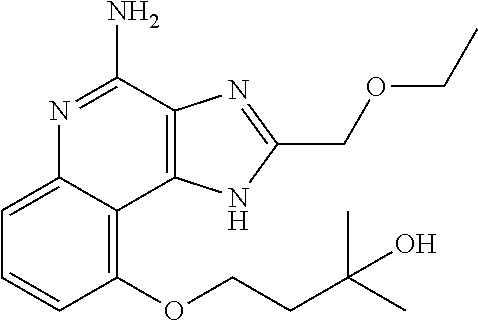
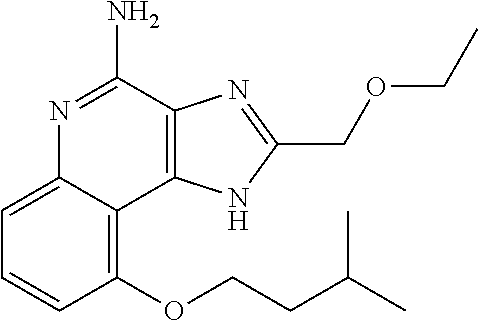
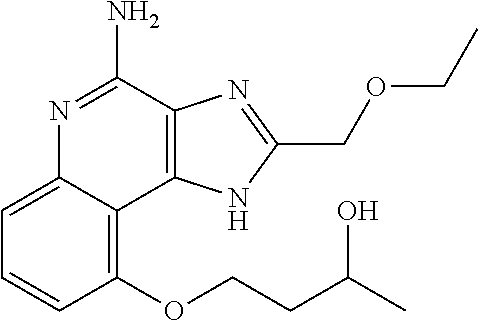
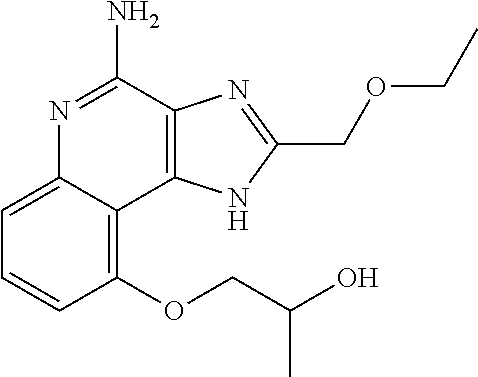


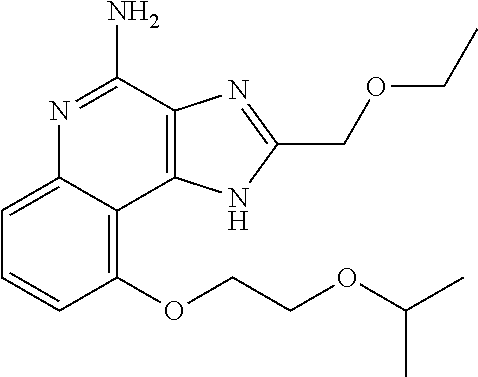


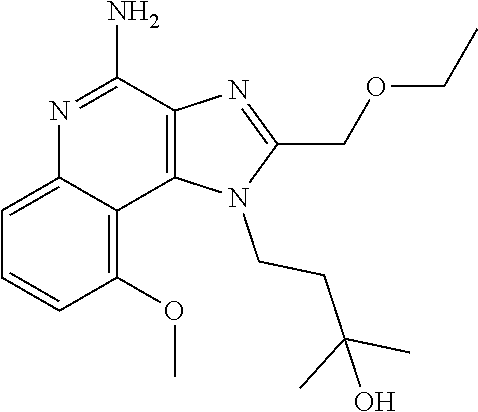
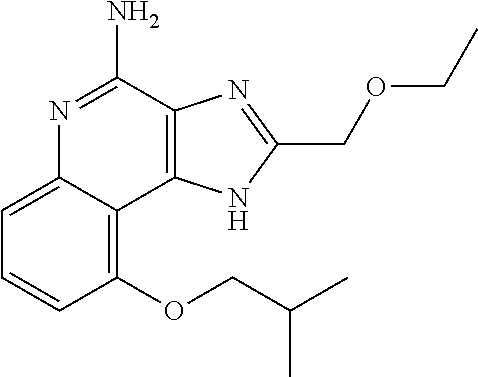
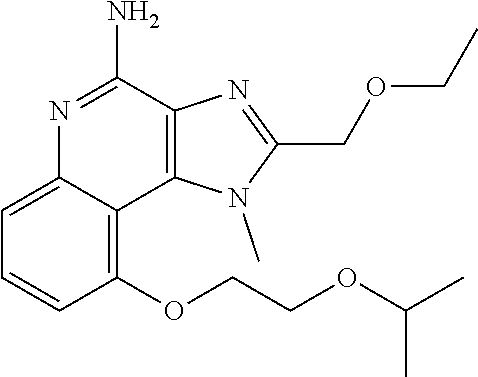
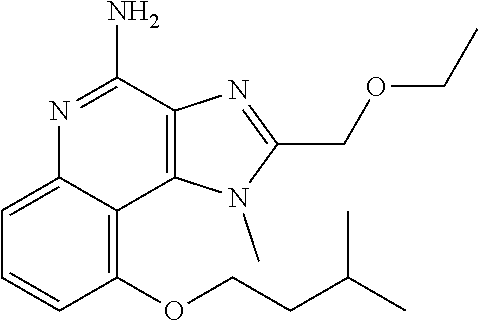

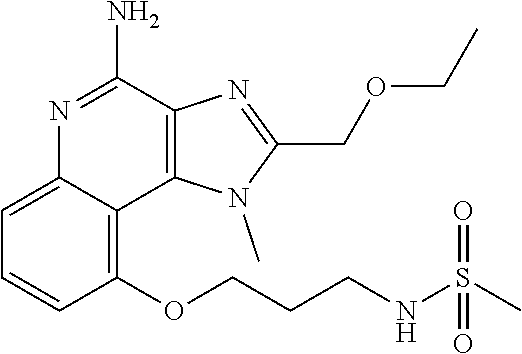




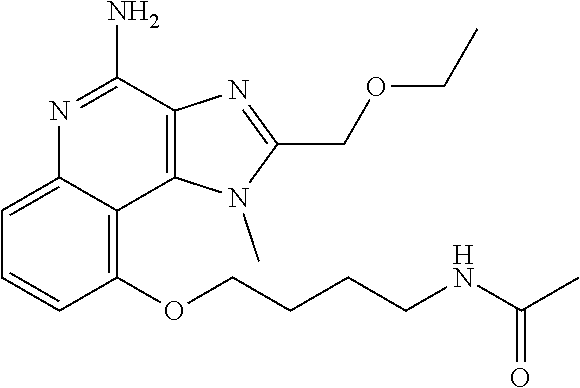

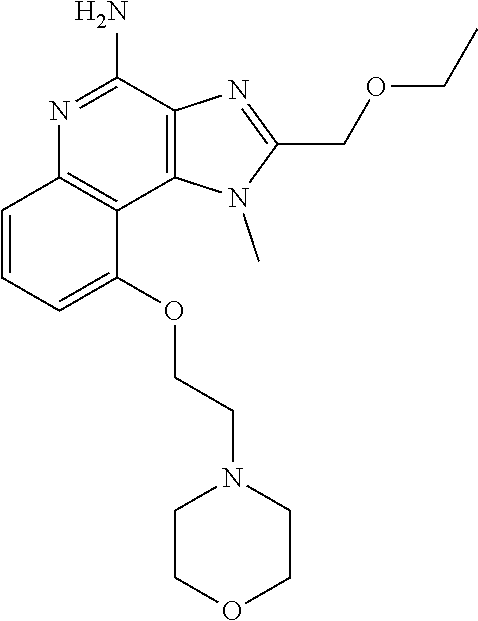



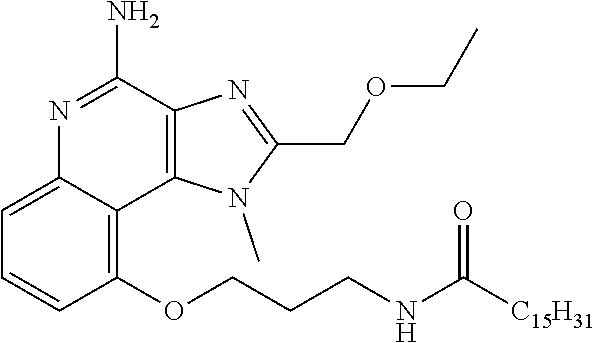

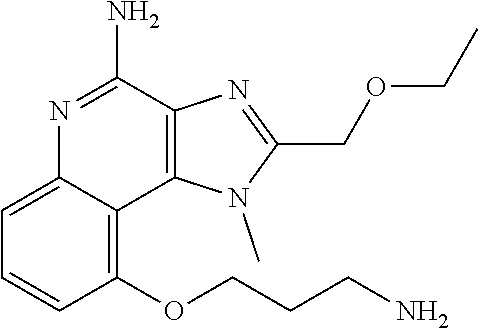

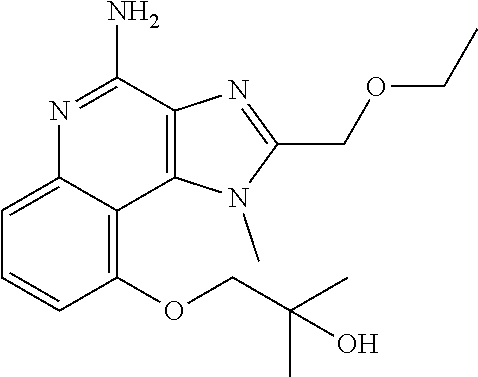




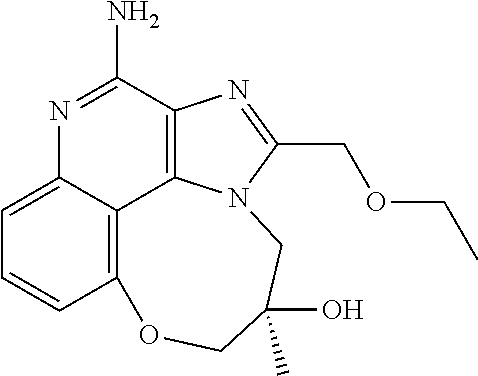
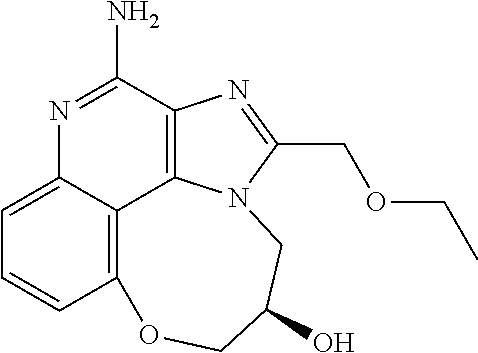

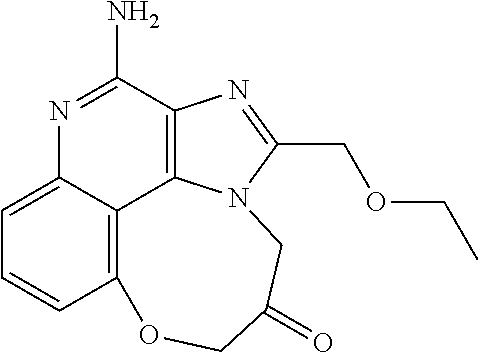
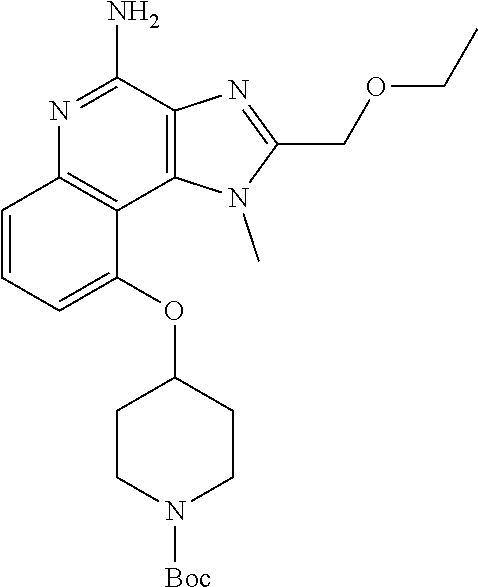
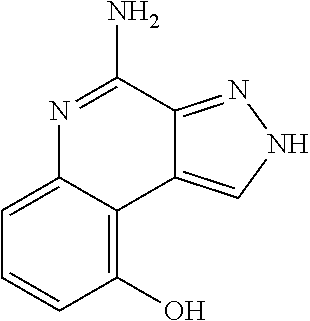

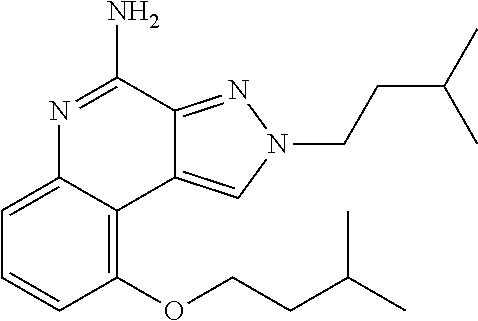
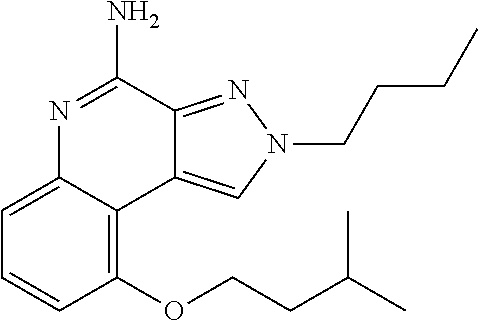










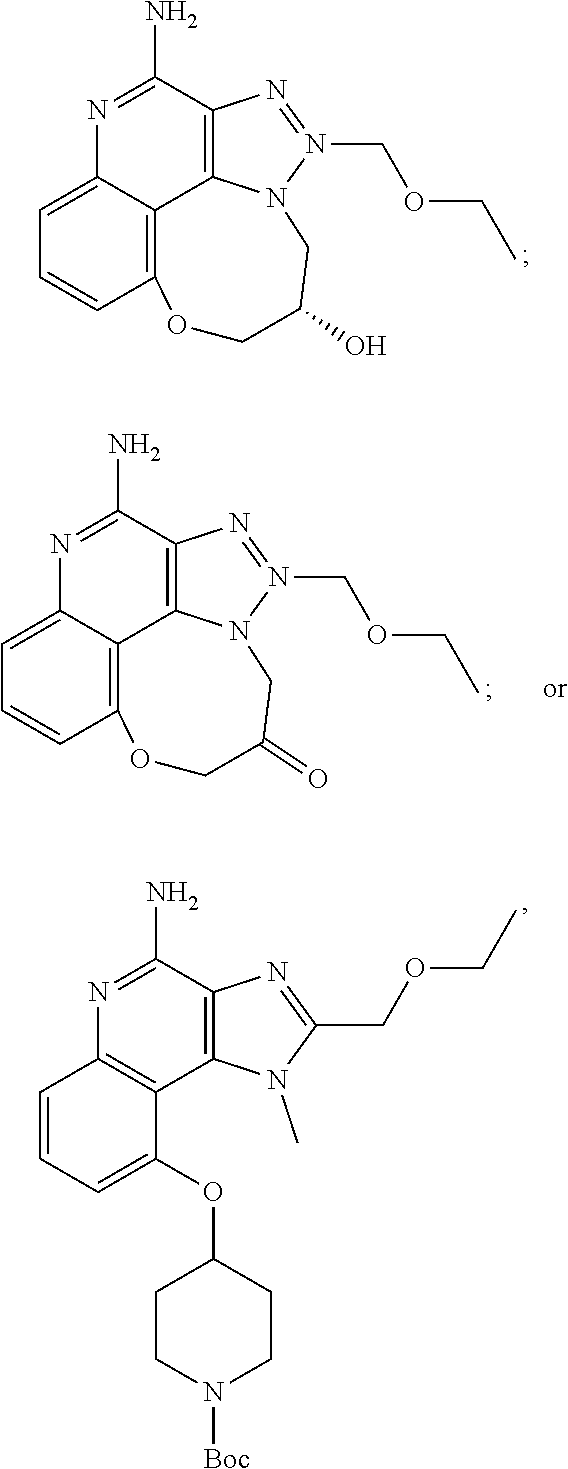


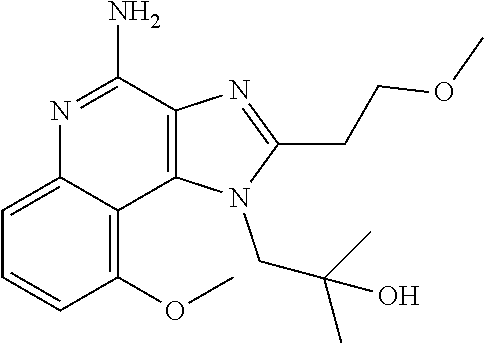



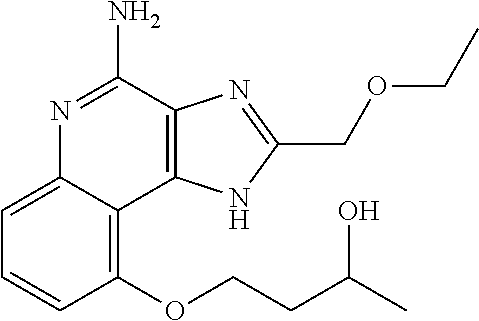



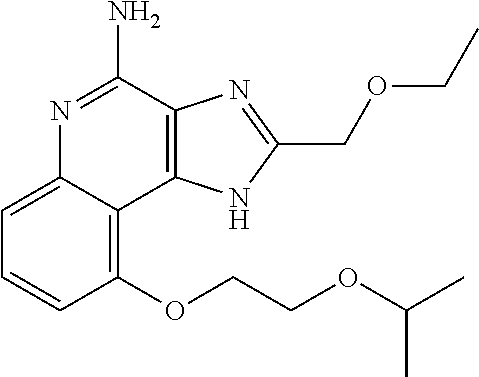


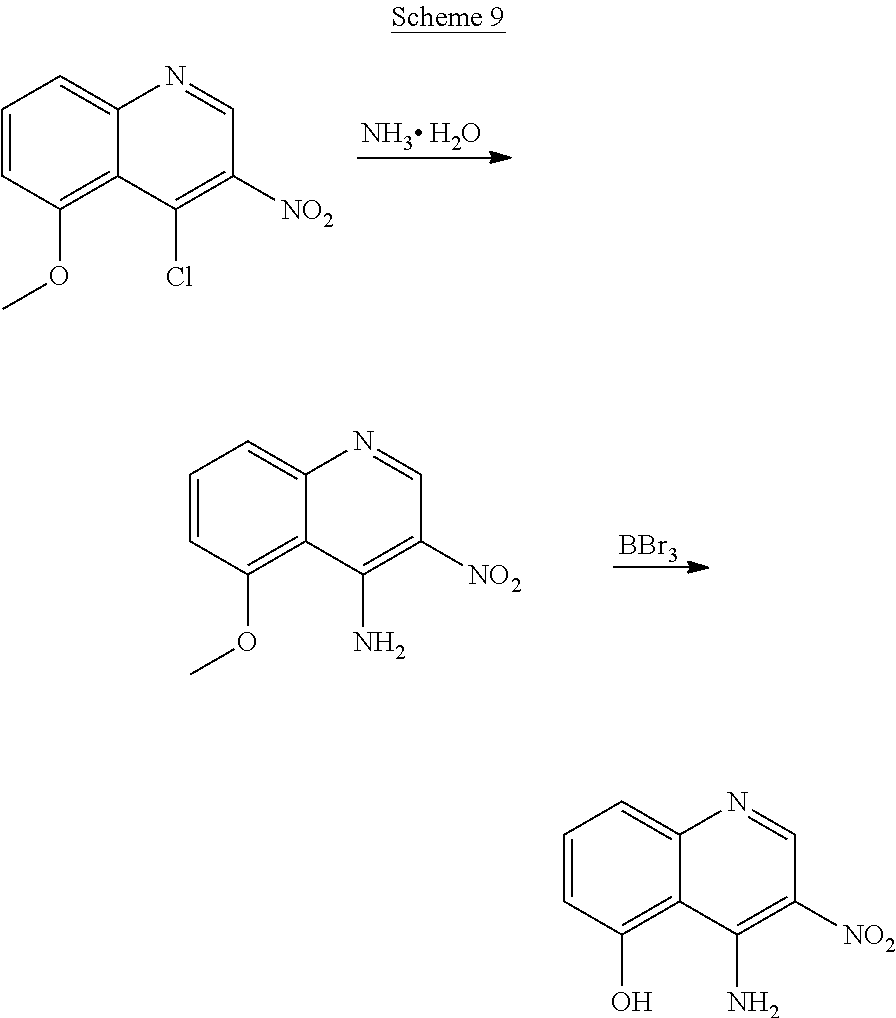


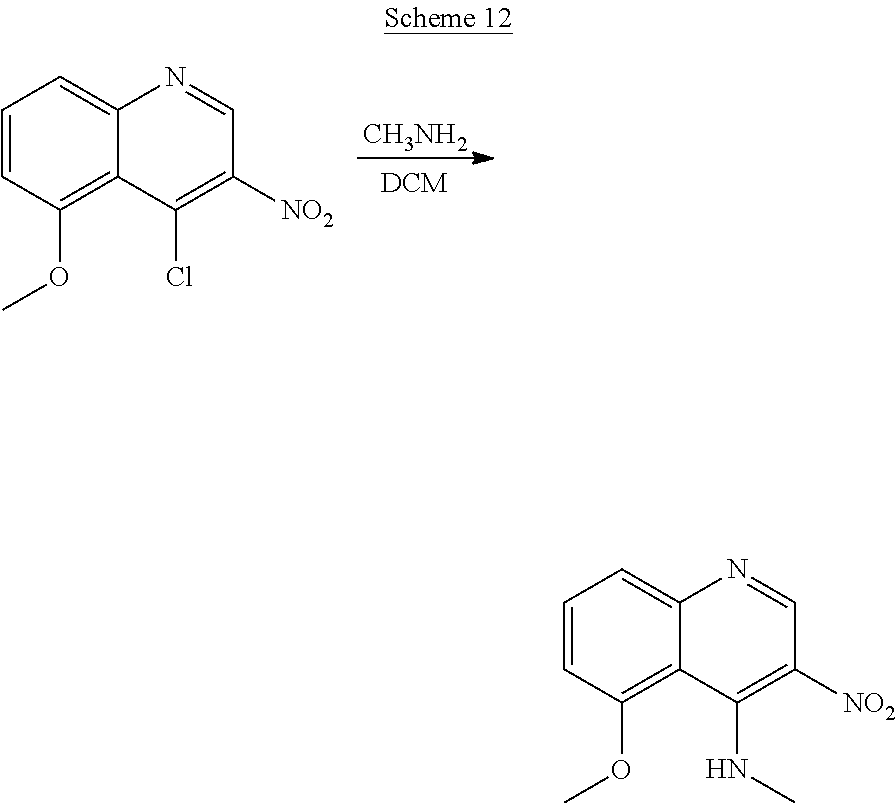

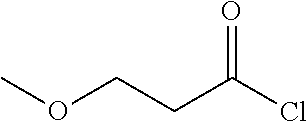
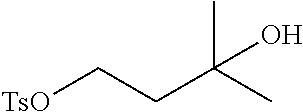
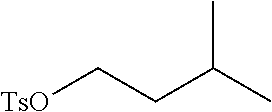

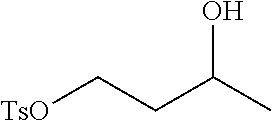
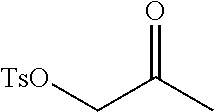
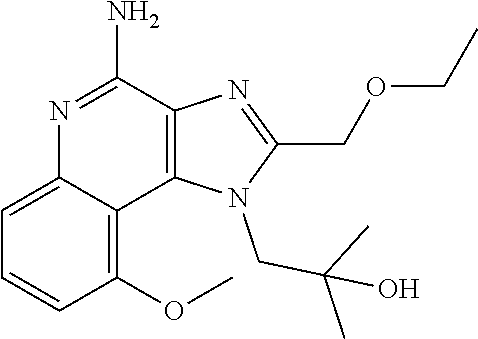




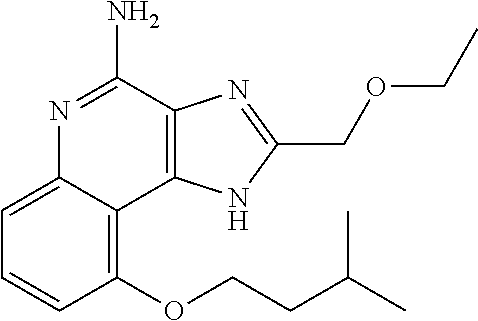
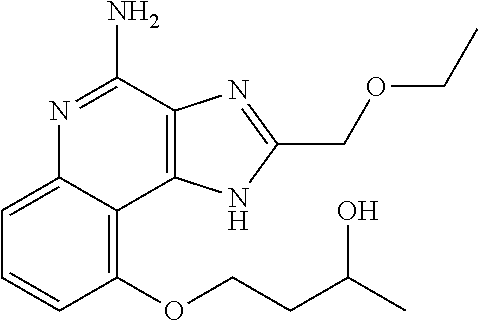
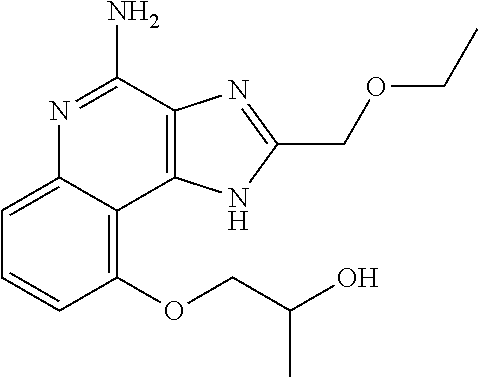


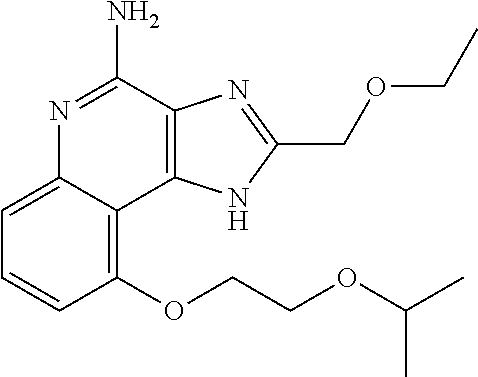
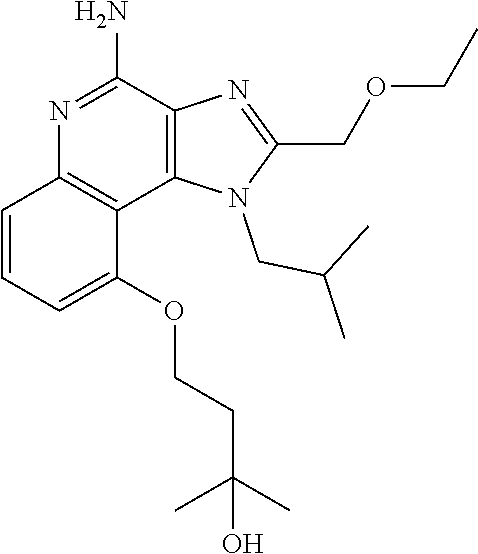

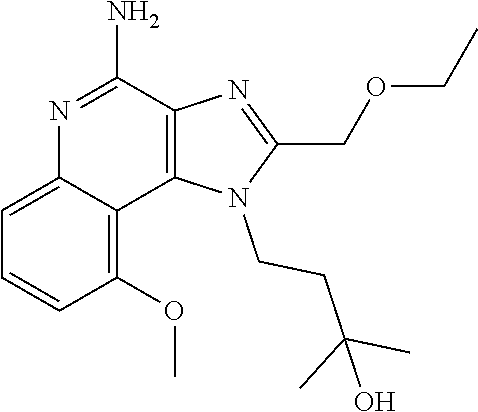
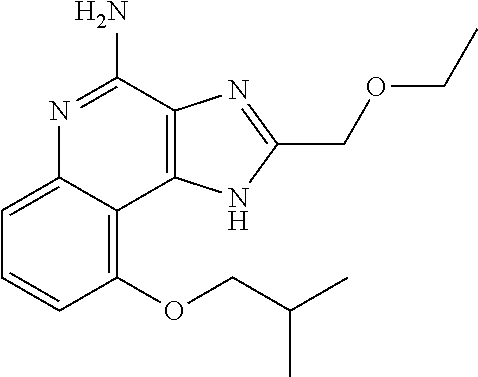

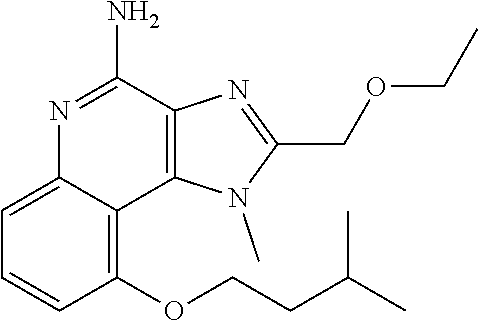

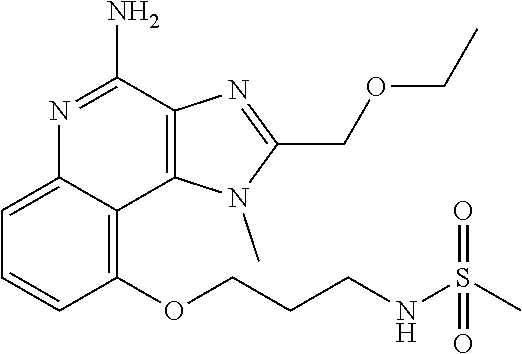

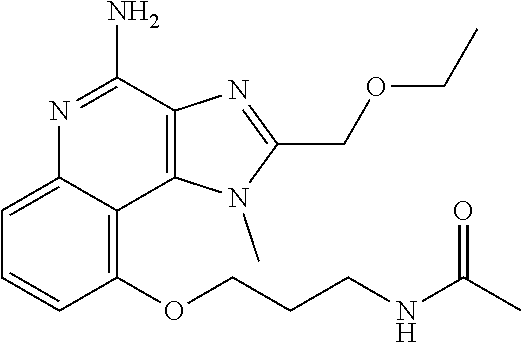
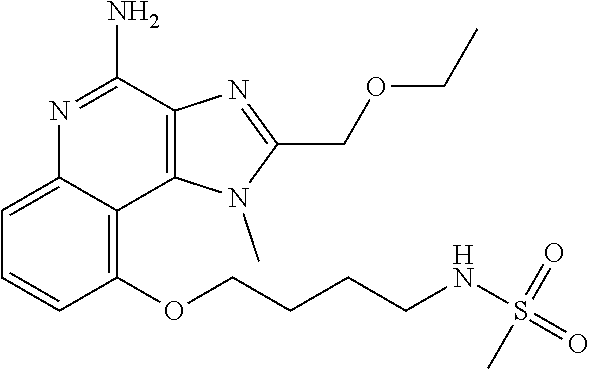
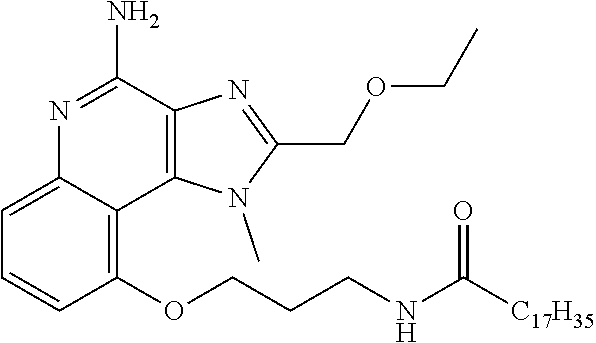
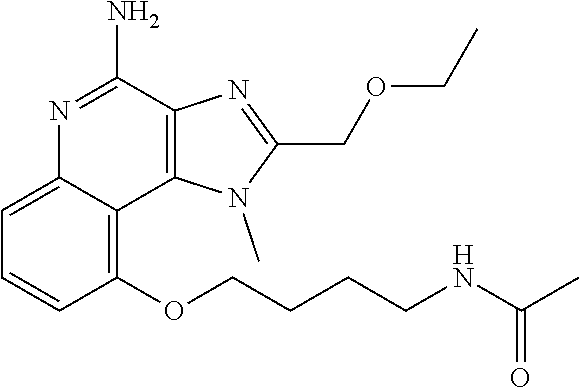
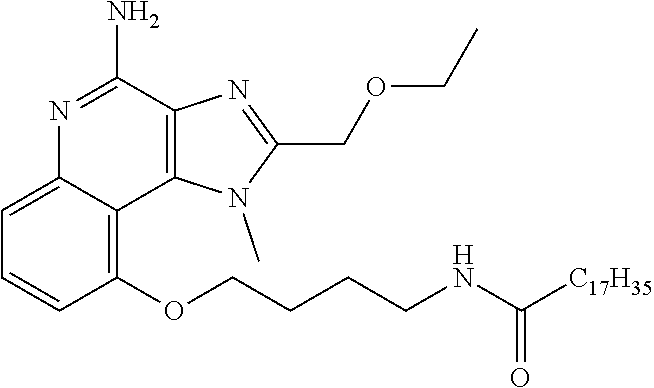



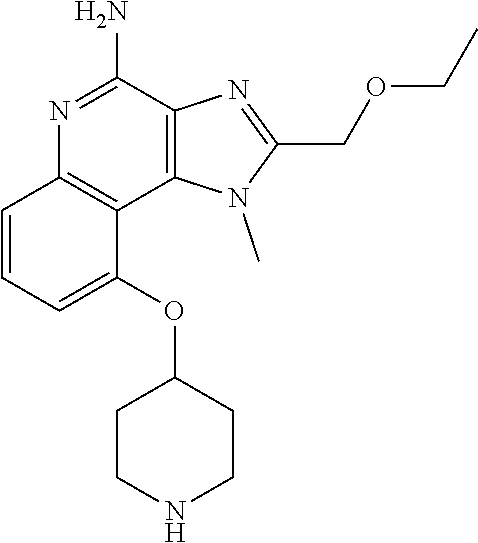

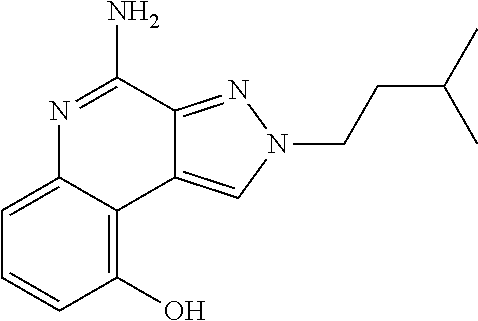



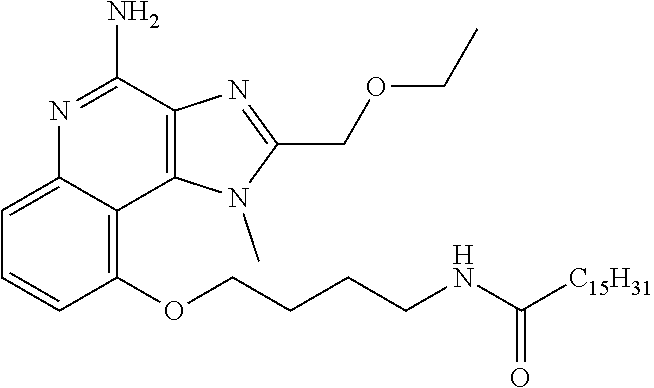
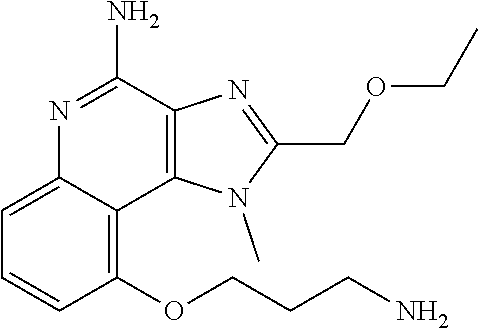


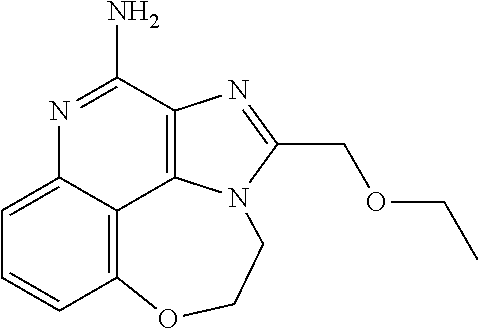
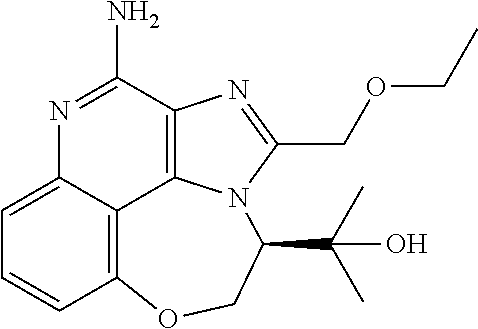


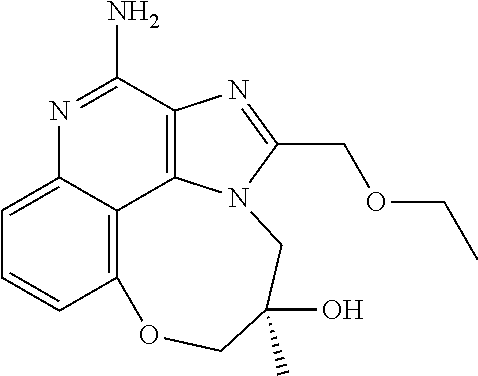

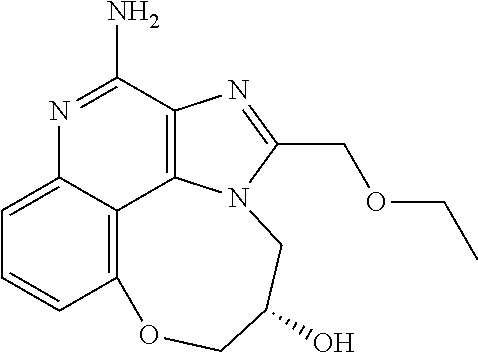





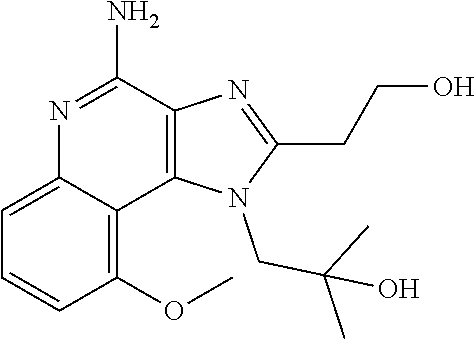


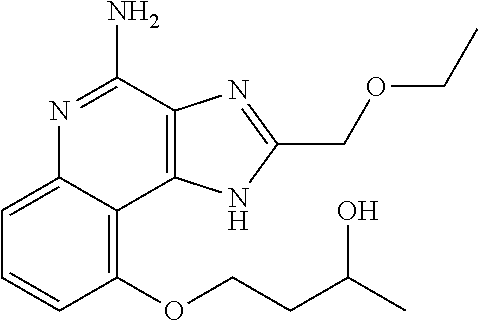

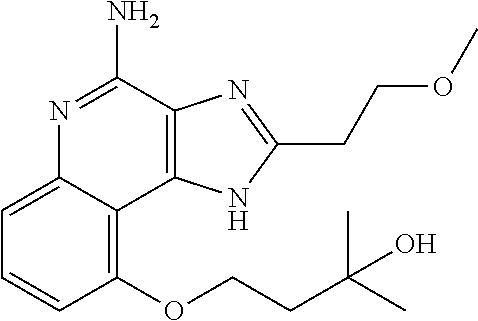
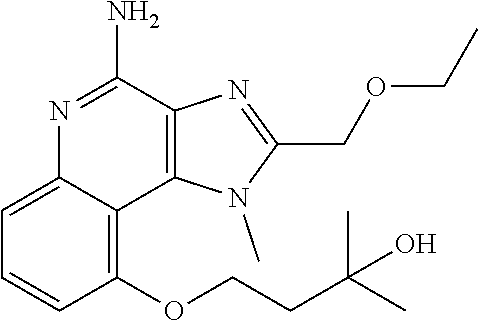





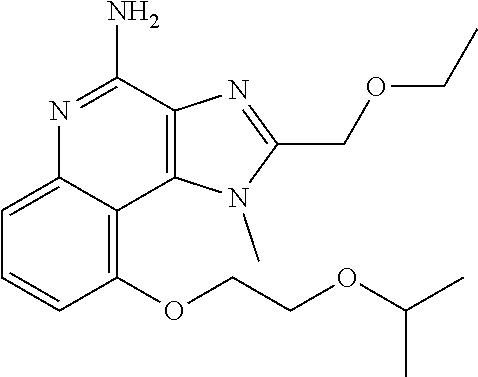
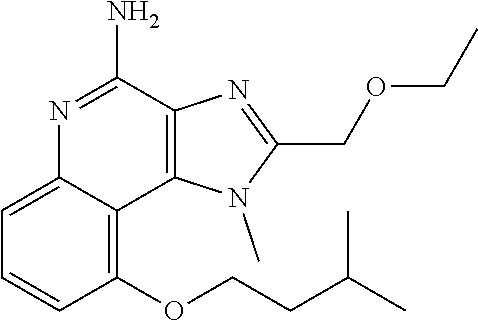
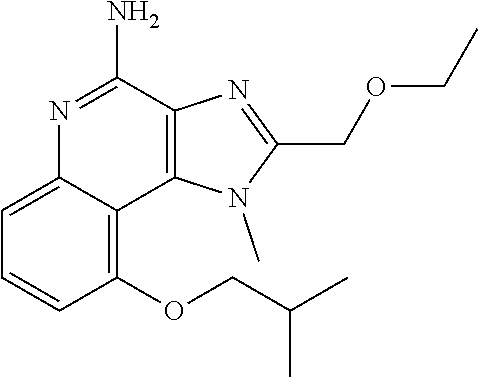



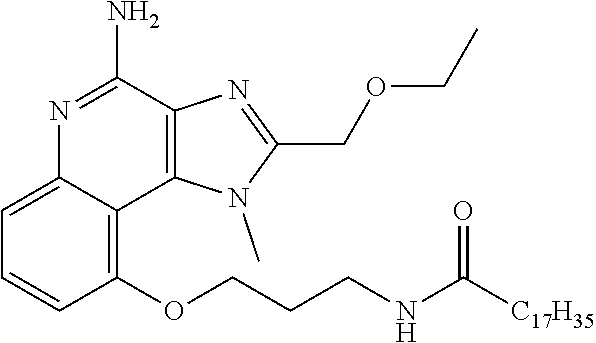

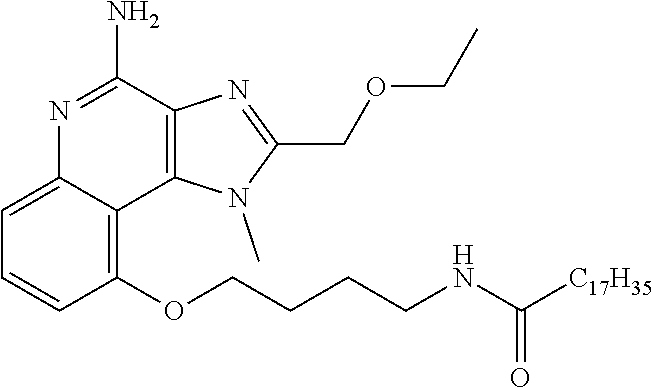


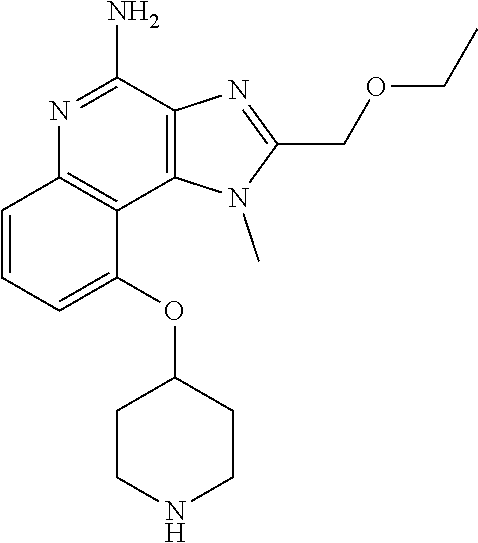




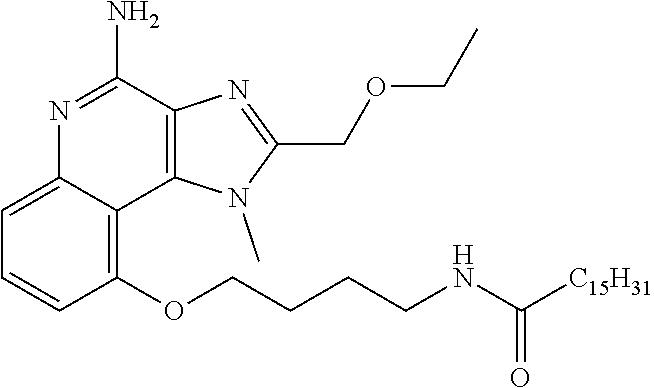
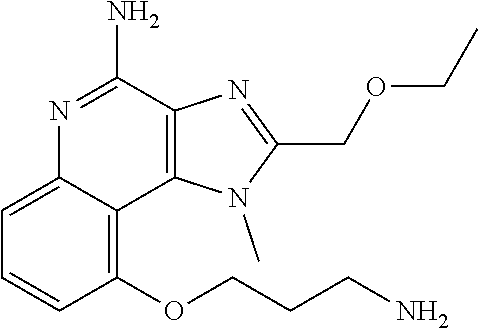
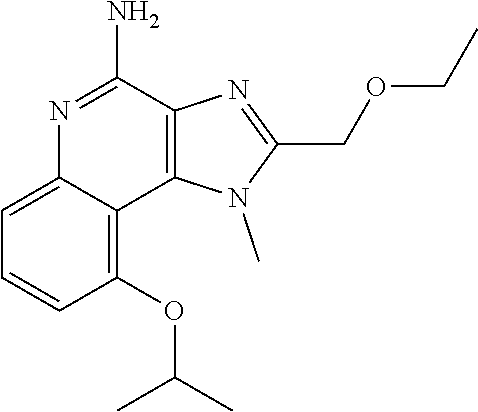


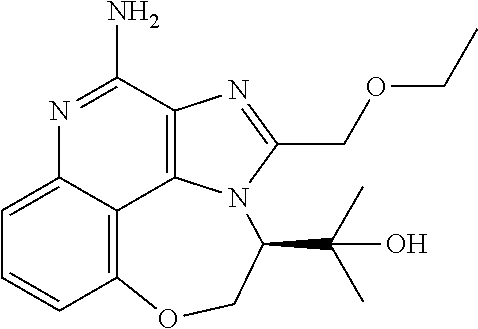
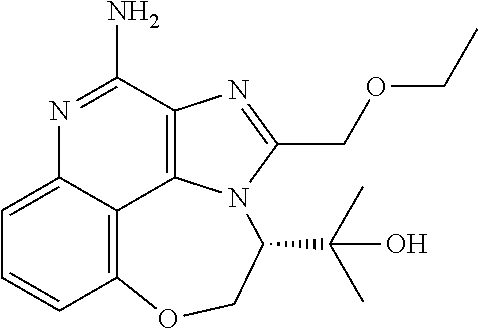




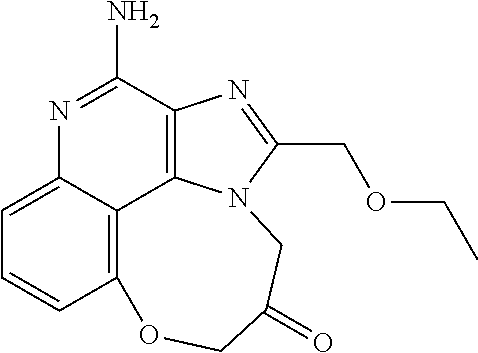
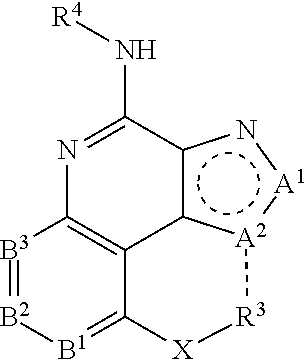

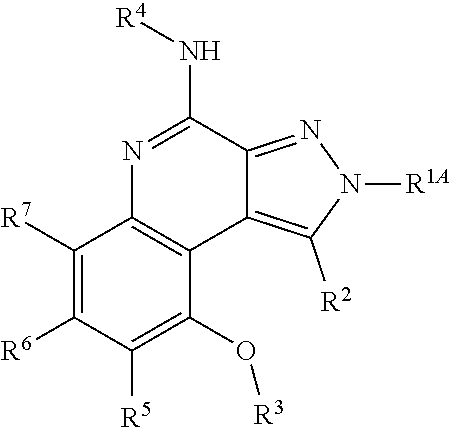








XML
uspto.report is an independent third-party trademark research tool that is not affiliated, endorsed, or sponsored by the United States Patent and Trademark Office (USPTO) or any other governmental organization. The information provided by uspto.report is based on publicly available data at the time of writing and is intended for informational purposes only.
While we strive to provide accurate and up-to-date information, we do not guarantee the accuracy, completeness, reliability, or suitability of the information displayed on this site. The use of this site is at your own risk. Any reliance you place on such information is therefore strictly at your own risk.
All official trademark data, including owner information, should be verified by visiting the official USPTO website at www.uspto.gov. This site is not intended to replace professional legal advice and should not be used as a substitute for consulting with a legal professional who is knowledgeable about trademark law.